
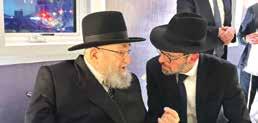








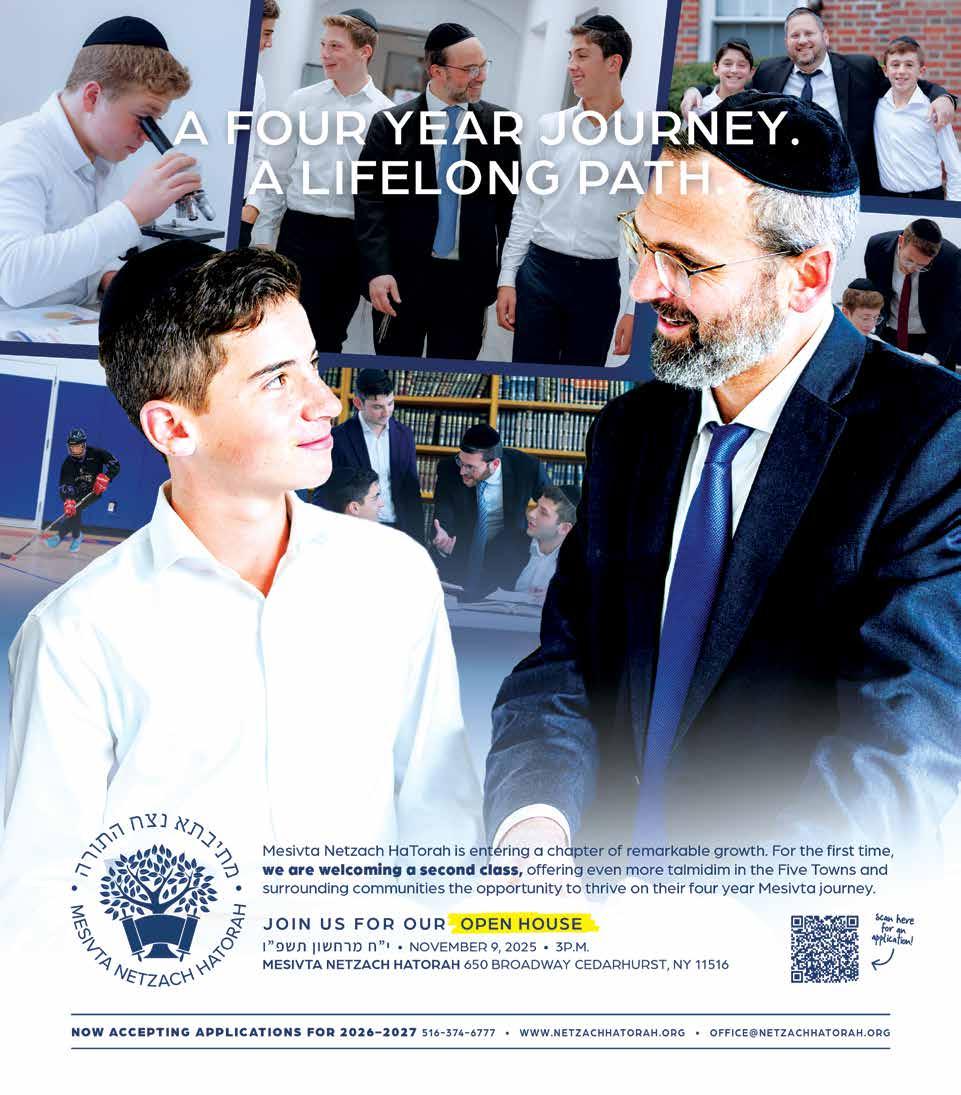


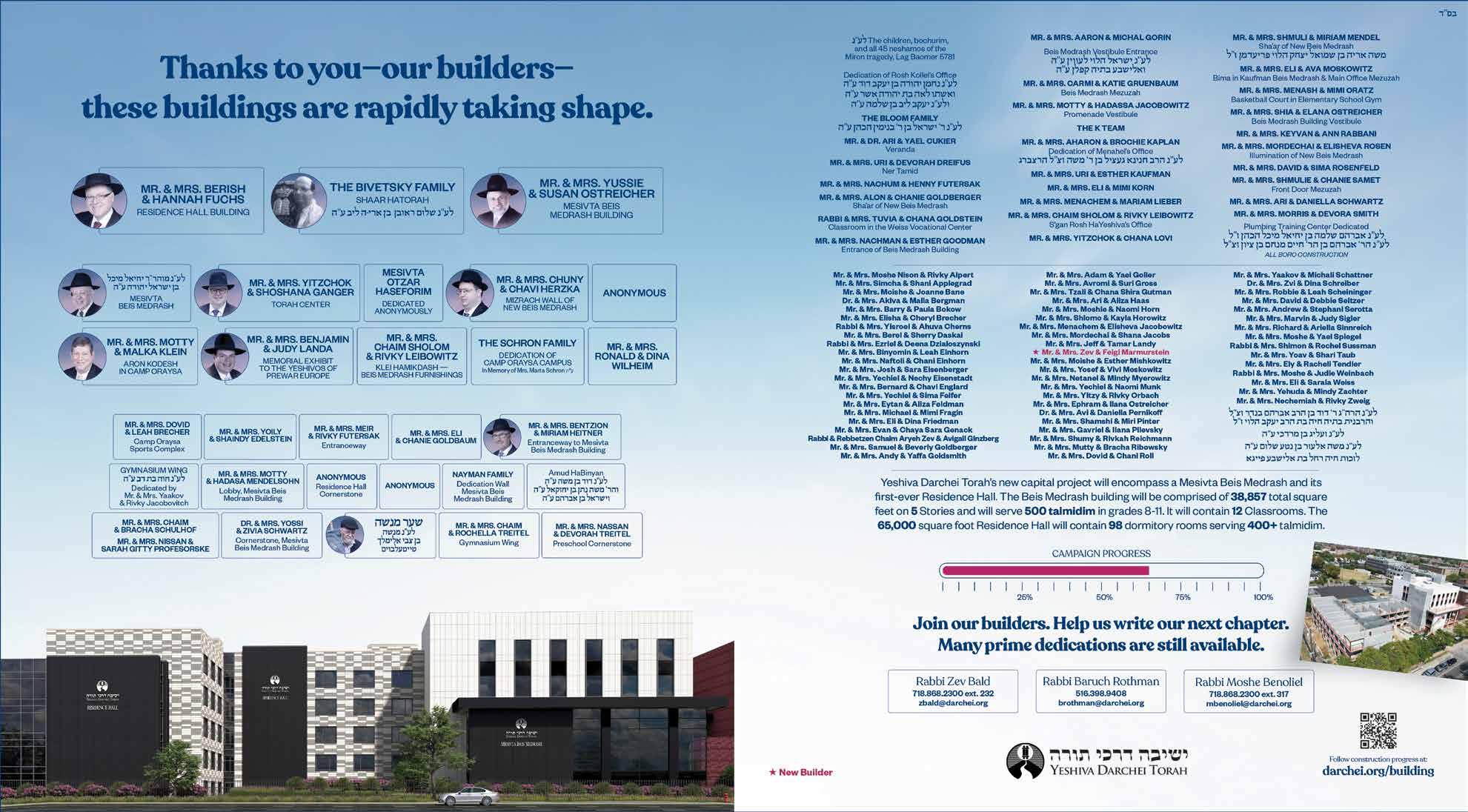

















Viktor Frankl once wrote, “When a person can’t find a deep sense of meaning, they distract themselves with pleasure.”
Perhaps this has been the source of the hedonistic pursuit of the past few generations. Western society has been futilely trying to distract itself from the emptiness of its existence by chasing the elusive pleasures of the world. But endless consumption doesn’t lead to meaning or to happiness. It is a rat race of saltwater ingestion, a never-ending desire to accumulate more and more, which never leads to satiety.
Sadly, Western values creep into our society as well. As Jews, we naturally search for meaning. But we live in a world in which our values have been distorted. We give undue significance to the pursuit of physical possessions and experiences. We try to outdo each other, building bigger houses, throwing more extravagant parties, upping the ante to almost unattainable levels.
But once a year, we firmly put aside our materialistic marathons. For seven days, we sit ensconced in Hashem’s embrace. We step into a flimsy abode, with barely four walls, and we look towards the Heavens, the stars shining bright. Our existence reaches another level, and an understand-
ing of what our life’s mission really is about begins to dawn.
When we’re in the sukkah, priorities become clear. Foremost is our connection to our Creator, a relationship that deepens when we spend time uplifting His commandments and doing His will. We reinvigorate our relationship with ourselves, our families, our fellow Jews. And while we’re doing so, we recognize that those relationships are what will bring us true joy.
In our temporary homes, we are reminded that there is one thing in our lives that is never temporary or fleeting. It is our faith in G-d that has traveled with us through the long travails of galus over the many years since we first stepped into His Clouds of Glory. Our lives take on a prism of meaning as we understand that a life of substance can be found everywhere where He is found, everywhere where we bring Hashem into our lives.
Sukkos, Zman Simchaseinu, helps to remind us that a person’s ultimate pleasure is living a life of meaning and faith and then bringing those lessons of the rickety walls into our every day.
Wishing you a beautiful yom tov, Shoshana

Yitzy Halpern, PUBLISHER publisher@fivetownsjewishhome.com
Yosef Feinerman, MANAGING EDITOR ads@fivetownsjewishhome.com
Shoshana Soroka, EDITOR editor@fivetownsjewishhome.com
Nate Davis
Editorial Assistant
Nechama Wein Copy Editor
Rachel Bergida
Shana Brecher
Lani White
Design & Production
Gabe Solomon Distribution & Logistics
P.O. BOX 266
Lawrence, NY 11559
Phone | 516-734-0858
Fax | 516-734-0857
Classified Deadline: Monday 5:00PM classifieds@fivetownsjewishhome.com text 443-929-4003
PAYMENT VIA CREDIT CARD MUST BE SUBMITTED ALONG WITH CLASSIFIED ADS
The Jewish Home is an independent weekly magazine. Opinions expressed by writers are not necessarily the opinions of the publisher or editor. The Jewish Home is not responsible for typographical errors, or for the kashrus of any product or business advertised within. The Jewish Home contains words of Torah. Please treat accordingly.











Dear Editor,
I have to respond to the mother’s heart wrenching letter in The Jewish Home this week. This young woman is in much pain – and understandably so. Her children have not been accepted into local schools and her heart hurts for them as they go to public school every day.
No Jewish child should feel rejected. No Jewish child should feel excluded or unloved or unwanted.
To the mother: I feel your pain. I am davening for you and for your child. You are a warrior for your children, a lioness. Keep up your strength and your fierceness to protect your children. You are an amazing advocate, and your children are fortunate to call you “Mom.”
To her wonderful children: Know that there are people who feel your pain. Know that there are people who cry for you, who feel for you as you walk the halls of the public school and feel alone. Know that there are people who hurt for you as you keep your head down in between classes. We are davening for you. May Hashem bring you much success and redemption in the coming year and may we share in good news together this year.
Avigayil Lesser
Dear Editor,
I read the recent daitng column from the young woman dating a wonderful man whose family she finds “different,” and I wanted to share a perspective. First of all, it’s refreshing to hear her
appreciation of his good qualities and that she recognizes the importance of focusing on the person she is actually considering for marriage, rather than only the background noise. That said, I completely understand her concern—when we marry someone, we marry into their family, too. Their presence at simchos, Shabbos meals, and family gatherings will certainly be part of her life.
But here is the key: she needs to ask herself what she values most in a partner. Does she see in this young man the character traits she wants in a husband and father? If he is kind, responsible, and respectful, that ultimately outweighs quirks in the extended family. Families may be unusual, talkative, loud, or different, but those things don’t define a marriage. What does define a marriage is the relationship between husband and wife. If she feels genuinely uncomfortable around his parents, she should be honest with herself about her tolerance level. Every marriage involves compromises— whether it’s in-laws, finances, or lifestyle. This may be her “test” of whether she can build her own home while respecting, though not necessarily copying, the family she is marrying into.
At the same time, I would remind her that “different” is not synonymous with “bad.” Sometimes people who are unconventional or socially atypical bring warmth, sincerity, and authenticity. It may be worthwhile to view them through
Continued on page 16
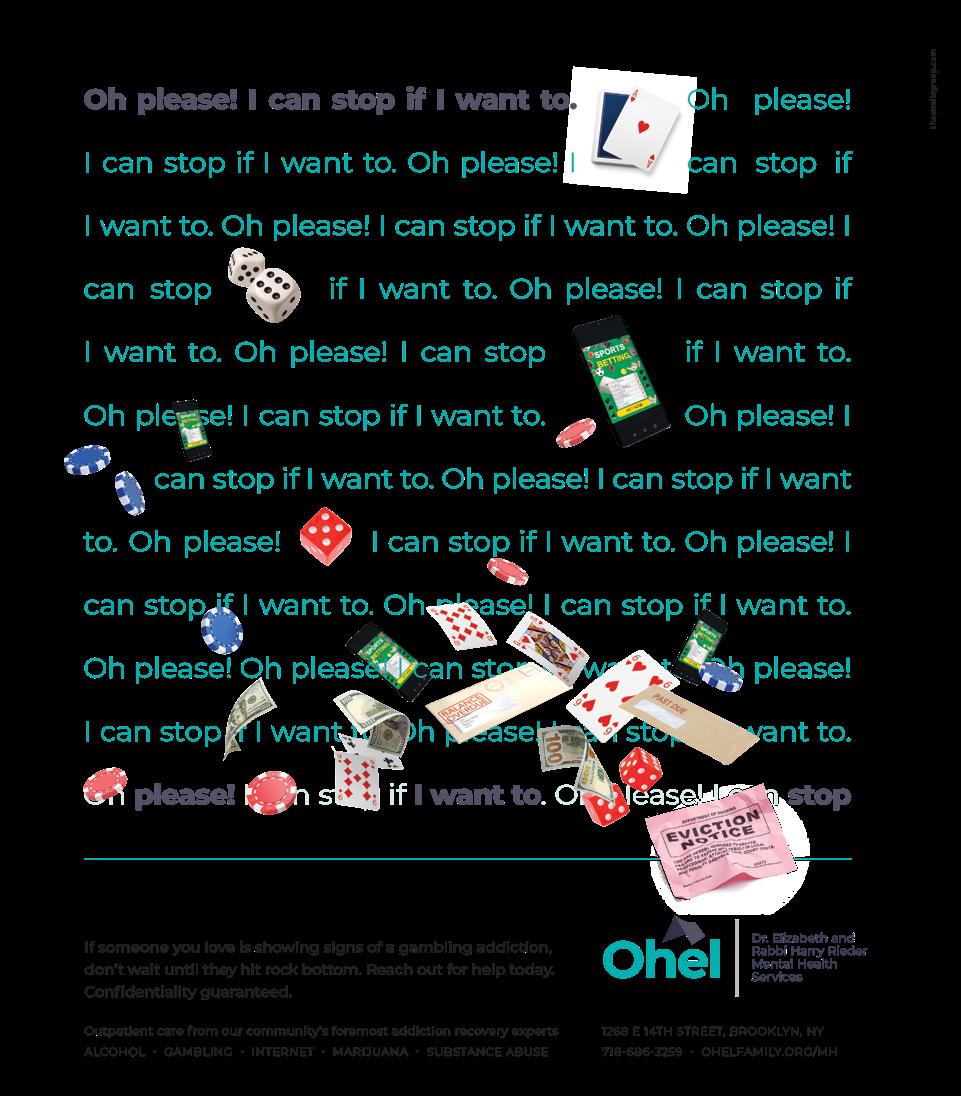



a gentler lens and not through the filter of other people’s labels.
My advice: if she truly values this young man, she should focus on building their relationship and strengthening their connection. In-laws will always be part of the picture, but the primary unit is the couple themselves. If she feels she can create healthy boundaries and accept the family as they are—without making them the centerpiece of her life—then this could be a marriage worth pursuing.
Rena Stein
Dear Editor,
I may be the only person to say this, but I feel it has to be said.
Charlie Kirk was a wonderful person. He was a strong advocate for the Jews and for Israel. That being said, we should not idolize this young man. Yes, he was a man of values. We should appreciate that he was a friend of ours and that he fought for the Jewish people. But we should also remember that our true values lay in Torah. Make those people your role models in your life.
Shaya L.
Dear Editor,
You recently featured an article about a person who is fighting antisemitism online. I was truly intrigued by the piece. What was most interesting to me was how AI and technology are being used to combat this form of hate. AI has been getting a really bad reputation – and for many good reasons. But we need to look at everything in this world and see if it can be
used for good things.
This person clearly has done that. She is taking AI and using it to comb through scores of websites and forums to ensure that antisemitism is being curbed. There is no way to do this with just human involvement. By using AI, she can search through thousands of websites a day. And she can help to start antisemitism in its tracks (ironically, some of what she is stopping was put up by other AI algorithms – so it’s AI against AI in the cyberworld!).
Yoni Heller
Dear Editor,
As we rush along preparing for Yom Kippur, we should bring zechusim with us to the Yom Hadin.
Please keep in mind the people in our community who may feel lonely on yom tov. Please invite them for a meal on Sukkos. Please keep them in mind over chol hamoed, too! Invite them for a meal then so they don’t have to scrounge around looking for a meal when it’s not yom tov and when many people forget about them.
Remember the couple who doesn’t yet have children or whose children are all married and no longer living with them. Remember the man who lost his wife or the woman who never married or the person who is divorced. Think about the baalei teshuva or the people from out of town communities.
In that zechus, you should have a happy home that is welcoming to all!
R. Gerber



Need a great airport to fly in and out of? Consider London Heathrow, which is the world’s top megahub for travelers needing to connect to different flights in a jiffy. The airport held onto the top spot on Megahub’s 2025 report that was released last Wednesday by travel data platform OAG.
Istanbul jumped from eighth place to No. 2 this year, while Amsterdam Schiphol climbed from No. 4 to No. 3. Frankfurt skipped from No. 10 to share fourth place with Kuala Lumpur, last year’s No.2.
The Malaysian megahub isn’t the only Asian airport to lose ground in the connectivity race: Seoul Incheon dropped from No. 5 to No. 6 and Tokyo Haneda slipped six places, from No. 3 to No. 9.
The U.S., by contrast, made gains. Chicago O’Hare, which has added 15 new destinations, jumped two places to become the seventh most connected airport worldwide. Atlanta Hartsfield-Jackson, already the world’s largest airport by seat capacity, reentered the global top 10, climbing from No. 11 to No. 8.
Further down the ranking, they’re doing things bigger in Texas. Dallas FortWorth rose five places from No. 18 to No. 13, and Houston’s George Bush Intercontinental Airport jumped all the way from No. 29 to No. 18.
Safe travels.
Former French President Nicolas Sarkozy was sentenced on Thursday to five years in prison on charges of criminal conspiracy to seek funding for his 2007 election campaign from the government of Col. Muammar el-Qaddafi, the
then-dictator of Libya.
Sarkozy was sentenced by a court in Paris, which ruled that his prison sentence would begin in the next few weeks, even if he appeals. Following the ruling, Sarkozy told reporters, “If they absolutely want me to sleep in prison, I will sleep in prison but with my head high.”
“Those who hate me so much think that they are humiliating me,” Sarkozy said. “[But] those they have humiliated are France and its image.”

Sarkozy, a 70-year-old conservative, branded the three-month trial a “scandal,” rejected the allegations as false, and vowed to appeal. He served as president from 2007 to 2012. Sarkozy is set to become France’s first former president to serve time in prison. Aside from Jacques Chirac, who was found guilty in 2011 of misusing public funds as Paris’ mayor, Sarkozy is the first former French president or prime minister to be convicted by a court since 1945.
According to prosecutors, Sarkozy played a key role in a “Faustian corruption pact” with the Libyan government. In exchange for shady contributions to his 2007 campaign, he promised economic deals, diplomatic recognition, and potential assistance in undoing an arrest warrant against el-Qaddafi’s brother-inlaw, Abdullah Senoussi, who bombed a French airliner in 1989, killing 171 people.
Prosecutors failed to prove that Sarkozy actually obtained or used the money in question. Thus, he was found not guilty on charges of illegal campaign financing, concealing the misappropriation of public funds, and passive corruption. However, he was still found guilty of conspiring to engage in “corruption at the highest possible level,” as presiding Judge Nathalie Gavarino put it.
“These facts make it necessary to impose a prison sentence,” said Gavarino. The former president of France was sentenced to five years, even though prosecutors sought a seven-year sentence.
Sarkozy has claimed that the allegations were falsely promoted by el-Qaddafi’s vengeful allies. In 2011, el-Qaddafi was killed in a rebellion that was sparked by NATO-led airstrikes, which were led by France under Sarkozy’s orders.
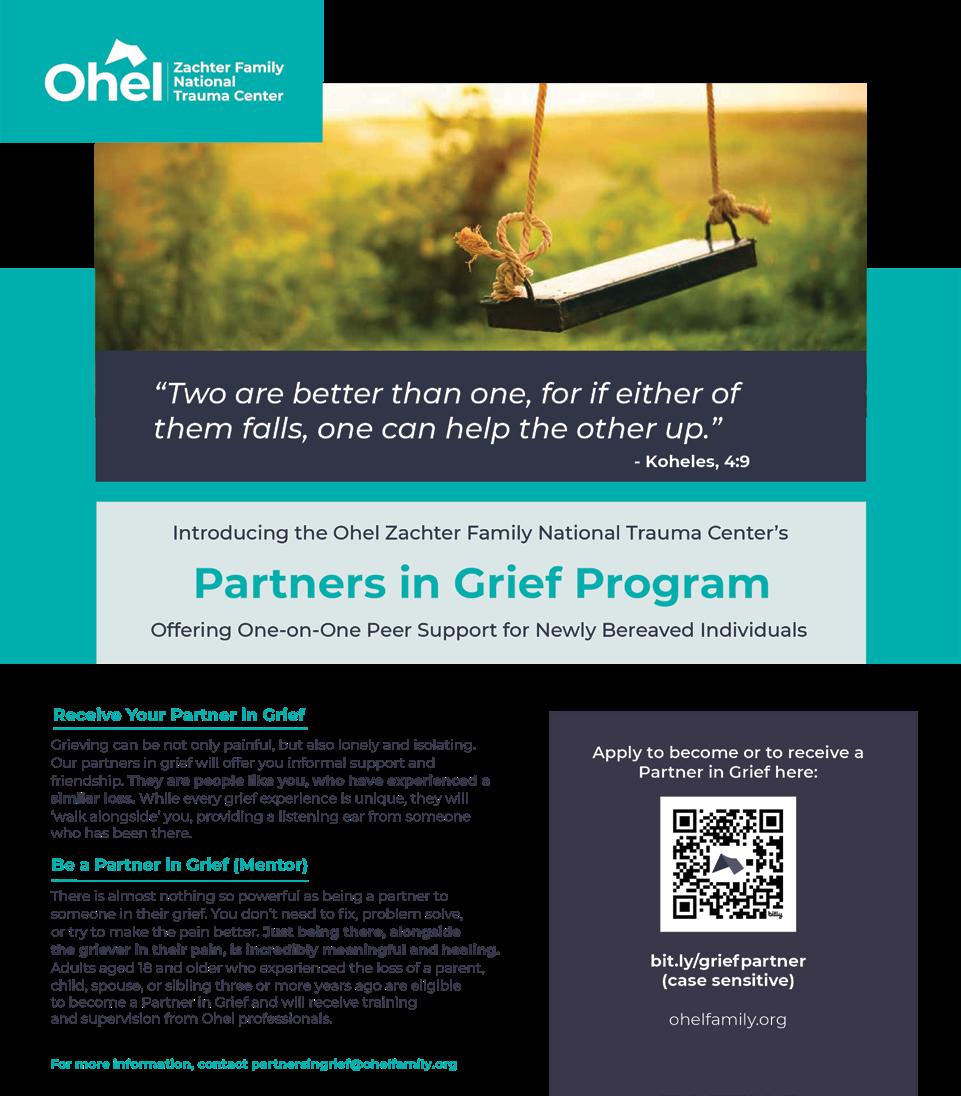
20 Sarkozy has previously been convicted of corruption, influence peddling, and campaign spending violations. His Legion of Honor award, which is France’s highest distinction, was at one point rescinded. In 2021, he was convicted of attempting to obtain information from a judge about a trial against him and was sentenced to a year of house arrest. After several months, he turned 70, which allowed him to request conditional parole. That same year, a court found him guilty of illegally financing his failed 2012 re-election bid, though that case is still being appealed.

At least forty people died in a stampede at a rally on Saturday hosted by Joseph “Vijay” Chandrasekhar, a famous
Indian actor-turned-politician.
The rally — which was held in Karur, a district in the Indian state of Tamil Nadu — drew tens of thousands of Vijay’s fans, despite the intense heat. In Tamil Nadu and other southern Indian states, famous actors are often worshipped, with many successfully running for public office. Vijay, one of the state’s top actors, is running in the 2026 state elections.
At least 124 people are being treated in hospitals, most of whom are in stable condition. Of the 40 fatalities, nine were children. Thirty-six people were already dead by the time they reached a hospital.
According to an individual who attended the rally, Vijay showed up six hours after he said he would. The individual said that a number of attendees “fainted as he addressed the rally. Vijay halted the speech and called in an ambulance to help them.” Another witness said that Vijay, at a certain point, threw water bottles into the crowd while standing on his campaign vehicle.
“When he decided to leave and his vehicle started moving, commotion broke out as hundreds of his fans and supporters chased his vehicle,” said R. Rajendaran, a local lawyer. “That is what led to the stampede.”
The state’s Chief Minister M.K. Stalin


said the families of the deceased would be given $11,000 each.
In 2024, Vijay stopped acting and started a political party called Tamilaga Vettri Kazhagam.
“My heart is shattered,” Vijay said in a post on X. “I am writhing in unbearable, indescribable pain and sorrow that words cannot express.”

United Nations sanctions against Iran were reinstated overnight on Sunday shortly after Britain, France, and Germany triggered the 2015 nuclear deal’s “snapback” mechanism as punishment for Iranian noncompliance. In response, Iran has declared the sanctions “unjustifiable.”
“The reactivation of annulled resolutions is legally baseless and unjustifiable…all countries must refrain from recognizing this illegal situation,” said Iran’s foreign ministry. “The Islamic Republic of Iran will firmly defend its national rights and interests, and any action aimed at undermining the rights and interests of its people will face a firm and appropriate response.”
Israel celebrated the reinstatement of the sanctions, branding them a “major development in response to Iran’s ongoing violations, especially on its military nuclear program.”
Iran’s parliament is considering withdrawing from the Nuclear Nonproliferation Treaty in retaliation. Parliament speaker Mohammad Bagher Qalibaf, on Sunday, threatened UN member states that enforce the sanctions.
“We announce that if any country wants to take action against Iran based on these illegal resolutions, it will face serious reciprocal action from Iran, and the three European countries that are the initiators of this illegal action will also face our reaction,” said Qalibaf.
“It will have some damages, some losses for us,” Iranian Foreign Minister Abbas Araghchi said. “However, they have presented it in their own media as something far greater and much bigger
than it actually is, and they have tried to create a monster to frighten the Iranian people and then force our government and our foreign policy to give concessions and pay tribute in this regard.”
The sanctions come after months of failed talks that ended in June, when the United States and Israel struck Iran’s nuclear facilities with bombs.
Western officials have urged Iran to return to the negotiating table.
On Friday, Russia and China, two allies of Iran, tried delaying the sanctions until April but failed to garner enough support for the measure in the Security Council.
Russian Foreign Minister Sergei Lavrov said Moscow would not implement the sanctions, which he said “finally exposed the West’s policy of sabotaging the pursuit of constructive solutions in the UN Security Council, as well as its desire to extract unilateral concessions from Tehran through blackmail and pressure.”
Despite enriching uranium to unnecessary levels, blocking international officials from inspecting its nuclear facilities, and vowing to destroy Israel, Iran claims that it does not want nuclear weapons.

Moldova, an Eastern European country and former Soviet republic, held elections over the weekend in which the ruling pro-Western party won a decisive victory and a majority in parliament.
Before the vote, President Maia Sandu warned that Russia had spent “hundreds of millions of euros” in a bid to sway the result, seen as crucial for the former Soviet state’s future path to the European Union.
But after all votes were counted on Monday, Sandu’s Party of Action and Solidarity (PAS) secured more than 50% of the vote, far ahead of the pro-Russian opposition Patriotic Bloc with under 25%.
Igor Dodan, head of the Patriotic Bloc and Sandu’s predecessor as president, called for protests on Monday outside the parliament in the capital Chisinau.
Casting her vote Sunday, Sandu said there was “a lot at stake” for Moldova, and that she hoped the country “will have

the chance to continue to strengthen its democracy, to protect its space, and to continue its EU integration path.”
Sandu is targeting EU membership for Moldova within the next five years and warned of dangerous consequences if Russian influence prevailed in the country, which borders Ukraine.
Sandu, a Harvard-educated former World Bank official, won the presidential election by a landslide in 2020 and her party swept to power the next year, pledging to clean up corruption and improve governance. Its progress, however, was hampered by the security and economic crises which spilled over from Ukraine after Russia’s all-out invasion in 2022. Although Sandu won widespread praise for helping Moldova secure EU candidate status in 2022, some voters were frustrated with the pace of reform and spiraling gas prices, after Russia cut off supplies and Moldova sought new procurement deals with Romania.
Now, Sandu and her party have a mandate from the people, winning elections two times, despite claims of meddling by Russia.
Moldova, which won independence as the Soviet Union crumbled, was subject to a “tsunami” of Russian cash, cryptocurrency and disinformation, in a cam-
paign that aimed to bolster pro-Russian opposition, Nicu Popescu, Moldova’s former foreign minister, said. Moscow has denied any interference.
The results of the election show that “Russia has not achieved its objectives,” Sandu said in a news conference Monday.
“It has spent a lot of money in these elections, but the results show that they failed, and it failed because of the… joint efforts of the state institutions, of the media, of the press, of the civil society,” she said, adding that “we managed to resist this huge interference by Russia, and I’m actually very proud of the Moldovans.”
European leaders celebrated PAS’ victory. Ursula von der Leyen, the president of the European Commission, congratulated Moldovan voters.
“Moldova, you’ve done it again. No attempt to sow fear or division could break your resolve. You made your choice clear: Europe. Democracy. Freedom,” she said in a post on X. “Our door is open. And we will stand with you every step of the way. The future is yours.”

This week, Iran said that it hanged a man it accused of spying for Israel.
Bahman Choobiasl was the man executed by Tehran. His case wasn’t immediately known in Iranian media reports or to activists monitoring the death penalty in the Islamic Republic.
The execution came as Iran vowed to confront its enemies after the United Nations reimposed sanctions on Tehran over its nuclear program this weekend. The European Union followed suit on Monday, imposing similar sanctions on Iran.
Iran accused Choobiasl of meeting with officials from the Mossad, calling him the agency’s “most trusted” spy. Iran’s Mizan news agency, which is the judiciary’s official mouthpiece, said Choo-
biasl worked on “sensitive telecommunications projects“ and reported about the “paths of importing electronic devices.” Iran is known to have hanged nine people for espionage since its June war with Israel.
Earlier this month, Iran executed Babak Shahbazi, who it alleged also spied for Israel. Activists said that Shahbazi was tortured into a false confession after writing a letter to Ukrainian President Volodymyr Zelenskyy offering to fight for Kyiv.
Iran routinely conducts closed-door trials of those accused of espionage, with the suspects often unable to access the evidence against them.
Iran has faced multiple nationwide protests in recent years, fueled by anger over the economy, demands for women’s rights and calls for the country’s theocracy to change.
In response to those protests and the June war, Iran has been putting prisoners to death at a pace unseen since 1988, when it executed thousands at the end of the Iran-Iraq war.
The Oslo-based group Iran Human Rights and the Washington-based Abdorrahman Boroumand Center for Human Rights in Iran put the number of people executed in 2025 at over 1,000, noting




the number could be higher as Iran does not report on each execution.
Independent human rights experts at the United Nations also criticized Iran’s executions on Monday.
“The sheer scale of executions in Iran is staggering and represents a grave violation of the right to life,” the experts said. “With an average of more than nine hangings per day in recent weeks, Iran appears to be conducting executions at an industrial scale that defies all accepted standards of human rights protection.”

Thousands of people returned to the streets of Antananarivo, the capital of Madagascar, on Monday to protest against water and power cuts. Many called for the government to resign.
Inspired by protests in Kenya and Nepal, the demonstrations are the largest the Indian Ocean Island has seen in years and the most serious challenge President Andry Rajoelina has faced since his re-election in 2023.
Many protesters called for the resignation of Prime Minister Christian Ntsay, his government, and Rajoelina.
In response to the unrest, authorities declared a dusk-to-dawn curfew last Thursday after protests in Antananarivo turned violent.
Protesters on Monday gathered at a university in the capital where they waved placards and sang the national anthem before attempting to march through town.
The latest protests come after Rajoelina said on Sunday he would thoroughly review and reform the governance in the country.
“If there have been mistakes, I recognize them, and I am now looking for ways to correct everything,” he said in a speech in the Anosibe neighborhood of Antananarivo, where some looting and vandalism took place on Friday.
The protesters have adapted a flag used in Nepal where protesters forced the prime minister to resign this month and have also used similar online organiza-

tion tactics as protests in Kenya last year that culminated in the government scrapping proposed tax legislation.

Dozens of members of the Ming family were found guilty this week in China of conducting criminal activities, with many receiving substantial jail sentences. The clan ran scam centers in Myanmar. Eleven members of the family were sentenced to death.
The Ming family worked for one of the four clans that ran Myanmar’s town of Laukkai, close to the border with China, into a hub for gambling, drugs and scam centers.
Myanmar eventually cracked down on the scammers, arresting many members of these families in 2023 and handing them over to Chinese authorities.
A total of 39 Ming family members were sentenced on Monday in the eastern city of Wenzhou.
Aside from the 11 members who received death sentences, another five received death sentences with two-year suspensions; 11 were jailed for life; and the rest were given jail sentences ranging from five to 24 years.
The court found that since 2015 the Ming family and other criminal groups had engaged in criminal activities including telecommunications fraud, illegal casinos, drug trafficking, and human trafficking. Their gambling and scam activities had generated more than 10bn yuan ($1.4 billion), according to the court.
The court also found that the Ming family and other criminal groups were responsible for the deaths of several scam center workers, including shooting workers in one incident to prevent them from returning to China.
Initially developed to take advantage of Chinese demand for gambling, which is illegal in China and many other neighboring countries, Laukkai’s casinos evolved into a lucrative front for money laundering, trafficking, and dozens of scam centers.
It was seen as the engine-room of
what the UN has dubbed the “scamdemic,” which has seen more than 100,000 foreign nationals, many of them Chinese, being lured to scam centers where they are effectively imprisoned and forced to work long hours, running sophisticated online fraud operations targeting victims all over the world.
The Ming family was once one of the most powerful in Myanmar’s Shan State, and ran scam centers in Laukkai with at least ten thousand workers. The most notorious was a compound known as Crouching Tiger Villa, where workers were routinely beaten and tortured. Two years ago, an alliance of insurgent groups launched an offensive which drove the Myanmar military out of large areas of Shan State and took control of Laukkai.
Ming Xuechang, the family patriarch, reportedly killed himself; other family members were handed over to the Chinese authorities.
Business has since adapted to the crackdown, with much of the operations moving to Cambodia.

On Monday, the coast of Vietnam was battled by Typhoon Bualoi, leaving eight people dead and at least 17 other people missing as strong winds and rain pummeled houses, knocked out power and flooded roads.
Bualoi had moved along the country’s northern central coastline before making landfall early on Monday, causing waves as high as eight meters, the national weather agency said.
Seventeen fishermen were missing after huge waves hit two fishing boats off Quang Tri province, while another fishing boat lost contact during the storm, the government’s disaster management agency said.
“I’ve witnessed many storms, and this is one of the strongest,” said 45-year-old Nguyen Tuan Vinh.
Strong winds killed eight people and injured seven others in Ninh Binh province, the Vietnam News Agency reported.
Hours after hitting Vietnam, the typhoon moved onto Nghe An province

in Laos, with winds weakening when it made landfall.
Bualoi has so far damaged 245 houses, inundated nearly 1,400 hectares of rice and other crops, and cut off access to several areas, the disaster management agency said in a report.
The government had evacuated more than 28,500 people in anticipation of the typhoon. Flights were cancelled or delayed before the storm struck.
With a long coastline facing the South China Sea, Vietnam is prone to typhoons that are often formed east of the Philippines, where at least 10 people died after Bualoi hit there last week.
The Palestinian terrorist who carried out the attack at the Jit Junction — near the Palestinian town of Jit and the Israeli town of Kedumim — was shot dead by troops, the Israel Defense Forces said. The terrorist hailed from the city of Nablus in Judea and Samaria.
Kav was from the northern town of Lotem.

The truck driven by the terrorist accelerated at the junction and hit Kav before it hit another car. Soldiers then killed the driver. After being hit by the truck, Kav was also hit by gunfire as the other troops opened fire on the attacker.
Staff Sgt. Inbar Avraham Kav, 20, of the Paratroopers Brigade’s 890th Battalion, was killed on Sunday after being hit by gunfire during a car-ramming attack in Judea and Samaria.
The Hamas terror group welcomed the attack but did not claim responsibility.
After the attack, the IDF blocked entrances to the city as well as villages in the area. Palestinian media said the IDF also blocked off access to Qalqilya and all villages along a stretch of Route 55 connecting the city to Nablus.
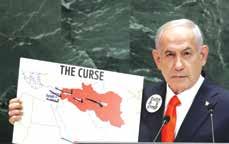
On Friday, Prime Minister Benjamin Netanyahu spoke to the U.N. General Assembly in a mostly empty hall, as most of the audience left the room in protest of the Israeli premier.
Netanyahu wore a hostage ribbon with a QR code on his suit jacket, which, when scanned, leads to footage of the Hamas-led October 7 massacre. He said the footage shows “why we fight and why we must win.”
He spoke for about 40 minutes, touting Israel’s victories, condemning the Jewish state’s critics, and discussing the future of the Middle East. Netanyahu noted that Israel’s situation was very different than one short year ago. Iran was making significant progress with its nuclear and ballistic missile programs.
Yahya Sinwar, the leader of Hamas and one of the architects of the October 7 attacks, was still alive. Hezbollah was still a powerful force in Lebanon. Syria’s Iranbacked then-President Bashar al-Assad was still in power. And the Houthis in Yemen were firing ballistic missiles at Israel, “while choking global trade at the mouth of the Red Sea.”
Now, Netanyahu noted, the Houthis are weak, most of Hamas is destroyed, and Hezbollah’s leaders and weapons arsenal are mostly gone. Israel killed Hezbollah leader Hassan Nasrallah, wiped out Assad’s armaments, and set back Iran’s nuclear program.
“We paged Hezbollah, and believe me, they got the message,” Netanyahu said, referring to the Israeli operation that caused thousands of Hezbollah pagers to blow up in September 2024. “Thousands of terrorists dropped to the ground.”
Netanyahu read the names of the 20 hostages being held in Gaza who are still alive. He did not mention Tamir Nimrodi or Bipin Joshi, about whom the army is deeply concerned. The premier, noting that his words were being played on loudspeakers in Gaza for the hostages to hear, addressed the hostages, declaring, “We have not forgotten you, not even for a second. The people of Israel are with you. We



will not falter, and we will not rest until we bring all of you home!”
He demanded that the Hamas leaders and “jailers of our hostages” release the 48 remaining abductees and threatened to “hunt” them down if they don’t.
“If Hamas agrees to our demands, the war could end right now,” Netanyahu said. “Gaza would be demilitarized. Israel would retain overriding security control. And a peaceful civilian authority would be established by Gazans and others com-
mitted to peace with Israel.”
Netanyahu declared Israel’s fight to be a battle for democracies all around the world. He posed a few multiple-choice questions to the audience, including,
“Who shouts ‘Death to America’?” and
“Who has murdered Americans and Europeans in cold blood?” The answer to both questions was: “All of the Above – Hamas, Hezbollah, the Houthis, and Iran.”
Netanyahu condemned European
you’re doing is giving the ultimate reward to intolerant fanatics who perpetrated and supported the October 7 massacre.”
“Giving the Palestinians a state one mile from Jerusalem after October 7 is like giving Al-Qaeda a state one mile from New York City after September 11th,” he declared. “This is sheer madness. It’s insane, and we won’t do it.
“I want to give a message to those Western leaders. Israel will not allow you to shove a terror state down our throats. We will not commit national suicide because you don’t have the guts to face down a hostile media and antisemitic mobs demanding Israel’s blood.”
He rejected calls for a two-state solution, noting that “the Palestinian Authority pays terrorists to slay Jews.” Netanyahu also asserted that 90% of Israelis oppose a Palestinian state.
At the end of his speech, Netanyahu discussed the potential for expanding the Abraham Accords to a number of Arab countries, including Syria and Lebanon.
“I believe that in the coming years, the Middle East will look dramatically different. Many of those who wage war on Israel today will be gone tomorrow. Brave peacemakers will take their place. And nowhere, nowhere, will this be more true than in Iran,” he said. “The long-suffering Iranian people will regain their freedom. They will make Iran great again. Our two ancient peoples, the people of Israel and the people of Iran, will restore a friendship that will benefit the entire world.”
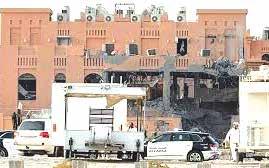
leaders for recognizing a “Palestinian state” and criticizing Israel’s war in Gaza.
“When the most savage terrorists on earth are effusively praising your decision, you didn’t do something right; you did something wrong. Horribly wrong. Your disgraceful decision will encourage terrorism against Jews and against innocent people everywhere,” he said. “It will be a mark of shame on all of you.”
To those leaders who recently recognized a Palestinian state, he said, “What
On September 9, Israel struck a building in Qatar in an effort to kill Hamas’s top leaders. The strike killed five lower-ranking Hamas terrorists and a Qatari security officer but failed to eliminate any of the targeted leaders. Now, the Shin Bet is reportedly investigating why the strike failed.
Hamas’s top officials, including leader Khalil al-Hayya, were in Doha that day, allegedly discussing a U.S.-proposed hostage deal and truce in Gaza.


Hamas’s political leaders have been hosted in Qatar since 2012.
For unknown reasons, Shin Bet intelligence was responsible for the strike, even though the Mossad usually provides intelligence for operations conducted overseas. The IDF’s Military Intelligence Directorate was also somewhat involved in the strike, according to reports.
The Shin Bet is now probing the failed assassination attempt and investigating the intelligence’s accuracy and the decision to hit just one part of the building with precision munitions. Some unconfirmed reports suggest that the targets were praying in another part of the building when the strike failed to seriously hit.
Qatar, other Arab countries, and the United States criticized Israel’s surprise strike.
Prime Minister Benjamin Netanyahu admitted that the strike was likely a failure but insisted that it sends the message to Hamas officials that “you can hide, you can run, but we’ll get you.” According to a senior Israeli official, Netanyahu has privately regretted authorizing the attack.

One boat in the Gaza-bound flotilla broke down and began taking on water this week, forcing Turkey to evacuate the activists onboard.
The Global Sumud Flotilla, which includes Swedish climate activist Greta Thunberg among its participants on some 50 boats, departed from Barcelona, Spain, earlier this month, aiming to break Israel’s blockade of Gaza and deliver symbolic aid to the war-torn enclave. It expects to reach the Gaza Strip on Tuesday or Wednesday, if it is not turned away before then.
In a statement posted on Instagram, the flotilla organizers said the mission was temporarily halted after one of the ships, Johnny M, sustained a leak in its engine room.
“All participants have been safely transferred to another vessel. Some will be reassigned to other ships, while others will be brought ashore,” the statement said.
The vessel was located in international waters between Crete, Cyprus and Egypt
when it issued a distress call early on Monday.
Turkish authorities, including the Turkish Red Crescent, coordinated the evacuation effort.
“We picked up 12 people and distributed them to other ships. Four people will return home,” said Semih Fener, the captain of one of the ships that came to assist, adding that the evacuees would travel to their respective countries via Turkey.
Previous flotillas have been stopped by Israeli forces some distance from the shore and were made to dock in Israel instead.
Israel imposed a blockade on Gaza in 2007 to prevent the import of weapons after the Hamas terror group overthrew the Palestinian Authority and took control of the enclave.

Moore had fired a handgun at the president outside a hotel in San Franscisco. She was sentenced to life in prison but was freed on parole in her final years. Her attack came just 17 days after Ford, a Republican, was targeted in an unrelated murder plot by associates of cult leader Charles Manson.
Ford was not injured in Moore’s attack, which she said was intended to spark an American revolution. She had fired the gun at Ford just hours after purchasing the .38-caliber revolver. She missed hitting the president. A former U.S. Marine standing nearby her in the crowd of some 3,000 people then subdued her, forcing her to miss her second shot.
Moore had been arrested a day earlier after a security official spotted her with a gun at a crowd gathered for Ford. That gun was confiscated, leading her to purchase another gun.

The mother of four from California served 32 years in prison before she was released on parole.
In a 2009 interview with NBC News, Moore said she had become radicalized by social upheaval in the 1960s and 1970s.
“It was a time that people don’t remember. You know we had a war … the Vietnam War, you became, I became immersed in it. We were saying the country needed to change,” she said on NBC’s Today show. “The only way it was going to change was a violent revolution. I genuinely thought that [shooting Ford] might trigger that new revolution in this country.”
Investigators found no connections with revolutionary groups and found her legally sane.
She died on September 25, exactly 50 years after the assassination attempt.
Last Thursday, President Trump signed an executive order to help finalize the sale of TikTok’s U.S. operations to an American investor group and keep the video app operating in the country.
“We have American investors taking it over, running it, highly sophisticated,” Trump said while signing the order.
Vice President JD Vance, who helped shepherd the deal, said it protects Americans’ data security, addressing one of the key concerns lawmakers on both sides of the aisle share. The new U.S. venture will be valued at $14 billion, Vance said.

The agreement, which the Trump administration has worked on for months, would spin off Beijing-based TikTok’s American operations to a new joint venture composed of majority American ownership. Oracle, a U.S.-based technology firm, would serve as TikTok’s security provider for its American operations.
The full composition of the ownership group is expected to be finalized by the closing of the deal, which could come in early 2026. Trump has already hinted at some names including Oracle co-founder Larry Ellison, billionaire tech investor Michael Dell, businessman and media mogul Rupert Murdoch and his son Lachlan Murdoch.
Under the arrangement, TikTok’s algorithm would move under the control of the new U.S. joint venture. Oracle would be in charge of inspecting and monitoring the algorithm to make sure it’s not used for any “malicious purpose,” a U.S. official said.
Leaders in multiple administrations have expressed concerns that TikTok poses a national security threat, alleging that ByteDance is sharing American user data with China. TikTok has repeatedly denied these claims.
Former President Joe Biden signed a law in 2024 banning TikTok in the United States unless its Beijing-based parent company, ByteDance, divested its U.S. holdings.
Amazon recently settled a lawsuit filed by the Federal Trade Commission, with the company announcing on Thursday that it would pay $2.5 billion and enact certain changes.
The settlement was reached a few days into a civil trial in which the FTC accused Amazon of tricking users into signing up
for Prime subscription membership and preventing them from easily canceling the plan. Now, Amazon must pay a $1 billion civil penalty, the largest amount the FTC has ever received, and establish a $1.5 billion fund to compensate affected users. Additionally, the company must redesign its Prime interface to allow for seamless cancellation.

Amazon has neither admitted nor denied liability in the suit but opted to settle in order to move on from the issue. According to Amazon, its Prime sign-up system already aligns with the settlement’s requirements.
“We work incredibly hard to make it clear and simple for customers to both sign up or cancel their Prime membership, and to offer substantial value for our many millions of loyal Prime members around the world,” the online retail giant said.


The settlement automatically gives $51 to anyone who used up to three Prime benefits during any 12-month period from June 2019 to June 2025. Those who used Prime benefits fewer than 10 times during that time can file a claims process to receive that same compensation. Those eligible for compensation will be informed by mail and email.
According to the settlement, Amazon must make the terms and costs of its trial subscriptions clear, including how often the user will be charged and how the customer can cancel. Canceling must be as simple as signing up, according to the FTC.
“The evidence showed that Amazon used sophisticated subscription traps designed to manipulate consumers into enrolling in Prime, and then made it exceedingly hard for consumers to end their subscription,” said Andrew Ferguson, the chairman of the FTC. “Today, we are putting billions of dollars back into Americans’ pockets and making sure Amazon never does this again.”
According to the FTC, Amazon’s deceptive practices impacted almost 40 million users.
Amazon Prime, which is used by over 200 million people, is the world’s largest paid subscription service. In 2023, the
FTC sued Amazon for allegedly making it too easy for users to accidentally sign up for Prime and too confusing for users to cancel. In April of that year, Amazon redesigned its sign-up process, shortly before the lawsuit’s filing. A few months before filing the case, the FTC tried enacting a rule to force companies to make canceling subscriptions as seamless as signing up, though a federal appeals court banned the commission from doing so, alleging that the FTC failed to consider costs incurred by the businesses.
Recently, the FTC also sued Amazon for allegedly forcing sellers to use its logistics service in order to qualify for Prime shipping and penalized sellers for offering discounts on other platforms. Amazon has rejected the validity of the FTC’s allegations. The antitrust case is expected to go to trial in February 2027.
On Thursday, U.S. President Donald Trump and his Turkish counterpart, Recep Tayyip Erdogan, spoke for two hours at the White House. During the meeting, Trump hinted that he might allow the

U.S. to sell advanced F-35 fighter jets to Turkey.
Turkey was once part of the U.S.’s F-35 fighter jet program. However, Trump, during his first term, removed the country from the program over concerns of Russian spying, following Ankara’s purchase of Russia’s S-400 surface-to-air missile system.

Israel, the only Middle Eastern country that is currently part of the U.S.’s F-35 fighter jet program, has voiced its opposition to Turkey and other nearby countries obtaining the U.S.’s advanced missiles. Israel has 45 F-35s and has ordered 30 more.
Trump, during the meeting with Erdogan, suggested that he might resume F-35 sales to Turkey.
“He needs certain things, and we need certain things, and we’re going to come to a conclusion. You’ll know by the end of the day,” said Trump of Erdogan, adding that he believes the Turkish leader will “be successful with buying the things” he wishes “to buy.”
Trump called the meeting, which was Erdogan’s first in Washington since 2019, “good.”
During his first term in office, Trump touted his relationship with Erdogan as “very good.” However, as of late, the U.S.’s relationship with Turkey has soured, as American officials raise concerns over Ankara’s diplomatic and economic partnership with Moscow, as well as its opposition to Israel, a key U.S. ally. Erdogan claims that Israel’s war in Gaza, which was sparked by the Hamas-led October 7 massacre, constitutes a genocide. He has also compared the Jewish state to Nazi Germany. Additionally, Erdogan has come under fire for human rights violations. His critics have charged him with undermining Turkish democracy and cracking down on freedom of expression.
In early 2023, the European Union said it would stop purchasing most Russian seaborne oil in protest of the war in Ukraine. Since then, Turkey has bought over $90 billion worth of Russian oil, coal, and natural gas, with Ankara emerging as one of the biggest buyers of Russian fossil fuels.
Trump said of Erdogan, “The best thing he could do is not buy oil and gas
from Russia.”
Trump also said that Erdogan could play an important role in ending the war in Ukraine, as the Turkish president is respected by both Russian President Vladimir Putin and Ukrainian President Volodymyr Zelensky. Recently, Trump changed his position on the Ukraine war, suggesting that Ukraine may be able to regain all the land that Russia seized since the war began.
Trump credited Erdogan, a supporter of the rebels who now rule Syria, with playing a role in Syrian leader Bashar al-Assad’s downfall late last year.
“I think President Erdogan is the one responsible for Syria, for the successful fight in ridding Syria of its past leader,” Trump said. “He doesn’t take the responsibility, but it’s actually a great achievement.”
On Monday, U.S. Secretary of State Marco Rubio met with Syria’s terrorist leader-turned-president Ahmed alSharaa on the sidelines of the U.N. General Assembly.

Former FBI Director James Comey was indicted by a federal grand jury last Thursday on charges related to false statements he made on September 30, 2020, while testifying before Congress.
The charges — obstruction and lying to Congress — were sought by the Department of Justice shortly after President Donald Trump asked Attorney General Pam Bondi to pursue charges against Comey, California Sen. Adam Schiff, and New York Attorney General Letitia James.
While Comey was the agency’s director, the FBI investigated whether Russian collusion led to Trump’s victory in the 2016 presidential election. In the end, special counsel Robert Mueller found there to be insufficient proof that Trump’s campaign collaborated with Russia. During his testimony to Congress in 2020, Comey lied, testifying that he hadn’t “authorized someone else at the FBI to be an anonymous source in news reports,” according to prosecutors.
President Trump said the indictment




would bring about justice.
“JUSTICE IN AMERICA! One of the worst human beings this Country has ever been exposed to is James Comey, the former Corrupt Head of the FBI,” Trump said in a Truth Social post. “He has been so bad for our Country, for so long, and is now at the beginning of being held responsible for his crimes against our Nation. MAKE AMERICA GREAT AGAIN!” Comey has denied the charges and accused Trump of weaponizing the DOJ
to prosecute the president’s political enemies.
As of late, Lindsey Halligan, Trump’s newly-appointed prosecutor in the Eastern District of Virginia, was overseeing the case. Halligan replaced Erik Siebert as Alexandria, Washington, D.C.’s top federal prosecutor on September 20 after Siebert left his position. According to reports, Siebert quit after questioning the case against Comey and telling the DOJ that he didn’t have enough proof to
to holding those who abuse positions of power accountable for misleading the American people. We will follow the facts in this case.”
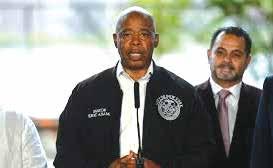
Eric Adams, the mayor of New York City, suspended his re-election bid on Sunday. His announcement came just over a month before the upcoming mayoral election.
Despite his campaign’s suspension, Adams will remain on the ballot, since he dropped out too late for his name to be removed.
Adams, a Democrat who skipped his party’s primary to run as an independent, abandoned his bid for reelection amid polling that showed him trailing behind Democratic nominee Zohran Mamdani, independent candidate former Gov. Andrew Cuomo, and Republican nominee Curtis Sliwa. He suspended his campaign after Judge Dale Ho, the Manhattan federal judge who oversaw the mayor’s criminal case, said he would add New York’s Campaign Finance Board as an interested party in Adams’ corruption case, which was dismissed. Before choosing whether to award matching funds to the mayor’s campaign, the CFB wanted to review the case. According to Ho’s order, Adams’s almost $4 million in campaign funds is not likely to be matched by public money.
Adams attributed his decision to drop out of the race to media speculation and the CFB’s withholding of funds, which “have undermined my ability to raise the funds needed for a serious campaign.”
seek charges against New York Attorney General Letitia James. However, Trump claims to have “fired” Siebert due to his “UNUSUALLY STRONG support” from Democratic Virginia senators.
Democrats accused Trump of abuse of power, with some declaring a “constitutional crisis.” On X, Bondi defended the charges.
“No one is above the law,” Bondi posted. “Today’s indictment reflects this Department of Justice’s commitment
“When I was elected to serve as your mayor, I said these words: This campaign was never about me. It was about the people of this city -- from every neighborhood and background – who had been left behind and believed they would never catch up. This campaign was for the underserved, the marginalized, the abandoned and betrayed by government,” Adams declared. “Since then, it has been my honor to be your mayor. And I am proud to say that we took that victory four years ago and turned it into action, making this

city better for those who had been failed by government.”
In September 2024, Adams was indicted on five counts. In April, the charges were dropped by the Justice Department. Adams’ critics have claimed the charges were dropped for political reasons.
According to reports, President Donald Trump’s advisers have been urging Adams to suspend his campaign, arguing that Adams, Cuomo, and Sliwa would split the conservative vote, handing Mamdani a victory. Trump’s advisers have reportedly offered Adams a job as ambassador to Saudi Arabia, a report that Trump and Adams have denied.
Adams will remain mayor of New York City until his term is over. His political future is unclear.
In response, Mamdani criticized Adams and Trump.
“Donald Trump and his billionaire donors might be able to determine Eric Adams and Andrew Cuomo’s actions, but they will not dictate the results of this election. New York deserves better than trading in one disgraced, corrupt politician for another. On November 4, we are going to turn the page on the politics of big money and small ideas and deliver a government every New Yorker can be proud of,” declared socialist candidate
Mamdani.
Cuomo, on the other hand, praised Adams, noting that the mayor’s decision “was not an easy one, but I believe he is sincere in putting the well-being of New York City ahead of personal ambition.”
“We face destructive extremist forces that would devastate our city through incompetence or ignorance, but it is not too late to stop them,” Cuomo said. “Mayor Adams has much to be proud of in his accomplishments. Only in New York can a child raised in a tenement in Bushwick, who once worked as a squeegee boy and a mailroom clerk, rise to become mayor. Whatever differences we may have, Eric Adams’ story is undeniably one of resilience – a testament to the spirit of this city.”
A spokesperson for Sliwa said the Republican nominee is the only candidate who can defeat Mamdani.
“Curtis Sliwa is the only candidate who can defeat Mamdani. Our team, our resources, and our funding are unmatched. Most importantly, we have the best solutions to help working people afford to stay in New York City and feel safe,” the spokesperson said.

Thomas Jacob Sanford, a 40-year-old U.S. Marine veteran, entered a Mormon church in central Michigan with an assault rifle on Sunday and shot “several rounds” at congregants before setting the building ablaze, killing four or more people and injuring others, officials said.
Sanford first drove a pickup truck into the church before entering the house of worship and opening fire on the hundreds of people attending Sunday service and “deliberately” setting fire to the building, according to Grand Blanc Township Police Chief William Renye. The church is in Grand Blanc, a suburb of Flint, Michigan.
According to Renye, police were called at 10:25 a.m. and responded to the scene within 30 seconds. At 10:33 a.m., the gunman was shot dead in the church’s
parking lot by two officers following a brief gunfight.
Seven people sustained gunshot wounds and are in stable condition at Henry Ford Genesys Hospital, while one is in critical condition.
The FBI is investigating the attack “as an act of targeted violence,” according to the FBI’s Detroit field office acting special agent Reuben Coleman. The shooter’s motive is currently unclear.
“This act of violence has no place in our state or anywhere else in our country,” said Coleman. “The FBI is committed to continue finding out the facts, circumstances, and motives behind this tragedy.”
“The suspect is dead, but there is still a lot to learn,” President Trump said on social media. “This appears to be yet another targeted attack on Christians in the United States of America.”
“The Trump Administration will keep the Public posted, as we always do,” the president said. “In the meantime, PRAY for the victims and their families. THIS EPIDEMIC OF VIOLENCE IN OUR COUNTRY MUST END, IMMEDIATELY!”
The shooter had graduated from a nearby high school in 2004 and then enlisted in the Marines, serving four years, including a deployment to Iraq in 2007.



Starbucks announced last week that it will be laying off 900 corporate workers and closing hundreds of stores in efforts to trim costs and improve some of its cafes. Most of the affected positions were in North America.
The layoffs are the second round that the coffee giant has undertaken since Chief Executive Brian Niccol took the helm roughly a year ago. Niccol has said the reductions are needed to direct more resources toward its stores, where he is boosting staff and introducing new training for baristas to make cafes more hospitable.
“These steps are to reinforce what we see is working and prioritize our resources against them,” Niccol said in a message to employees last Thursday.
Starbucks said it would spend around $1 billion in severance payments, exiting leases and other costs. The company will begin the process of closing most of the stores in the coming days.
The closing locations include cafes in Seattle, among them the chain’s flagship Roastery in the city and Reserve store at its headquarters.
The coffee chain saw six straight quarters of declining same-store sales. The chain is grappling with rising labor costs, in addition to surging coffee prices
Starbucks’ corporate employees work in roles including store development, roasting, manufacturing, warehousing and distribution.
In February, Starbucks said it would lay off 1,100 corporate employees and not fill hundreds of open jobs. Those cuts included many technology workers, including application developers and engineers, according to state records. Some product managers and administrative assistants were laid off, too.
After Niccol announced the first round of layoffs, he said he didn’t anticipate additional reductions, but it would depend on the business being successful going forward.
“I’ll be transparent with you, if we

don’t perform, it becomes a challenging environment. You’ve got to assess all alternatives,” Niccol said during an internal town hall in March.
In July, the company announced a voluntary exit program for North American corporate employees. The pay packages ranged from $20,000 to $100,000.
Niccol has stepped up in-office work requirements for North American corporate employees to four days a week, up from three previously. The requirement goes into effect in October.

Heavy rain caused flooding in Arizona this week, leading to fatalities. At least three people were killed in a rural 19th century mining town, where people had to scramble for safety on their rooftops. The floods in the town washed out a propane distributorship, scattering about 1,000 tanks downtown, authorities said Saturday.
About 2.5 inches of rain fell in Globe, a city of about 7,250 people about 88 miles east of Phoenix, over 24 hours and another storm moved in on Saturday, temporarily halting the search for people possibly missing in the flood because of high-flowing creeks. At least three people were killed in that town.
“We now have a massive search and rescue underway,” a sheriff official said.
Carl Melford, emergency manager in Gila County, said, “There’s propane tanks everywhere through downtown Globe. Luckily none of them ignited or exploded.”
Globe City Council members declared an emergency, saying they have never seen flooding like this.
Scores of people have stepped up to volunteer, said Mayor Al Gameros, adding that many buildings in the community’s downtown have been damaged. Officials asked people to stay away from the area until they could ensure it is safe to go in there.
“Our primary, again, is search and rescue,” Gameros said on Saturday.

Nigel Edge, a Marine veteran, pulled up to a bar located on a waterfront in North Carolina and fatally shot three people on Saturday night.
The 40-year-old arrived to the outdoor deck of American Fish Company in Southport by boat. Eight people were injured and at least one victim “is now clinging for their life,” Jon David, district attorney for North Carolina’s Judicial District 5, said.
Edge, who received a Purple Heart for his service in Iraq, was arrested on Sunday and charged with three counts of first-degree murder, five counts of attempted first-degree murder and five counts of assault with a deadly weapon with intent to kill, Southport Police Chief Todd Coring said.
Edge was taken into custody when the U.S. Coast Guard encountered his boat after the attack.
“Evil has come ashore in Southport, North Carolina,” David said, describing the community as a place where violent crime is “virtually nonexistent.”
“I’m heartbroken by the shooting last night in Southport that tragically took three lives and injured others,” North Carolina Gov. Josh Stein said in a statement. He said he and his wife “pray for their families and friends. I have been in touch with state and local law enforcement, and the state will provide any support needed.”
Edge was a sergeant who served in the Marines from 2003 to 2009. He deployed in Operation Iraqi Freedom, the 2003 invasion of Iraq. He received a variety of awards for his service, including a Purple Heart – awarded to service members who suffer wounds in combat – and a Humanitarian Service Medal. His last assignment was in Wounded Warrior Battalion East, a North Carolina center that supports injured Marines.
The attack is one of two mass shootings allegedly committed by Iraq War veterans over the weekend. Just a little over 12 hours after the North Carolina shooting, another Marine veteran, Thomas Jacob Sanford, drove his car into a chapel of

46 a Mormon church in Grand Blanc, Michigan, and then opened fire, according to police. Two people were fatally shot and eight others were injured. Sanford, who then set a fire that grew into a large blaze, was killed at the scene.
There have been at least 324 mass shootings – defined as incidents in which at least four people are shot, not including the shooter – in the U.S. so far this year.

Sandro Dias is fearless.
The 50-year-old professional skateboarder recently broke two world records by skateboarding down a ramp on the 22-story Centro Administravito Fernando Ferraro building in Brazil.
Dias reached a speed of 103kph in the death-defying stunt, skating from a height of 70 meters with a drop of 60 meters. In total, he made four attempts, all of which were successfully executed on the first try.
After he did it, Guinness World Records officials certified him for breaking the records for “the tallest drop into a temporary quarter pipe” and “the fastest speed on a temporary quarter pipe.”
Speaking to Red Bull, Dias revealed that the stunt had been in the making for 13 years. “I knew it was possible, but almost impossible to actually pull off,” he said. “No matter how far away your dreams may seem, never give up on them!”
Dias also revealed how he trained for the stunt — with extensive physical and technical training that involved weight vests to simulate increased G-Force and stability drills at speed.
“I prepared myself a lot for this,” Dias explained. “It wasn’t easy, the training
was way tougher than this, and that’s why I was so confident. This is a dream of more than 13 years that we’ve just achieved now, pushing the limits.”
In an interview with Jenkem before the stunt took place, Dias opened up about the emotions he was feeling. “I think the most important thing is my mental,” he said. “To know that I was really prepared after all the tests, all the training. Because when you go there and look at the building, you’re like oh, my G-d, that’s big. But, I always tell myself, ‘I’m prepared for this. I’m ready. I’m prepared. I did everything that I’m supposed to do to get ready.’”
After the jump, Dias mused, “I’m surprised. Nothing is in pain on my body. Actually, it’s kind of crazy,” he admitted. “Every test that I did before was super hard and super intensive, but the days after I felt normal. It’s kind of weird for my age.”
Totally fearless.

Raynae Madison and her family traveled to Arkansas’ Crate of Diamonds State Park for her nephew’s birthday. Before heading to the site, though, the family brought along a beach digging kit and sand sifting tools they bought at a dollar store.
Luckily, they had those fancy tools with them. After going through a few buckets worth of sand at the park, they spotted a shiny, oblong object.
“At first I thought it looked really neat, but I wasn’t sure what it was,” Madison said. “I honestly thought it was too big to be a diamond.”
They took the stone to the park’s Diamond Discovery Center, where experts confirmed it was a 2.79-carat brown diamond.
“Brown diamonds from the Crater occur due to a process called plastic deformation, which creates structural defects during a diamond’s formation or movement in magma,” Emma O’Neal, an interpreter at the park, noted. “These defects reflect red and green light, combining to make the diamond appear brown.”
Madison dubbed her gem the William Diamond, in honor of her birthday-cele-
brating nephew.
So far, 403 diamonds have been found at Crater of Diamonds State Park in 2025 – four of which have weighed more than two carats. The William Diamond is the third-largest gem found at the park so far this year.
Talk about a big birthday present.

Andrzej Bargiel made history last week when he became the first person to ski down Mount Everest without supplemental oxygen.
The Polish national’s achievement is also being hailed as a landmark moment in the world of extreme endurance sports
Bargiel, 37, summited the world’s highest peak at 29,032 feet on September 22 before putting on his skis and starting his big descent.
“I am on top of the highest mountain in the world, and I’m going to descend it on skis,” Bargiel said in a video posted to his Instagram page before pushing off from the snowy summit.
The athlete split the feat into two sections, first skiing to Camp II before spending the night and then continuing through what is said to be the dangerous Khumbu Icefall the next morning.
People have tried ski descents from Everest in the past, but none of them have completed the run without bottled oxygen.
Bargiel also spent nearly 16 hours in the so-called “death zone” above 8,000 meters, where oxygen levels are dangerously low and survival is difficult without bottled air.
When he reached base camp, Bargiel was greeted with a khada, a ceremonial Buddhist scarf, in recognition of his success.
Polish Prime Minister Donald Tusk celebrated the accomplishment on X, writing, “Sky is the limit? Not for Poles! Andrzej Bargiel has just skied down Mount Everest.”
Bargiel is reportedly no stranger to high-altitude firsts. In 2018, he became the first person to ski down Pakistan’s K2, the world’s second-highest mountain. He had also attempted Everest in 2019 and
again in 2022 but was thwarted by
ble ice and high winds.
We’re out of breath just thinking about it.

This is so ruff.
Bolzano, a town in northern Italy, will be imposing a daily tax of 1.50 euros on owners of dogs who visit the town. The fee will start in 2026 and is part of a wider and controversial clampdown on canines in the pristine destination, a gateway to the Dolomite mountains.
Local dog owners will also be subject to a tax of 100 euros per dog annually.
The duty is meant to help offset the costs of street cleaning and to fund new parks for dogs and their owners.
This town has another dog initiative on its books. Owners are expected to have their dogs’ DNA registered so that uncollected dog droppings can be matched to the culprit and fines issued. Dog owners who fail to pick up after their pets currently face penalties of up to 600 euros per violation.
Provincial Councilor Luis Walcher, who introduced the measure, said that those who have already complied with the DNA registry will be exempt from the new levy for two years.
Not everyone is happy with the tax on four-legged visitors.
Carla Rocchi of ENPA, a national animal protection body, said, “After the resounding and costly failure of the absurd dog DNA project, instead of focusing on civic education, targeted checks, and citizen awareness, we’re once again choosing the easy way out: taxing animals and their owners.”
She added, “It’s paradoxical that in an area that thrives on tourism and hospitality, we’re targeting precisely those who choose a respectful and inclusive vacation, bringing their four-legged companion along.”
Really howl-ible.



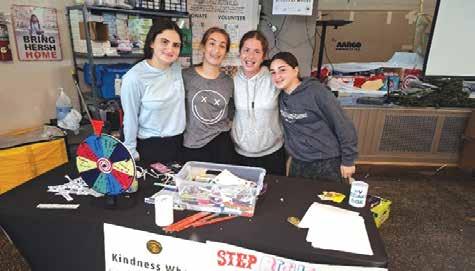





Ever since the outbreak of the war, rabbis on campuses across the country have been inundated with requests for mezuzahs by Jewish students, many who never had any affiliation with Judaism. The unprecedented anti-Semitism they experienced firsthand sparked these students with their Jewish flame to proudly identify themselves as Jews. I started with, and collected 200 unused mezuzahs, from people like you who had them “laying around” their homes.
Because of the current political atmosphere, I was sure that this year there wouldn’t be any requests; however, just the opposite happened, with more university shluchim and Jewish organizations requesting mezuzahs.
These PROUD Jewish students across the country are fighting back against anti-Semitism, attaching their new mezuzahs, which you donated, to their dorm rooms and reciting the bracha.
Even 1 mezuzah means 1 more dorm room, 1 more student reaching out, identifying, and believing, 1 more student at-
tending a campus Shabbat meal.
And more! These students take their mezuzah with them when they leave the university. YOUR mezuzah follows them everywhere they go as they embark on their lives and will remain PROUD JEWS.
Please join our mezuzah campaign, and ask friends, neighbors, to donate their unused mezuzah today. We will check, pack, and send them to our Jewish brethren.
Sofrim/shuls/yeshivos: if you have unused mezuzahs, this is your opportunity to empty your stock.
Am Yisrael needs all the protection it can get. These Jewish students on the front lines need our support. Show them we care, that they’re not alone. Donate your unused mezuzah.
Give your unused mezuzah a new home: mezuzahmover@gmail.com or 347-414-7454. Mail to:
Mezuzah Mover/ N. Horowitz POB 297221 Brooklyn, NY 11229-9993


Towns Flag Football Week 4 kicked off with a bang as the Jets and Patriots tied in a thriller first grade matchup and Giants beat the Broncos. In second grade, the Broncos toppled over the Giants. We had a bunch of great third and fourth grade matchups which brought the Jets to beat the Seahawks, Packers over Vikings, Steelers over Patriots, Eagles over Broncos, and the Giants over the Raiders. The 5th and 6th graders played hard as the Panthers toppled over the Jets, Broncos beat the Steelers, Vikings won the Eagles, and the Patriots and Giants tie. In 7th and 8th grade, the Jets beat the Patriots and the Giants beat the Broncos. Amazing plays were made by Gabriel Sipzner, Aryeh landsman, Natalie Safier, and Yaakov Bollag. Standings are updated and can be checked at www.5townsflagfootball.com
Our second FM Home Loans Giveaway will be an authentic classic FFL winter hat which will be given to all participants after Sukkos. We wish everybody an easy and meaningful fast and
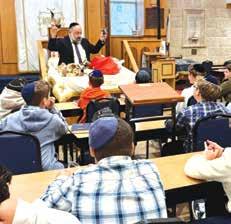
hope to see everybody next week for an exciting week 5.




Rabbi Greenberg’s shiur at YOSS Mechina measured amos as they learned about Hilchos Sukkah



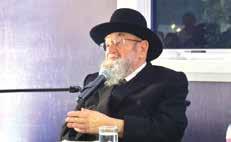






HAFTR LS students learned about the “parts” of a lulav and esrog and even constructed their own Arba Minim sets that they will use over the course of the holiday. It was so interesting learning about how every piece is unique and how they each contribute to the fulfillment of the mitzvah. Chag Sukkot sameach from

Touro University and Touro College of Dental Medicine (TCDM) recently announced the official grand opening of the dental clinical training facility in Albuquerque, New Mexico. The new 70,000 square foot facility houses more than 100 dental units, accommodating students who spent their first two years of dental school at Touro College of Dental Medicine in Hawthorne, New York, and will be completing their education and clinical training in New Mexico.
“Touro University is one of the leading educators of healthcare and oral health providers in the country. TCDM’s commitment to excellence and its comprehensive training practice in Albuquerque will provide the highest quality of dental education while offering affordable care to the community,” said Touro University President Alan Kadish, M.D.
“Our first class of 100 students has begun the next stage of their education
in New Mexico and arrive equipped with the extensive knowledge and skills to begin treating patients from the Albuquerque community,” said TCDM Dean Ronnie Myers, D.D.S.
With thousands of New Mexicans unable to afford dental care, the opening of TCDM’s state-of-the-art dental clinical training facility will allow them to receive affordable oral health care. The students enrolled in the teaching practice, under supervision from dental professionals and instructors, will perform dental examinations and procedures for those in need of treatment who are not able to afford professional dental work.
“TCDM opens in New Mexico to make a positive difference in the health of New Mexicans of all ages and income levels.
It is our mission to provide excellent, affordable dental care services while training outstanding dental professionals who deliver exceptional health care services to diverse communities throughout the
Week 3 of the JSL Fall Season, presented by FM Home Loans, delivered it all—lategame heroics, hat tricks galore, and some jaw-dropping individual performances that left fans in awe. From youth divisions to men’s basketball, the competition keeps heating up as teams find their stride.
Smash House knocked off Marciano PD 6-2 behind the relentless hustle and shutdown defense of Yehuda Kabalkin. Yeled LI Panthers rolled to an 8-3 win over Stand Out Care, thanks to a 5-goal showcase from Moshe Homnick, who was unstoppable all game. SD Shades pulled off the ultimate buzzer beater—Daniel Englander scored with just 5 seconds left to lift his squad to a thrilling 4-3 win over Marciano. Shalom Raful was everywhere on the floor, scoring and setting up teammates, as his squad cruised past Demo & Cleanouts in commanding fashion.
5TownsCentral put on a show against PIP Printing, with Yehuda Issacs scoring a jaw-dropping 10 goals in

state,” continued Myers.
“We are dedicated to providing our patients with the highest quality care and our students with the best educational experience. This enables the college to offer a full-range of dental training under one roof, while providing students with hands-on exposure to and training in all dental disciplines and patients the care that they need,” said TCDM Executive Assistant Dean Joseph Parkinson, D.D.S.
The opening of the TCDM in New Mexico is an estimated $40 million in-
vestment by Touro University including the property acquisition and construction of the dental college.
TCDM’s new dental clinic expands on the success of the organization’s New York campus and offers educational opportunities to students to serve diverse communities. The students in New Mexico receive the same high level of academic support and student services, faculty to student ratios, educational facilities, and clinical experiences.
the blowout win. In a defensive chess match, Maidenbaum and SR Whee battled to a draw after Nissim Schwartz netted the late equalizer.
SR Whee held off 5TownsCentral 8-5, powered by a JWorks JSL Hat Trick from Yisrael Baum. Posh Home & Bath defeated Tikva Fire 7-5, with Eli Bryks and Jerry Pasternak forming a lethal one-two punch on the scoreboard.
2nd/3rd
On his birthday, goalie Gavriel Aryeh had the game of his life, making one highlight save after another to carry Growtha past NY Custom Closets 3-2. Built By Nate edged Newman Dental 7-6 in a wild offensive battle, but it was Seeli Fried’s defense that sealed the win. Sushi Tokyo surged past Town Appliance 6-2, with Yaakov Mermelstein setting the tone by scoring the opener. Styles Design Interiors and J Works Construction went the distance. After Dovid Levitan tied it late, Styles Design came out on top in a shootout thriller.
4th/5th Grade Hockey
TAL Academy earned their first win, a 4-2 decision over Wieder Orthodontics, thanks to all-around hustle from Dovi

Stein. Extreme Vents held on for a 7-5 victory over Smash House, with goalie Zecharya Koegel shutting the door late. J Works Construction blanked Styles Design Interiors 3-0, with Simcha Bersson pitching the shutout in goal and Eli Benedek tallying a JWorks JSL Hat Trick on offense. Eden Gardens defeated SR Whee 7-5, behind a JWorks JSL Hat Trick from Moshe Beiss, who powered his team to the win.
6th/7th Grade Hockey
Town Appliance edged Cachet 3-2, led by a 2-goal effort from Binyamin Flegmann. SD Shades were unstoppable, riding an unbelievable 12-goal explosion from Gavriel Abbitan to a statement win over Wieder Orthodontics. Sper-

ling Productions outlasted Emporio 5-4 in a game decided by a shootout. Ben Parnes stood tall in net to deliver the win.
Men’s Basketball
Town Appliance escaped with a 6160 win over Maidenbaum, led by captains Shelby Rosenberg and Ashie Schreier, who combined for 45 points. Kol Ve’or beat Smash House 59-53 in a tight contest, behind Yitz Bennett’s 17-point performance. Hewlett Auto Body dominated Advantage PT 73-48, thanks to a 30-point outburst from Yoni Oratz, who couldn’t be stopped. Emporio surged past SR Whee 108-65, powered by Yitzy Wieder’s 25-point showing in a commanding all-around effort.

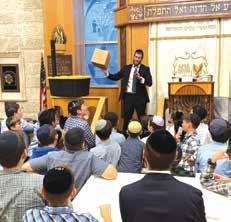
Tech ‘n’ Check at YOSS kicked off the year with an unforgettable evening, headlined by Mentalist
David Blatt


On Wednesday, September 17, eighth grade students from HAFTR, in collaboration with Bikur Cholim of Far Rockaway and the Five Towns, visited the residents of the Five Towns Premier Nursing and Rehabilitation Center. The students gave out Rosh Hashana cards, played games, sang






This Shabbos Shuva, talmidim, alumni, and rebbeim of MTA gathered for a powerful Bergen County Shabbaton, filled with tefillah, Torah, and achdus.
The Shabbaton began Friday night with Mincha and Kabbalas Shabbos at Congregation Beth Abraham in Bergenfield. After a meaningful Seudas Shabbos, talmidim joined together for chaburos led by MTA rebbeim and alumni. The evening culminated in a tisch led by Rav Tanchum Cohen, where zemiros and divrei chizuk carried the ruach of Shabbos late into the night.
On Shabbos morning, a kiddush at the Book home in Teaneck served as a gathering point where talmidim and alumni were able to connect with delicious food.
One of the highlights of the afternoon was the Shabbos Shuva drashos, delivered in host homes for each grade. Freshmen gained insight from Rabbi Konigsberg, sophomores and juniors were inspired by Rabbi Eli Cohn, and seniors were guided by the heartfelt words of Rabbi Schenker. Each drasha offered practical hadracha and meaningful chizuk, helping talmidim focus their avodah as they prepared for the Aseres Yemei Teshuva and Yom Kippur.
This Shabbaton marked the first of a series of community Shabbatonim that MTA will be running throughout New York and New Jersey, strengthening the

bond between talmidim, alumni, rebbeim, and the broader community.
The Shabbaton concluded with Maariv and Havdala, leaving talmidim elevated and inspired to carry the ruchniyus of Shabbos into the coming days of teshuva and beyond. It was a true expression of the MTA mission to cultivate growth in Torah, achdus, and yiras Shamayim.
The yeshiva continued its preparation for Yom Kippur with a special Mishmar Madness on Erev Yom Kippur. The evening featured a delicious dinner, rotating divrei hisorerus from MTA Rebbeim, and a heartfelt kumzitz in the library led by Reb Moshe Auslander. It was the perfect way for talmidim to enter Yom Kippur inspired and ready to daven with renewed focus and connection.


Assemblywoman Nily Rozic announced $25,000 in new funding for Tomchei Shabbos of Queens to support their kosher meal delivery program that provides meals to low-income families, single-parent households, and older adults.
Tomchei Shabbos’ food program addresses food insecurity for those who may have limited options with food stamps and face mobility challenges in accessing kosher supermarkets or food pantries. With this state grant, meals will be delivered directly to households in need, ensuring access to nutritious, kosher food throughout the year.
“Access to food is a basic need that no family should have to go without,” said Assemblywoman Rozic. “I’m honored to provide this funding to Tomchei Shabbos of Queens, whose compassionate work delivers not just meals, but hope and dignity to families facing food insecurity. This investment reflects our com-
mitment to making sure everyone can celebrate the holidays with the care they deserve.”
President of Tomchei Shabbos of Queens Shimi Pelman said, “On behalf of 500 families and 3,000 recipients, thank you Assemblywoman Nily Rozic. Rozic’s support enables Tomchei Shabbos to bring fuller holiday meals to our community. Together, we are ensuring that no family is left behind.”
For more than thirty years, Tomchei Shabbos of Queens has provided food packages on a weekly basis to approximately 400 needy families and individuals throughout Queens.
Additional community investments recently announced by Rozic include a $350,000 grant for a new local volunteer ambulance for Queens Hatzolah, $30,000 for a new STEM lab at Queens Hebrew Academy, and $15,000 for an Adult Education Program at Young Israel of Hillcrest.


The BYAM Preschool had a fun and engaging kapparos demonstration. The girls learned about and compared the different minhagim, and

some were even brave enough to hold the live chicken! A special thank you to the Gros family of Beach 13th for generously lending us your beautiful chicken.

The Rambam Mesivta Seneca Getaway proved once again why it has become a highlight of the school year, bringing together students and rebbeim for an unforgettable experience of fun, friendship, and inspiration.
From the moment the buses arrived, the energy was electric. Rebbeim joined the talmidim throughout the trip, learning with them in formal and informal sessions, and building a spirit of achdus that carried through the event. Rosh Mesivta Rabbi Avi Herschman led engaging shiurim and even stepped up to the plate in the Homerun Derby, putting forth a valiant effort that drew cheers from the crowd.
The getaway featured a full slate of tournaments that showcased the talent and interests of Rambam’s students. The Volleyball Tournament was captured by Team Yunaev, with senior Eli Yunaev himself earning MVP honors. On the gridiron, senior Ephraim Twersky led his team to victory in the Flagfootball Tournament. Freshman Noah Goldman shined at the plate, winning the Homerun Derby, with sophomore Aryeh Nenner finishing as runner-up. In addition, Dovid Rabinow, a sophomore, earned the Gold Glove Award. Aryeh Nenner also triumphed on the tennis courts, securing the Tennis Tournament title. The
Connect-4 Tournament was taken by 12th grader Avi Pearlman, with standout freshman Itiel Rydzinski taking second place. The freshmen also had their own special ice-breaker session led by Principal Dr. Hillel Goldman, designed to help them build connections and a sense of perspective as they begin their Rambam journey. One of the highlights of the trip was the spectacular weather, which allowed the boys to enjoy quality time at the lake, with row boating and paddle boating proving especially popular. The camp’s boardgame and videogame rooms were bustling, while stations for ping-pong, foosball, and cornhole drew steady crowds. Basketball, hockey, soccer, pickleball, frisbee, and other activities filled the fields and courts, ensuring that every student found something to enjoy. The Seneca Getaway wouldn’t have been possible without the tireless efforts of Rambam’s Director of Student Activities, Reb Yitz Milworn, whose planning and dedication made the event one for the ages. With the year off to such a strong start, excitement is already building for upcoming events: the Rambam West Hempstead Tisch at Dr. Goldman’s home, the December Shabbaton, and the beloved Rebbe Shabbatons in February.
The kesher between students, rebbeim, and the Rambam community keeps on getting stronger!


The yeladim in HANC’s Early Childhood Division of the brand new Reinstein Family Campus in West Hempstead were busy this past week preparing for Yom Kippur, Sukkot and Simchat Torah. After reading books about the chagim, the children participated in a variety of experiential activities to ensure that they will be able to fully participate in the celebrations with their families. In preparation for Yom Kippur, the children painted a pair of shoes and utilized their lacing skills to add laces on their Yom Kippur shoes. They also painted whales and attached a little Yonah doll that they could put inside the whale’s mouth and then pop it out when they share the story with their families.
After learning about the mitzvot
of Sukkot and reciting the appropriate brachot, each child had the opportunity to hold an etrog and shake a lulav in a real sukkah built on the grounds of the new Early Childhood area and learn about the mitzvah of sitting in the sukkah. In order to enhance the chagim at home, the children created numerous decorations utilizing their sensory and fine motor skills to craft each project.
Personalized with their photographs, the children created Baruchim HaBaim signs, Ushpizin charts and beautiful Simchat Torah flags. Each project was created by embellishments created with watercolors, dip-dot art, beads, pipe cleaners, and even model magic clay to create an etrog. To emphasize the importance of the pitum, the children placed a clove on the top of their painted etrogim

to remind the children to treat the pitum with special care so it doesn’t break off. To add extra excitement to the sukkah decorations, the young children used their patterning skills to string beads on pipe cleaners with a bell on the bottom, which they attached to their “Welcome to our Sukkah” posters. Many of the projects were laminated to ensure that the keepsake projects would survive inclement weather and would be able to be hung in the sukkah for many years to come. A favorite time was the children singing so many holiday songs that they can delight their families with as they celebrate in shul and at home.
Providing the children with a myriad of hands-on experiences and opportunities for artistic expression are pillars of the educational program in HANC’s
“Olam Chesed Yibaneh”
Ezra Academy kicked off the school year with an energetic and meaningful Theme Breakout centered around the timeless message of “Olam Chessed Yibaneh, the world is built on acts of kindness.” The event brought the entire student body together in a celebration that mixed spirit, service, and school-wide unity.
The program was held in the Ezra Academy cafeteria, where students gathered for a spirited launch led by Rabbi Mittelman, Director of Programming, who inspired them by highlighting the importance of making kindness not just an occasional act, but a defining part of their year. In his words, “Every interaction, every commitment, every mitzvah builds a stronger Ezra Academy and a stronger world. This is the year to build with chessed.”
Following the launch, students en-
joyed refreshing acai bowls, a festive and healthful treat that added to the lively atmosphere. With music and camaraderie, the cafeteria buzzed with excitement as students took on commitments for the year ahead.
The highlight of the breakout was the sign-up for dozens of chessed opportunities, which ranged from local acts of service to broader community outreach. Students eagerly committed to projects such as: building sukkahs for families in need; visiting nursing homes to bring joy and companionship to the elderly; babysitting for mothers needing extra support; packing Shabbos food packages for struggling families; relief missions through the OU, serving those affected by hardship and crisis.
The initiative reflects Ezra Academy’s deep commitment to fostering not only academic excellence but also the values

of compassion, responsibility, and leadership in its students.
The event concluded with Rabbi Trenk, menahel of Yeshiva Darchei Torah, offering words of chizuk that encouraged students to dedicate themselves to a meaningful year of service to Klal Yisrael.
With the launch of this year’s theme, Ezra Academy is poised to ensure that chessed becomes more than a project—

Early Childhood Division. “It was so wonderful for the children to share the experience of sitting and eating in the sukkah. The excitement for the chag was so special to see,” said Early Childhood Director, Trudy Rubinstein. It was evident from the children’s faces that they were so proud of their creations and that they couldn’t wait to take them home to share with their families.

it becomes the heartbeat of the school culture. As one student shared, “It feels amazing to know we’re part of something bigger than ourselves. We’re not just learning about kindness—we’re living it.” This Theme Breakout set the stage for a school year that promises to be filled with growth, unity, and an outpouring of good deeds. Truly, at Ezra Academy, “Olam Chessed Yibaneh” is more than a motto—it’s a mission.



Join us in supporting Masbia Hi, I’m Melinda Strauss. Together, let’s Eat Jewish and share with the needy. Isn’t that awesome? When you donate to Masbia, you can get one of my beautiful new cookbooks. I have been working with Masbia and donating to Masbia for over a decade. It is such a beautiful thing to help people who keep kosher to be able to fulfill the mitzvah even when it’s really hard for them. And that’s why I think Masbia is a special organization, and I love to be a part of it. And I want to invite you guys to donate to Masbia. Help feed the needy.
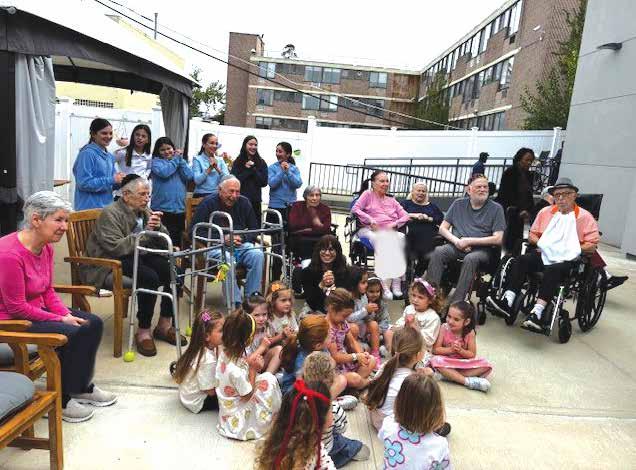
As the joyous chag of Sukkot approaches, students from Shulamith School for Girls have already begun embodying the spirit of the chag in a meaningful and heartwarming way. This past week, in a beautiful act of chessed, girls from both the preschool and middle school divisions came together for a very special project: decorating the sukkah at the Esplanade senior residence.

The highlight of the day was when the students joined hands with the residents and danced with enthusiasm, bringing
smiles, laughter, and simcha to all who participated.
The event truly embodied the essence of the mitzvah of “V’samachta b’chagecha”—to rejoice in the festival. Through decorating the sukkah, the girls of Shulamith succeeded in bringing that joy to the residents of the Esplanade. By connecting students across grades and generations in this mitzvah, it truly reflects the school’s values of chesed, achdut and limud haTorah.
Chag sameach!

On Tzom Gedalia, the Yeshiva of Central Queens (YCQ) held a powerful and poignant commemoration ahead of the second anniversary of October 7.
The Junior High School gathered for a special tekes and kumzitz in the shul. Rabbi Landsman opened the assembly by sharing his personal, firsthand experience of being in Israel on October 7, 2023. With the lights dimmed and surrounded by the glow of yahrzeit candles, students then sat in circles to reflect and daven together.
The ceremony centered on tributes to three fallen soldiers. Sophia Rakhminov (Grade 6) spoke about Omer Neutra, H”YD, a lone soldier from Plainview, NY. Aaron Chacham (Grade 7) introduced a touching video tribute to Ari Zenilman, H”YD, a brilliant father of three. Lastly,

Shalom Peled (Grade 8) presented a clip about Rabbi Avi Goldberg, H”YD, an educator and father of eight. The assembly concluded with an unforgettable message from Rabbi Goldberg’s son, who recalled his mother’s powerful directive to her children: “choose life.”
Interspersed between these moving segments, students sang their hearts out, their voices joining in unified renditions of songs and tefillot like “Acheinu” and the Mi Sheberach for the IDF. The entire event was deeply moving and left a lasting impression on all who participated,

turning a day of tragedy into a moment of unity.
Thank you to Morah Mashie Kopelowitz, Director of K-8 Judaic Studies, for organizing and to Rabbi Ophie Nat for leading the singing.
Met Council, in partnership with UJA-Federation of New York, inaugurated its 50th site, a fully confidential, professionally staffed, no-cost, one-stop center serving the community.
America’s newest and largest social services hub, located at 1271 60th Street in the heart of Boro Park, is open and serving hundreds of people each day. Built in close partnership with UJA-Federation of New York, the HUB is Met Council’s milestone 50th location and its most comprehensive, designed as a single front door for families to access help confidentially, at no cost, with an all-inclusive staff that understands the community’s needs and values.
Since the beginning of this year, the Brooklyn HUB has served over 14,000 people. That number reflects a simple truth: when you create one welcoming place where help is easily accessible, families come, and they receive the support they need with dignity and discretion. The HUB is open year-round (even open on Chol Hamoed), and walk-ins are welcome. Every service is provided free of charge, and all assistance is delivered privately and confidentially.
The HUB brings more than 20 services under one roof, so community members don’t have to navigate multiple

agencies or repeat their stories. Trained professionals guide clients through benefits enrollment and recertifications for programs such as SNAP, Medicaid, and health insurance, and also provide housing and tenants’ rights support, legal advocacy, and referrals, including immigration and access-to-benefits matters, emergency financial assistance, and specialized services for seniors and Holocaust survivors.
Everything about the HUB is built for comfort, privacy, and cultural fit. The staff is trained to serve with warmth and respect; appointments are handled discreetly; and language access ensures Yiddish, Hebrew, Russian, Spanish, and Chinese speakers are fully understood.
Whether someone needs help for the first time or is returning to stabilize longterm, the HUB makes it straightforward: one door, one team, and truly confidential care.

“This HUB is transformational for our community, and we could not have done it without the generous partnership of UJA-Federation of New York,” said David G. Greenfield, CEO, Met Council. “By bringing a welcoming, no-cost, fully confidential model to a single, comprehensive location, we’ve made it dramatically easier for families to get the help they need. More than 14,000 people have already come through our doors this year, and we’re just getting started. We’re profoundly grateful to UJA-Federation for standing with us to build the largest hub of its kind and for believing, as we do, that dignified help should be accessible to everyone.”
“When people walk into the HUB, they’re greeted by neighbors who know the community, respect privacy, and get things done,” said Avi Spitzer, Managing Director of the Brooklyn HUB. “If you need to apply for benefits, resolve a hous-
ing issue, secure kosher food, or gain skills for a better job, there’s one place to go and it’s all at no cost. Our message is simple: anyone is welcome to stop by. We’ll meet you where you are and guide you, confidentially, every step of the way.”
If you or someone you know needs assistance, visit the Met Council Brooklyn HUB, 1271 60th Street, Boro Park (across from Bingo). Walk-ins are welcome; appointments can be scheduled by calling 718-608-7065 or emailing Hub@ metcouncil.org. To learn more or sign up for services, visit metcouncil.org/hub. With the Brooklyn HUB, Met Council and UJA-Federation are setting a new standard in community care: the biggest, most comprehensive, and most confidential one-stop hub staffed by a heimish team and offered entirely at no cost to help anyone in need.


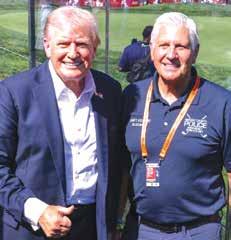

Just before Rosh Hashana, Rambam mothers gathered at school for a memorable Mom’s Night Out. The evening opened with an inspiring dvar Torah from Mrs. Aliza Feder, mother of a ninth grader, followed by a handson centerpiece workshop led by Mrs. Mozelle Goldstein, mother of an eleventh grader (@sy_in_li). Each participant went home with a beautiful arrangement to enhance their Yom Tov table and the
spirit of the chag.
The night was not only about creativity but also about connection, sparking new friendships and strengthening the bonds within our Rambam community. We are deeply grateful to the Rambam Women’s League for making it possible and look forward to many more opportunities to celebrate, connect, and grow together throughout the year.




In preparation for the Yomim Noraim, HANC High School students visited the Reinstein Family Campus in West Hempstead, NY, for a special Yom Achdut with HANC Eighth Grade students and members of the High School faculty.
The morning began with a heartfelt joint Selichot and tefillah in the beautiful Rabbi Moshe Gottesman Beit Midrash, creating a spiritually uplifting atmosphere. Following davening, Rabbi Elliot Hecht ‘90, Middle School principal, warmly welcomed the high school students and faculty. The group then enjoyed a light breakfast of doughnuts and chocolate milk.
The program continued with an inspiring Shiur Kllali by Rabbi Eli Slomnicki ‘97, Menahel of HANC High School, entitled “Why Settle for Good When You Can Have Sweet?” His shiur explored the deeper meanings behind the simanim of Rosh Hashana and set the tone for the morning’s learning.
Students then broke into smaller groups, led by current high schoolers. Each group of boys and each group of girls spent time delving into various commentaries on the simanim, fostering interactive chavruta learning. Rabbi Slomnicki later brought everyone back together to
summarize the key ideas, encourage further discussion, and offer a meaningful Yom Tov message.
Following the learning sessions, the eighth grade girls joined the high school girls for a hands-on activity, creating beautifully designed simanim platters under the guidance of Mrs. Miriam Steiner, Director of Counseling and Mechanechet for Grade 9 Girls.
The eighth grade boys remained in the Beit Midrash with Rabbi Slomnicki and their rebbeim, where they reminisced about the transformation of the high school building which they once called their middle school. Rabbi Slomnicki then led a lively and thoughtful game focused on self-reflection and peer appreciation.
The program concluded with warm exchanges of hatzlacha and shana tova between the eighth graders and high school students. The spirit of unity and mutual respect was palpable, making it a truly memorable and meaningful experience for all who participated.
All those present were excited to reunite with familiar faces and participate in such a beautiful and meaningful program. The morning concluded with eighth graders and high school students wishing each other a hatzlacha and shana tova.

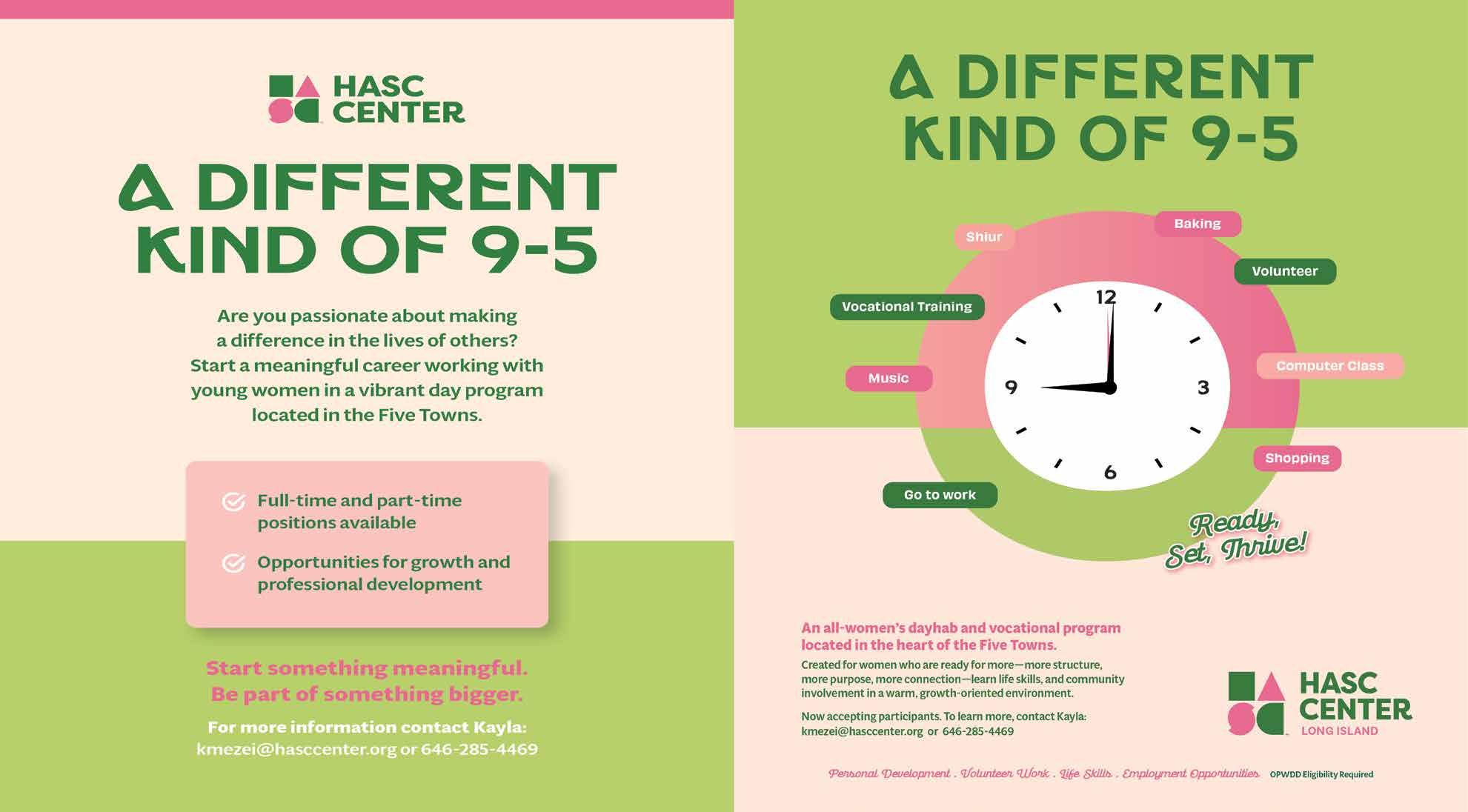


Assemblywoman Stacey Pheffer Amato was honored at a recent meeting of the Ner Tamid Society, a fraternal organization for the FDNY’s Jewish members, which includes firefighters and Emergency Medical Services providers. The Assemblywoman was applauded for her legislative work on behalf of all FDNY members.

HAFTR MS STEM always finds a way to tie back to the yom tov/ chag theme showcasing the interconnectedness of HAFTR’s curriculum. This year, our 6th graders made Cyanotype decorations for Sukkos! So neat!



tion, and
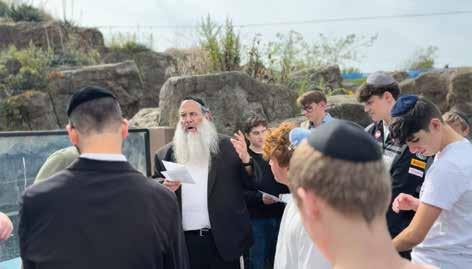

This past week, the talmidim of Yeshiva Eitz Chaim had the unique opportunity to fulfill the minhag of Tashlich with a meaningful and memorable trip to the New York Aquarium at Coney Island.
The day began with tefillah and divrei chizuk from the rebbeim, who spoke about the powerful message of Tashlich—casting away our aveiros and striving to begin the new year with a fresh start. With hearts full of sincerity, the boys walked to the nearby body of water, where they recited the Tashlich tefillos with kavanah, gazing out over the vast waters that reflect the boundless rachamim of Hashem.
Following the tefillos, the talmidim explored the aquarium, where the wonders of Hashem’s creation were on full display. From colorful tropical fish to awe-inspiring sea lions, the students were able to see firsthand the Niflaos HaBorei—the breathtaking beauty and
complexity of marine life that testifies to the wisdom and kindness of the Creator, Hashem Yisborach.
Throughout the visit, the Hanhala guided discussions about the deeper lessons that could be learned from the sea and its creatures—how each part of the Briah serves a unique purpose, and how just like in Tashlich, we can dive deep within ourselves to find areas to improve and grow closer to Hashem.
It was a perfect blend of ruchniyus and simcha, learning and inspiration, fun and connection. The boys returned to yeshiva uplifted, inspired, and with a renewed appreciation for the greatness of Hashem’s world and their own potential as His creations.
Yasher koach to the Menahel Rabbi Boruch Oppen who arranged this meaningful experience—one that the talmidim are sure to remember throughout the year.





With antisemitism an acute anxiety for Jews everywhere, a recent conversation hosted by Touro University — “Fighting Apartheid, Antisemitism, and Injustice: A Conversation With Irwin Cotler” — could not have felt more timely.
Alan Kadish, president of Touro university, sat down with Irwin Cotler, the international human rights lawyer and former Canadian Minister of Justice, for a wide-ranging discussion that hinged on antisemitism but encompassed far more: human rights, free speech, shifting partisan sentiment on Israel and social media, to name a few.
Cotler is international chair of the Raoul Wallenberg Centre for Human Rights and served as counsel for prisoners of conscience like Nelson Mandela and Natan Sharansky. “My father taught me that pursuing justice is equal to all the other commandments combined,” Cotler shared. His mother urged him to fight injustice outside his own community. And so he did. Cotler engaged deeply with two great human rights struggles of the past century: for liberty in the former Soviet Union and against apartheid in South Africa.
“I see the struggle for Soviet Jewry as a model for what a critical mass of advocacy can accomplish,” said Cotler. He pointed to Natan Sharansky as emblematic, noting that Sharansky advocated not only for Jewish refuseniks but for
other persecuted groups, too.
These experiences give Cotler unique perspective on the eruption of antisemitism following October 7, 2023 — though he maintains that Jew-hatred was flourishing before Hamas’ horrific attack.
“There was a tripartite paradigm at the time: antisemitism from the far right, the far left and radical Islam,” Cotler said. “There was increasing normalization of anti-Jewish attitudes in politics, media and academia, and waning solidarity from traditional allies.”
All that, before October 7. The global reactions that followed that day — paltry condemnations, outright justifications — were far more stunning.
Antisemitism—A Menace to Democracy
Having laid out the scope of the problem, Cotler turned to remedies. Key to his approach: communicating that antisemitism is not only a threat to Jews but a menace to democracy.
“This will take a whole-of-government and whole-of-civil society approach,” he said. “Federal, state and municipal authorities need to work in tandem to fight antisemitism. We need action across party lines: Antisemitism should be an obvious common cause, yet we’re seeing it weaponized for political gain.”
Kadish raised an important nuance: While most Democrats in Congress still support Israel, polls show such sentiment does not extend to the Democratic elec-
torate. And, he said, educational environments at both the K-12 and university levels function in ways that, intentionally or not, support antisemitic views.
Cotler did not disagree, citing an alarming poll showing that more people in the 18–24-year-old demographic support Hamas than do Israel.
If the American landscape is troubling, the Canadian one offers examples of proactive measures.
“In Canada, we’ve recommended adopting and implementing the International Holocaust Remembrance Alliance’s (IHRA) working definition of antisemitism — the most comprehensive and democratically-adopted one out there,” said Cotler. The government has also produced a manual for antisemitism awareness training within governments, universities and elsewhere.
Turning around attitudes is important. But what of the young people not in municipal buildings or classrooms, who mostly get information from social media?
“Online incitement leads to offline hate crimes,” said Cotler. “I am an apostle of free speech, but the First Amendment does not protect all speech. We must fight hate speech at every turn.”
Of course, an organizing centerpiece of any human rights effort is the U.N., which has lately been far from friendly to Israel.
“I’ll never forget what then-Secretary General of the U.N. Kofi Annan said when

I was minister,” said Cotler. “He said, ‘A U.N. that does not put fighting antisemitism at the forefront of its policy is a U.N. that has betrayed its past and forfeited its future.’”
Today, Cotler argued, the U.N. has drifted far from that vision, electing to its human rights council rights violators like Russia and China and arguably institutionalizing antisemitism. Yet even as he condemned the U.N.’s failings, he insisted that continued engagement is important to remind the organization of its founding ideals.
After Kadish presented Cotler with a generous citation, the latter closed with a Mishnaic reference.
“We’re taught ‘lo alecha ham’lacha ligmor,’” he said. “We don’t have to finish the task, but it’s incumbent on us to pursue justice without desisting.”

By Chaim Gold
The mother of Rav Nosson Tzvi Finkel, zt”l, the famed Rosh Yeshiva of Mir, was once asked, “What did you do to be zoche to such a son?” She replied, “I am not sure what I did, but I can tell you one thing, I complimented him all the time!!”
“A compliment, a positive word can have a profound impact on others, above and beyond what we could have ever imagined! Let’s us all try to positively engage in chessed with our words.”
These passionate words were said by Rav Smith, Maggid Shiur, Daf HaYomi B’Halacha, on the pre-Rosh Hashana videocast in conjunction with Dirshu’s Eleventh Annual International Yom Limud and Tefillah held on the yahrtzeit of the Chofetz Chaim, Wednesday, 24 Elul/ September 17.
Other prominent speakers on the videocast were HaGaon HaRav Chaim Mordechai Ausband, Rosh Yeshiva of Yeshiva Ateres Shlomo, Rav Dovid Hofstedter, shlita, Nasi of Dirshu, and Rav Eytan Feiner, Rav of Kehillas Knesses Yisrael of Far Rockaway-Lawrence.
Another fascinating part of the videocast was the unique footage of HaGaon HaRav Michel Yehuda Lefkowitz, zt”l, Rosh Yeshiva of the Ponovezh Yeshiva L’Tzeirim and one of the most insightful mechanchim of bachurim in his generation, answering questions about and discussing the rebbi-talmid relationship.
The videocast was punctuated with inspirational niggunim of hisorerus in advance of the Yamim Noraim.
Purpose of the Yom Limud and Tefillah
The Yom Limud and Tefillah was established to designate the yahrtzeit of the Chofetz Chaim as a day to bring chizuk and hisorerus to Klal Yisrael in advance of the Yamim Noraim through the message of the Chofetz Chaim.
For the eleventh year, the Yom Limud and Tefillah has successfully brought all of Klal Yisrael together specifically on the auspicious occasion of the Chofetz Chaim’s yahrzeit just before Rosh Hashanah in unified tefillah on behalf of Klal Yisrael and to encourage the continued learning of the Chofetz Chaim’s sefarim that have such power to invoke rachmei shamayim
This year, perhaps more than in any previous year, the Yom Limud and Tefillah resonated in a more profound way – as Yidden are under attack both in Eretz Yisrael and around the world, just because they are Jews.
On the Yom Limud and Tefillah, Yidden throughout the world said perakim of Tehillim beseeching Hakadosh Baruch Hu to have mercy on Klal Yisrael and learned halachos from the Mishnah Berurah and the sefer Shemiras Halashon both authored by the Chofetz Chaim. “The zechus of limud haTorah, tefillah and the extra sensitivity in matters of speech will certainly serve as a shield for Klal Yisrael in the upcoming Yom Hadin,” said Rabbi Avigdor Bernstein, a senior member of Dirshu’s hanhalah.
Rav Zev Smith: Using Our Words for Chessed
Rav Zev Smith raised an important aspect of how to use one’s speech. He highlighted the importance not just of refraining from forbidden speech such as lashon hara but stressed how much chessed can be done through speech. He related a story of a woman, the mother of a large family, who began to feel unwell. She went to the doctor, who ran a battery of tests. The next day the doctor called her and asked her to come down to his office. When she arrived, he told her the diagnosis: cancer! He then mapped out a very aggressive treatment plan that could potentially save her life.
That woman came home from the doctor and realized that despite everything her large family needed supper. She decided to take them all out to a local pizza shop, planning to break the news to her family over supper. Before she even had a chance to break the news to them, she first got them settled with their food. Then, as she got up to bring something to the table, a woman who was observing her family, came over and said, “You have such a wonderful family! I have been watching them, and I am so impressed. You should be gezundt, healthy and have nachas!”
The mother related that what kept her going for the next two and half years of excruciating treatments, chemo and radiation were the heartfelt words, “You should be gezundt, healthy and have nachas!”
“The unbearable had become bear-


able,” thundered Rav Smith. “Why? Because of chessed b’dibbur, chessed with words!”
Rav Dovid Hofstedter: Learning from What We Have Done Right
Rav Dovid Hofstedter, Nasi of Dirshu, commented on the previous year through the lens of a Torah perspective. “These days before Rosh Hashanah and during the Aseres Yemei Teshuvah offer us an opportunity to reflect on the past year and look deeply into ourselves as a tzibbur so that we can potentially discern what we need to improve in the year to come.
“In all truth, Klal Yisrael experienced many miracles this year. Yes, there were numerous tragedies and losses this year, r”l, but at the same time, there were so many yeshuos! Klal Yisrael saw the Yad Hashem!
“The Gemara in Eruvin teaches that every Jew should constantly analyze his own conduct and see what he can improve. Even in the good things that he does, he should try to see what he can do better.
“Perhaps we can suggest that now is the time to analyze what we have been doing that is RIGHT. Why? So that we can be encouraged to continue in that path and build on it.
“We know that the world stands on Torah, avodah, and gemilas chassadim. This past year we all davened for Klal Yisrael. We invested our hearts and souls in tefillah. There was the war in Eretz Yisrael, the hostages, the losses. We davened with more kavanah and more heart.
“We also learned more Torah. Since the war in Eretz Yisrael began, look how much Torah has spread nationally and internationally. There is the Amud HaYomi that has spread to all corners of the globe and so many other important Torah programs.
“And what about gemilas chassadim?
When there were cuts in funding for yeshivos from certain sources, what did Klal Yisrael do? They gave and they gave!
“We should take encouragement from all of these and realize that Hashem looks favorably on these actions, and we can build on them going forward.”
One of the especially notable aspects of the Chofetz Chaim’s yahrtzeit was the special Yom Limud and Tefilla programming for children which was created with the singular goal of connecting children to the teachings and life of the Chofetz Chaim. In North America alone, more than 100 schools held special sessions of learning from the legacy of the Chofetz Chaim while in Eretz Yisrael and Europe similar programming was held in many hundreds of schools!
Throughout diverse communities across the United States and Canada, a wide range of some 150 schools representing the entire panoply of Orthodox Jewry participated in the Yom Limud and Tefillah school programs. Whether it was Ashkenazim, Sefardim, chassidim, yeshiva types, Day Schools, Chadarim, Bais Yaakovs; all were represented at Dirshu’s Yom Limud and Tefillah. They include schools hailing from communities such as Monsey, NY; Lakewood, NJ; Brooklyn, NY; Manhattan, NY; Toronto, Canada; Houston, TX; Baltimore, MD; Cleveland, OH; Waterbury, CN; Phoenix, AZ; Passaic, NJ; Denver, CO; Boston, MA; Los Angeles, CA; and Providence, RI and so many more.
The Yom Limud and Tefillah is another way that Dirshu is unifying young and old all over the world to invoke rachamei shomayim in advance of Rosh Hashanah.



1. There is only letter of the alphabet that doesn’t appear in any of the U.S. state names.
2. In English, there is only one word that ends with “mt.”
3. The microwave oven was invented after a researcher walked by a radar tube and a chocolate bar melted in his pocket.
4. More Monopoly money is printed every year than real U.S. currency.
5. New York City’s Central Park is larger than Monaco.
6. A million seconds is 12 days; a billion seconds is 31 years.
7. The darker the coffee roast, the less caffeine it contains.
8. Oreo cookies were invented 25 years before chocolate chip cookies.
9. The national animal of Scotland is the unicorn.

10. When the two numbers on opposite sides of a dice are added together the answer always equals 7.
11. The first U.S. coin in circulation said “Mind Your Business” instead of “In G-d We Trust.
12. Bubble wrap was originally invented to be wallpaper.
13. A driver traveling at 60 MPH takes 1 second to pass 88 feet of the road.
14. The U.S. Supreme Court once ruled that tomatoes are legally vegetables.
15. The inventor of the Pringles can is buried in one.
(Did you really look at this before looking at the facts? Have you no shame? Now you are getting defensive…which means that you for sure cheated!)
Yankel, who has terrible hearing, has just gotten an amazing hearing aid. He goes to his friend to tell him about it. Yankel tells his friend that unlike everybody else who just get regular hearing aids, he found a special type of hearing aid that is amazing.
“It is hidden in the ear and not visible; it can never
break and is totally comfortable. Besides, the power is amazing. I am hearing like a 20-year-old again. I can finally carry on a good full conversation without any problems,” says Yankel.

His friend is intrigued about this hearing aid and asks, “What kind is it?”
Yankel looks at his watch. “Quarter to three.”

The Rebbe Expert: “Tracht gut vet zain gut. The Rebbe said it: just think positive” (Settle down, you just discovered the Ohel two weeks ago, now you think you’re the Rebbe’s Ambassador!)
The Tough-Love Coach: “Stop whining. Just do it. No excuses. Failure isn’t an option!” (We get it – you once watched a show on military training.)

The It’s All About Me Friend: “OMG, that happened to me once! I totally know what you’re going through. So anyway, let me tell you my story...” (You are so 1998! You are actually making this about you?).
The Spiritual Guru: “You need to align your chakras and cleanse your aura. Try burning sage, meditating for 6 hours, and drinking only moon-charged water.” (If you’re so worked out, why haven’t you been able to hold a job for more than two weeks?)
The Cynic: “Honestly, nothing matters, so why bother? Just order pizza and binge-watch something. We’re all doomed anyway.” (How many times does war need to not break out for you to relax for a change?)
The Overthinker: “OK, the first thing you need to do is list every possible outcome of your decision.” (Should we also create a color-coded flowchart?)
The Drama Queen: “Oh my gosh, that sounds like a total disaster! If I were you, I’d move to another city and change my name immediately.”(Thanks! Memo to self: never ask this person anything beyond “What time is it?”)
The “Just Be Yourself” Guy: “All you need to do is be yourself. Totally. Just be your authentic self.” (Well, sometimes the authentic self is…well…not so great. Shhh! Don’t tell anyone that I said that!)
The Life Coach-in-Training: “What you need is a vision and a 5-year plan. Start every day with gratitude and manifest
your dreams!” (You know that you are not even a social worker, right?)
The “Old-School” Grandpa: “Back in my day, we didn’t have these fancy solutions. We just got the job done!” (Thanks, Grandpa…I’ll try to find a time clock so we can go back to 1917.)
The “Always Busy” Friend: “Listen, I would help, but I’ve got a ton going on. Just trust your gut. Gotta run!” (Yep, you need to run to get some cholent at Bingo and frantically eat it in your car in the parking lot…the busy guy!)
The Motivational Poster Friend: “If opportunity doesn’t knock, build a door!” (Glad to see that you are learning from your coffee mug!)
The Mom Friend: “Have you eaten? You need to eat something. Let’s not make any decisions on an empty stomach.” (The advice might be unhelpful, but hey, at least you get a sandwich.)
The Always Overly-Cautious Type: “I wouldn’t do anything yet. Let’s wait it out, see what happens. You never know… it could get worse.” (Suddenly, doing nothing feels like a monumental task.)
The Over-Apologizer: “Sorry, I don’t know what to say. Sorry, if that’s not helpful. Sorry, I’m bad at this.” (If you say sorry one more time, I’ll know that you are reaaaallly a mess!)
The Social Media Influencer: “I did a reel about this the other day! Just stay #blessed, and don’t forget to tag me when you succeed! Like guys, I’m sitting here alone and thinking about Hashem!? Like OMG! I’m really inspired right now! You totally have to try this restaurant that I went to last night for a soft opening…” (Somehow, their advice comes with a 10% discount code.)
The Philosopher: “What even is a ‘problem,’ you know? Like, are we not all just floating through time and space, reacting to stimuli?” (Bro, the dude just has a flat tire!)



By Rabbi Shmuel Reichman
Afather set out one day to teach his young daughter a powerful lesson. When she woke up in the morning, he showed her a mirror and asked her, “What do you see?”
She smiled and answered, “I see myself!”
He then took her to the window and asked her, “What do you see now?”
“I see houses, and trees, and grass, and a whole world outside,” she said, this time with a sense of wonder and joy in her voice.
That night, before tucking his daughter into bed, the father again brought her to the mirror.
“What do you see?”
“I still see myself,” she answered, a bit confused as to why they were doing this again.
He then took her back to the window. “What do you see now?” he asked.
“I see…me?” she answered, suddenly very confused. “Did the window turn into a mirror?”
“Be patient, stay focused, and keep on staring at the window. What do you see?”
After a long, silent moment, her eyes lit up. “I finally see it! I see houses and trees and the world outside!”
Her father smiled and explained to his daughter:
“Sometimes, we get so caught up in our own lives that we think everything in life revolves around us; instead of seeing the true nature of things, we see everything as a mirror of ourselves. As a result, we project our views onto everything we see and everything we hear. We each need to learn how to peer past the surface, past ourselves, and see the endless beauty, wisdom, and depth that lies beneath that surface. When we do so, we turn the mirror into a window, revealing a world of depth behind it.”

The journey from Rosh Chodesh Elul through Yom Kippur is a forty-day experience of self-awareness, teshuva, and spiritual growth, whereby we come closer than ever to Hashem and our true selves.
This process of closeness culminates in the holiday of Sukkos, which represents the ultimate connection between Hashem and the Jewish People. The center of this connection is the sukkah, which represents the marriage canopy as Klal Yisrel marries Hashem. As we approach this time of closeness, let us delve into the meaning of the sukkah and the lessons it holds for us.
Chazal enigmatically compare the schach of the sukkah to the ideal form of beauty. What does this mean?
The spiritual concept of beauty, and its relevance to marriage, is central to the connection we aim to develop through the process of Sukkos. In order to understand this connection, let us delve into the spiritual concept of beauty. To do so, we must understand the unique beauty of Sarah Imeinu.
Sarah Imeinu
Sarah Imeinu was the most beautiful woman in the world. We know Sarah was physically beautiful, that her beauty was not just of an ethereal, spiritual nature. When Sarah and Avraham descended to Mitzrayim, the Mitzrim, and even Pharaoh himself, desired her (Bereishis 12:14-15. See Rashi). The Egyptians were steeped in immorality, interested only in beauty that ran skin deep. However, we know that Sarah Imeinu was immensely spiritual as well, that she reached the loftiest of spiritual levels (See Rashi, Bereishis 23:1).
At the end of Parshas Noach, Rashi (Bereishis 11:29) explains that one of Sarah’s other names was Yiskah. A name always reflects essence, so we must ponder the meaning of this name and what it reveals about Sarah Imeinu. “Yiskah” means transparent, and Sarah’s true beauty lay in her transparency. Her inner beauty completely permeated and was loyally reflected through her physical body. Genuine beauty requires
the middah of transparency, where the physical body reflects the inner and spiritual beauty, something infinitely greater than any external beauty. True beauty is oneness, where the physical and spiritual are in cohesion, where the physical doesn’t hide the inner self but reveals it! It is therefore fitting that the shoresh of the word “Yiskah” is also the shoresh of the word “schach,” the roof of the succah. According to halacha, the schach is the most important part of the sukkah, which is why “schach” is the shoresh of “sukkah” as well. What, then, is the connection between transparency and schach? The answer lies in one of the deepest themes of Sukkos. Sukkos is about seeing past the illusion of independent self-security, recognizing that Hashem is our true source of protection. This is why we leave our sturdy homes and enter a diras arai, a temporary dwelling place. We show that our faith and trust lie in Hashem, not our “safe” homes. While on the surface, our security and safety seem to come only from our own efforts and hishtadlus, when we look past the surface, we recognize that everything comes from Hashem. This is why the schach is the main part of the sukkah; it trains us to see past the surface. The schach must be transparent, allowing you to see the stars at night. It must also be loose enough to allow some sunlight and rain to enter the sukkah. Only when we have a transparent surface can we truly see what lies behind it.
The Two Stages
Amongst the Yamim Noraim, Sukkos is an anomaly. Rosh Hashana and Yom Kippur are overtly spiritual and transcendent days, with intense rounds of
prayer and spiritual elevation. Sukkos, on the other hand, is grounded in the physical. The centerpiece of Sukkos is a physical object – the lulav we shake – and much emphasis is put on going through our physical routines in a physical hut. It is the Zman Simchaseinu, a time of physical joy and festivities, highlighted by the celebrations of the simchas beis hasho’eivah. How is this the ultimate culmination of the spiritual growth we have worked towards throughout the last month and a half?
The answer to this question is the secret behind the power of Sukkos, as well as a fundamental principle in Jewish ideology.
While the physical can be dangerous if misused, the ideal is not to transcend the physical, but rather to use the physical in order to reflect something higher. Think, how many mitzvos are commandments of the mind? Almost none. You can count them on your hand: Believe in Hashem, love Hashem, be in awe of Hashem, don’t be jealous, and just a few more. The overwhelming majority of mitzvos are physical actions which connect you to the spiritual source, Hashem! The act is physical, while the spirituality and mindfulness is contained
within that physical act. We eat matzah, shake a lulav, blow shofar, and wear tefillin – all actions, all physical. We don’t believe in transcending the physical; we believe in using the physical to connect to the transcendent.
Sukkos embodies this lesson in embracing the physical. The purpose of this physical world is for us to use everything it has to offer for a spiritual purpose. This requires us to immerse ourselves in the physical world, but for this immersion to be proper, we must maintain control and focus while using the physical. In other words, our root must be transcendent, grounded firmly in the spiritual, and then atop that foundation we can descend into the physical and use it in a transcendent way. This is the key behind the process we undertake through the Yamim Noraim.
We first experience Elul, then Rosh Hashana, and then Yom Kippur, a developmental process of raising ourselves higher and higher above the physical world and deeper and deeper into the spiritual world. It is only once we create this transcendent root that we then re-immerse ourselves into physical living, but this time on an entirely new scale. We must infuse the totality of our

spiritual acquisition into our physical life, elevating our actions and intentions as we move this physical world towards its ultimate spiritual root. Sukkos is the ultimate expression of this ideal, as we infuse the entirety of our spiritual gains from Elul, Rosh Hashana and Yom Kippur into a physical life of connection with Hashem inside the sukkah. It is in that simple and mundane hut that we draw the connection between the transcendent spirituality we just experienced and the elevated physical existence we are about to throw ourselves into. This is how a Jew lives a life of spirituality.
This is the most powerful message of life. There are always two levels of reality: the surface level and the deeper, spiritual level. The surface is meant to reflect the spiritual, reveal it, emanate its truth and beauty. But often, we struggle, we forget, we get caught up in the deception that the surface is all that there is. But even when we fail, even when we fall, there is always hope, there is always a path back to our true selves. This is the message of Sukkos; this is the message of life. To strive to see more, feel more, learn more, become more.
May we all be inspired to not only see
past the surface but to then reveal that truth through the surface, to live holistic lives of truth, spiritual beauty, and true oneness.
Rabbi Shmuel Reichman is the author of the bestselling book, “The Journey to Your Ultimate Self,” which serves as an inspiring gateway into deeper Jewish thought. He is an educator and speaker who has lectured internationally on topics of Torah thought, Jewish medical ethics, psychology, and leadership. He is also the founder and CEO of Self-Mastery Academy, the transformative online self-development course based on the principles of high-performance psychology and Torah.
After obtaining his BA from Yeshiva University, he received Semicha from Yeshiva University’s RIETS, a master’s degree in education from Azrieli Graduate School, and a master’s degree in Jewish Thought from Bernard Revel Graduate School. He then spent a year studying at Harvard as an Ivy Plus Scholar. He currently lives in Chicago with his wife and son where he is pursuing a PhD at the University of Chicago.
To invite Rabbi Reichman to speak in your community or to enjoy more of his deep and inspiring content, visit his website: ShmuelReichman.com.

By Rabbi Avrohom Sebrow
With many people traveling for Sukkos and the winter season, it’s appropriate to review some of the halachos of davening on a plane. Those learning the Daf may not realize how this discussion stems directly from our Gemara — but the connection is plain to see.
Our Gemara discusses the laws of Avodah. Avodah performed by Kohanim in the Beis HaMikdash while sitting is invalid (Zevachim 23b). It is viewed as if a non-Kohen performed the Avodah. Similarly, the Gemara in Sotah (38a) states that Birchas Kohanim must be recited while standing, since the Torah compares Birchas Kohanim to the Avodah. Rabbeinu Yitzchak (quoted in Tosfos) explains that a Kohen who blesses the congregation while sitting accomplishes nothing. He takes the Gemara’s comparison to its fullest extent: just as Avodah performed while sitting is invalid, so, too, Birchas Kohanim recited while sitting is ineffective.
The Panim Meiros (quoted in Shaarei Teshuva OC 126:25) takes this further. If a Yisrael goes up with the Kohanim to bless the congregation, he violates a mitzvas asei. The Panim Meiros suggests that a Kohen who duchens while sitting may likewise be in violation of this mitzvah. The Mishnah Berurah rules that a Kohen who cannot stand without leaning should not duchen at all.
So what does this have to do with davening on a plane?
The Shulchan Aruch (OC 98:4) writes (loose translation): Tefillah is in place of a korban. Therefore, one should concentrate as if actually bringing a sacrifice. Improper intent can invalidate a korban. Likewise, Shemoneh Esrei should be recited while standing, just as the Avodah was performed standing. One should have a fixed place for davening, just as each korban had a designated place. It is also proper to have special clothing for tefillah, just as the Kohanim had specific garments for

the Avodah. However, not everyone can afford this.
From these words, we see that if one fails to daven in special clothing, he has still fulfilled his obligation. But what about standing? Should sitting during Shemoneh Esrei be treated as a mere deficiency, or does it invalidate the tefillah?
The Shulchan Aruch answers in another place (94:4): If a person is riding
bidden — because donkeys are the original self-driving vehicles.)
The Shulchan Aruch continues: So, too, if someone is on a boat or wagon, if he is able to stand, he should do so; otherwise, he may sit.
Everything depends on the route, his comfort, and his state of mind. Some are stringent that one should at least stand for the first three brachos, and it is best to
If one is davening on a bus, he may step off when the bus reaches his stop even in middle of Shemoneh Esrei.
on a donkey, he need not dismount but may daven while riding. The Mishnah Berurah explains that requiring him to dismount would cause him to rush and lose focus. Chazal therefore permitted davening while riding. HaRav Shlomo Zalman Auerbach, zt”l, however, ruled that one should not daven while driving, since distracted driving can be dangerous. (Davening on a donkey was not for-
follow that view. The Rema adds that even one who sits for Shemoneh Esrei should at least stand for the bows and for the three steps afterward.
The halacha is clear: in pressing circumstances, one may daven Shemoneh Esrei while sitting. HaRav Shlomo Zalman ruled that this applies to an airplane as well. Standing is difficult, if not impossible, and davening in the aisle or by the
bathrooms both disturbs others and compromises kavana.
The Rema also writes that if one cannot step back at the end of Shemoneh Esrei while riding, he should have the animal take three steps backward. Rav Shlomo Zalman extended this to a wheelchair: one should roll back the distance of three steps. This applies equally to someone davening in a car. So the next time your flight circled the airport before landing, perhaps the pilot was just taking three steps back!
The sefer Ishei Yisrael records questions asked to Rav Chaim Kanievsky, zt”l, for which a written response was received. A few are directly relevant:
If one is davening on a bus, he may step off when the bus reaches his stop even in middle of Shemoneh Esrei. This is no worse than davening while traveling, which the Shulchan Aruch permitted.
If one can daven Mincha sitting before sunset or standing only after sunset, which is preferable? Rav Chaim ruled that davening before sunset takes precedence.
If one can daven Maariv after Plag HaMincha standing or after nightfall sitting, which is preferable? Rav Chaim ruled that it is better to daven after Plag while standing. Also, it is better to daven after chatzos standing than before chatzos sitting, even though typically davening after chatzos is considered transgressing the words of the sages.
The Shulchan Aruch concludes that if one davened Shemoneh Esrei while sitting and later reaches a proper place where he can daven standing, he should repeat Shemoneh Esrei. The Mishnah Berurah, however, writes that our minhag is not to repeat.
May all our tefillos take flight and soar to new heights.
Rabbi Avrohom Sebrow is a rebbe at Yeshiva Ateres Shimon in Far Rockaway. In addition, Rabbi Sebrow leads a daf yomi chaburah at Eitz Chayim of Dogwood Park in West Hempstead, NY. He can be contacted at ASebrow@gmail.com.

By Rabbi Yair Hoffman
Do we really want the Geulah to happen now? If so, we best be knowing these halachos about Sukkos in the Beis Hamikdash because otherwise we are going to be looking pretty clueless.
The Nisuch HaMayim was done every day of Sukkos.
1. It is a Torah mitzvah to pour a minimum of 3 lugim of water as a libation on the Mizbe’ach on each of the days of Sukkos. A lug is the equivalent of 6 medium eggs. The water was in addition to the wine libations. This mitzvah is a Torah mitzvah but it is derived Halacha L’Moshe Mi’Sinai. According to the Chazon Ish, the volume of the 3 lugim would be 1.8 liters. According to Rav Moshe Feinstein, it would be about 1.6 liters, and according to Rav Chaim No’eh, it would be about 1.1 liters. There is no upper limit to this mitzvah, but the Chofetz Chaim writes (Likkutei Halachos Sukkah 29a) that if one uses less than 3 lugim, one has not fulfilled the mitzvah.
The procedure was as follows:
2. At the call of the rooster, which was either slightly before dawn (Tosfos Sukkah 51b acc. to Maharsha) or at dawn (Same Tosfos acc. to Maharshal), two Kohanim would stand at the Niknor Gate (the upper gate) and blow a tekiah, a teruah and a tekiah from trumpets.
3. They would then go down to the Ezras Nashim and blow again, but they did even more Tekiyos until they reached the gate through which one exits to the east, from the Ezras Nashim to the eastern slope of Har HaBayis.
4. (What follows is mentioned in the Mishna but is left out in the Rambam. The Aruch LaNer writes that in the future Beis Hamikdash it will not be said, and this is why the Rambam left it out.) When they reached the gate through which one exits to the east, they turned from facing east to facing west, toward the Kodesh HaKedoshim, and said: “Our ancestors who were in this place (during Bayis Ris-

hon) who did not conduct themselves appropriately stood with their backs toward the Sanctuary of Hashem, and their faces toward the east; and they worshipped the sun toward the east” (Yechezkel 8:16). But we, our eyes are to Hashem.” Rabbi Yehuda says that they would repeat and say, “We are to Hashem, and our eyes are to Hashem.”
5. Before dawn, those who drew the water would go down to the Maayan HaShiluach, also known as the spring of the Gichon, which was located to the south of Har HaBayis. They did not blow the trumpets at the Gichon. The trumpets were only blown in the Mishkan, notwithstanding the simpler implication of the pasuk in Yishayahu 12:3: “Ush’avtem mayim b’sasson, mimaanei hayeshua,” that the drawing should be done in joy. Chazal had a tradition that all of the trumpet blasts must only be done in the Mikdash. They, therefore, only blew when they left the Mikdash and when they returned to it. They did not use the spring that was under the Azarah in order to publicize it more since the Tzedukim were against the idea of the water libations. This is
discussed in the pasuk in Yishayahu 12:3 mentioned before. The mayanei hayeshuah is the Gichon.
6. The mitzvah to blow trumpets in joy at the filling of the water in accordance with the aforementioned pasuk, but once again, it was only blown in the Mikdash itself.
7. The water was transported in a golden vessel that was sanctified. However, the Shabbos libations were obtained on Friday and were transported in an unsanctified golden vessel so that there would not be a problem of the water being in a sanctified vessel overnight.
8. They brought it back to the Azarah going through the Sha’ar HaMayim, the Gate that was called for this very purpose. This could have been done by a Kohen or a Yisroel.
9. There is a debate in the Rishonim whether it needed to be drawn specifically from a spring (Tosfos, Meilah 12b “Hikdish”) or whether it was permitted to be drawn from a bor (Rambam Bi’as Mikdash 5:14).
10. When the time for the libation of the water came during the Korban Tamid,
the Kohen with the water went up to the Mizbe’ach with the Kohen who had the wine libation and they would pour out simultaneously into the two small silver cups located at the southwest corner of the top of the Mizbe’ach. These cups were used to receive the libations. The wine libation was poured into one of the cups on the right of the water cup (this was done daily at the completion of the Korban Olah and the Korban Shlamim). The other cup which was most toward the corner was for the water libation which was done only during Sukkos. These two cups each had an exit nozzle on the bottom –a smaller hole for the one for water than for the one for the wine to drain through. This was so when the wine and water libations were poured simultaneously, the contents of both cups would drain out at the same time. The Steipler Rav (Kehilas Yaakov Taanis Siman 1) writes that it had to be simultaneous because the Nisuch was one mitzvah.
11. When the water libation was poured, the Kohen was told, “Hagbeh es yadcha, hold your hand high!” This was enacted (see Sukkah 48b) because a Tzaduki Kohen once poured it on his feet and those observing it pelted him with their esrogim.
12. Reish Lakish was of the opinion that when they poured wine onto the altar, they plugged the top of the drainpipes (Yerushalmi – the bottoms of the cups) so that the wine does not descend to the depths, in order to fulfill that which is stated: “In sanctity shall you pour a libation of strong drink [shekhar] unto Hashem” (BaMidbar 28:7). The Ohr Same’ach Tmidim (10:8) holds that this was only done on Sukkos according to Raish Lakish but not during the year.
This article should be viewed as a halachic discussion and not practical advice. The author can be reached at yairhoffman2@ gmail.com.

It was brutal.
Over Rosh Hashana, I shared a room with my oldest great-granddaughter Dalia Leah, 5, in my son and daughter-in-law’s house. The second morning, she asked me if I would have come from Israel to Woodmere had Grandpa not died.
“No,” I said.
Her wise-eyed silence comforted me; she understood. Her emotional intelligence somehow did not surprise.
Having the “High Holidays” right after great loss has been indescribably difficult; there are no words that can adequately describe the range and depth of emotions that coursed through my mind and body as I tried to focus on my tefillah. Connecting to the words in the Machzor was nearly impossible.
The core Deutsch family davened in the Young Israel of Lawrence-Cedarhurst’s, YILC, newly formed Yeshiva Minyan; we were privileged to be led by the beautiful soulful voice of Rabbi Dr. Elly Deutsch, son and grandson, as he delivered the tefillah for the olam. Modeled after his chazzan Uncle Josh Shapiro and Rabbi Yisroel Kaminetsky, Elly made us all so proud.
I hung onto his every word, hoping to connect through his sincere and meaningful singing; it was harder than I had imagined.
Growing up in Williamsburg and East New York (a neighborhood on the outskirts of Crown Heights), I remember the various shteibels where my family davened for the chagim. The main sanctuary was usually dark and cramped, and there were long, heavy pews for seating. The women sat upstairs behind thick white curtains. If I close my eyes, I can still feel the weight of my father’s tallis over my head when the kohanim duchened. All of the dads would protect their children in this same way. They strongly cautioned their precious children not to look at the kohanim. I don’t really recall what my dad said would happen if I peeked out of the tallis, but I clearly remember his tightly drawn face as he held us close.

By Barbara Deutsch

Bob described similar childhood shul experiences. It was one of the things that initially connected us.
When we got engaged, Bob gifted me with machzorim for Rosh Hashana and Yom Kippur. He had them engraved with my new name that matched my changed status. The book covers were quilted, white and embellished with
close. Every chag, we alternated staying with each set of parents. My precious machzorim went with me.
That Rosh Hashana during the tefillah, I kept losing my place. I was unable to follow the chazzan and kept turning pages back and forth, back and forth. It was all so confusing. Plus, the shofar blowing protocol was in all the wrong places.
As I swing between joy and despair, I feel a lot like I did all those years ago looking for the right page in the machzor.
gold raised letters that spelled out “Barbara Deutsch.”
Those machzorim were mighty fine; I loved and cherished them. I davened from them every New Year for many years.
I don’t remember when or why we changed shuls. It might have been because we moved neighborhoods or our shteible closed down, but one memorable year we found ourselves in the Young Israel of Redwood in Canarsie, Brooklyn. Both our parents lived in parts of Canarsie that were adjacent but not too
I could not find the place.
Ridiculous as this scenario may seem in retrospect, I continued to use my special machzor, despite the confused davening, for a few more years.
One day, in a chance after-shul conversation with Bob, I mentioned that I needed to take lessons in the machzor; I cannot follow the chazzan no matter how hard this poor excuse for a yeshiva girl tried.
Bob looked at me like I had two heads, examined my machzor, and started to laugh. It turns out that my
machzor was Nusach Sefard, and we were now members of a shul that davened Nusach Ashkenaz.
How was I supposed to know that there was a difference? Aren’t all machzorim the same?
It turns out that Nusach Ashkenaz is the older, more traditional Jewish prayer rite primarily used by non-chassidic Ashkenazi Jews, while Nusach Sefard is a chassidic adaptation of the Sephardic rite, incorporating elements from the Arizal’s kabbalah and mixing them.
Hence the confusion.
During this chag’s Mussaf, a phone started to ring – not just once but twice. We attribute the phone ringing to Bob’s neshama at work. He has been very busy. In the time since his passing, he flooded the toilets in the KBM shul during the shiva Shabbos, lost my daughter-in-law’s credit cards and driver’s license, and right after Rosh Hashana, escorted a brand new beautiful baby girl into this world.
Our granddaughter Ayelet and husband Daniel left for the hospital right after yom tov; another branch was added to the Deutsch/Levy family tree. Mazal tov! Mommy and baby are doing well. Big brother Eliezer is happy and excited, for now.
As I swing between joy and despair, I feel a lot like I did all those years ago looking for the right page in the machzor. I get where I have to go, but getting there is very confusing. I am lost. I am not sure where I will land. I am lucky to have the love and support of dear friends and family surrounding me.
“Dalia, it’s really hard, but I’m as good as I can be right now here with you.”
Barbara Deutsch is the former associate principal at HANC, middle school principal at Kushner, and Dean of Students at Yeshiva of Flatbush. A not-retired educator, she is trying to figure out life in Israel through reflections on navigating the dream of aliyah as a wife, mother, grandmother, great-grandmother and friend.

By Gedaliah Borvick


Kibbutz Tirat Zvi holds a special place in my heart. In 1984, I spent an unforgettable month of Nissan working there, gaining an insider’s view of a community steeped in history and purpose.
Located in the Beit She’an Valley, just west of the Jordan border, Tirat Zvi was established in 1937 as part of the “tower and stockade” movement. This initiative was a strategic response to the British Mandate government’s attempts to appease the Arabs by limiting Jewish population growth during the 1936-1939 Arab Revolt. Exploiting a legal loophole, pioneers would arrive at dawn with prefabricated materials and assemble an entire settlement by sundown. Once the roof was up, the British could not demolish it. Nearly fifty of these settlements were built in this dramatic fashion, asserting Jewish presence and offering protection during a tumultuous time.
Like many of these settlements, Tirat Zvi’s name carried symbolic meaning. Tirat Zvi – “Zvi’s Castle” or “Fort Zvi” – honors Rabbi Zvi Hirsch Kalischer (1795–1874), an early leader of religious Zionism. More than a dozen streets across Israel also bear his name. Rabbi Kalischer championed immigration and resettlement in the Land of Israel, and
laid the foundation that inspired the Hovevei Zion movement and ultimately Theodor Herzl’s Zionist vision.
Rabbi Kalischer was a student of some of the greatest rabbinic scholars of his time, including Rabbi Akiva Eiger and Rav Yaakov of Lissa, known as The Nesivos. He spent his life in Prussia, serving as the communal rabbi in Thorn, where he
land, with divine miracles following in its wake.
His vision was threefold: (1) to provide a homeland for Eastern European Jewry; (2) to transform the barren and neglected land of Israel into a fertile, self-sustaining economy; and (3) to enable Jews to fulfill mitzvot hatluyot ba’Aretz, the commandments unique to the Land of Israel.
Exploiting a legal loophole, pioneers would arrive at dawn with prefabricated materials and assemble an entire settlement by sundown.
devoted himself to studying, teaching, and writing on a broad range of Jewish issues.
Unlike many contemporaries who counseled waiting passively for the Messiah, Rabbi Kalischer advocated for proactive resettlement of the Land of Israel. Citing rabbinic sources, he argued that the redemption of Zion would begin through human efforts to reclaim the
Rabbi Kalischer’s ideas were met with enthusiasm, and his writings were translated into multiple languages, inspiring the creation of several organizations, including the Association for the Settlement in Eretz Israel. One of the most notable fruits of his advocacy was the establishment of the Mikveh Yisrael Agricultural School in Palestine in 1870. Rabbi Ka-
lischer was invited to serve as the spiritual leader of the school, but his doctors forbade him from making the journey to Eretz Israel due to health concerns. Nevertheless, he remained an active advocate for the settlement of the land until his passing in 1874.
Kibbutz Tirat Zvi has flourished over the decades and has become an economic powerhouse. It operates a meat-processing factory whose products are sold worldwide, is Israel’s largest date-palm grower — renowned globally for its Medjool dates and thriving lulav business — and also cultivates crops such as wheat and cotton.
How fitting that Kibbutz Tirat Zvi, the first religious kibbutz in Israel, was named after a man who dedicated his life to promoting the ideals of Torah and cultivating the Land of Israel. Today, over 150 years after his passing, Kibbutz Tirat Zvi continues to thrive as a living testament to Rabbi Kalischer’s vision and values.
Gedaliah Borvick is the founder of My Israel Home (www.myisraelhome.com), a real estate agency focused on helping people from abroad buy and sell homes in Israel. To sign up for his monthly market updates, contact him at gborvick@gmail.com.



By Eliyahu RosEnBERg
once, before my captivity, while i was a soldier, i read a book about Rabbi nachman, and in the book, it explained that whenever you feel down, you have to just smile. Even if it’s a fake smile, the real happiness will come to you. a nd this is something i used to do while i was in gaza. When i felt down, i fake-smiled and the happiness came to me. so, if you’re depressed, if you’re feeling down, smile for a second. Maybe even fake laugh. The happiness will come to you, i assure you that.
There were times that i asked hashem, ‘Why am i here?’ But i think i just needed to trust him. Because hashem is great. Everyone gets their own path, and there is a reason for everything.
i sit at the beach and look at the sunset. a nd suddenly, it hits me that i’m here, i’m home now. But then i feel the guilt. Why am i sitting here? Why can i feel the sun on my skin, and the other hostages cannot? Why can i shower, and they can’t? Why can i eat and they can’t? ... We want to be whole again, and we can’t be whole again until they all come back home.
In the days before October 7, Omer Shem Tov felt freer than ever before. He’d just finished his military service. He was excited for an upcoming trip with his friends. And he was enjoying life, working as a waiter and spending lots of quality time with family. It was like his life had finally begun. Omer had, at long last, graduated to adulthood.
On the morning of October 7, his excitement reached its peak. There he was, dancing at the Supernova festival, enjoying the music and relishing his freedom — when suddenly, the sound of blaring alarms replaced the music, and rockets and bullets began flying overhead. Soon thereafter, Omer found himself pinned to the ground, his hands tied. A terrorist’s leg rested on his back. The terrorist kicked him and spat on him.
A few minutes later, they threw him and two other hostages into the back of a truck. Six minutes later, Omer found himself in the Gaza Strip. His freedom was no more.
grabs my phone and looks at me.”
“What’s your password?” the terrorist demanded.
Omer’s mind went blank. He was in such shock that he couldn’t remember his passcode.
“I forgot it,” Omer said. “Show me my phone so I can remember it.”
Right when the terrorist showed Omer his phone, it began to ring. His mother was calling. The terrorist denied the call.
“Then, they take us off the truck, and we get inside this small, abandoned garage. There was a hole in the floor that was around seven meters deep. I was the first one to go down. There, a terrorist is waiting for me. He points his gun to my back and tells me to walk,” Omer recounts. “We get to this small room. There, they lay me down on my stomach and take off my shoes and socks. And now, I’m in this room with one terrorist. And this terrorist spoke Hebrew; he’s the same one who asked for my password. And he sits next to me, and I look at him, and the first thing that enters my mind — it was like an instinct — was to make a connection with him.”
“As we get into Gaza, I hear the sound of cheering people: women and children. I remember hearing ‘Allahu Akbar, Allahu Akbar,’ and shooting in the air. It was like a holiday for them,” Omer recalls. “After a few minutes, the vehicle stops, and one of the terrorists
Omer stared at his captor for a moment.
“What’s your name?” Omer asked. The terrorist said his name.
“I’m Omer,” the hostage said.
Suddenly, the terrorist turned to Omer and posed an odd question.
“Do you know Eden Ben Zaken?” the
terrorist asked, referring to the popular Israeli singer.
“Yeah, of course,” Omer replied. “OK, so sing something from her.”
Omer started singing one of Eden Ben Zaken’s songs for his captor.
“And then he unties my hands and tells me, ‘Come, sit down next to me.’ And suddenly, his commander comes in and starts shouting at him, ‘What are you doing? Tie him up!’” Omer shares. “Then, I see Maya Regev and her brother Itay, two other hostages, coming in. They’re both wounded. The terrorists throw them on the ground.
“A few minutes go by, and one of the terrorists comes up to me, grabs me by my arm, picks me up, and tells me to start walking. Maya and Itay stayed. We walk for a minute or so, we get to an exit, and the door opens up, and I get to a living room inside a house. I remember there were yellow couches and a chandelier hanging from the ceiling,” Omer continues. “And we go to the front door, he opens the door, and there’s a car waiting for me there. I get inside the car and now, not only do I hear the people of Gaza, but I can see them, as well. I see the joy on their faces. It’s crazy how much they wanted this to happen. The terrorists and the civilians — everyone there was so happy.”
After a short drive, the terrorists brought Omer into a house and forced him into a small room with orange walls, peeled paint, and a large pile of garbage in the corner. For a few moments, Omer sat alone, barely able to process what was happening to him. Suddenly, the door creaked open, and the heads of three children popped into the room. “They look at me like I’m an animal in a cage. Their dad, the terrorist, tells them, ‘Look at the Jew! Look at the Jew!’
“And an hour goes by and then Itay comes in, and Maya after him. And they’re both very, very hurt,” Omer says, explaining that they were both shot. “They took them to the hospital. And in the hospital, they just took out the bullet without any anesthesia. And they throw
them inside. The terrorists take a couple of pictures of us. After a week or so, Maya was moved to a hospital because her leg was in very critical condition. And Itay and I lived together. And that’s where the story begins. That’s where the first 53 days for us together begins.” * * *
For 53 days, Omer and Itay lived together, becoming as close as brothers. Although they weren’t allowed to talk (the terrorists threatened to kill them if they spoke), the two hostages spent their time together, whispering to each other. “After a week or two, we started telling jokes to one another,” Omer recalls with a smile. “And we used to die from laughter into a pillow, because we couldn’t laugh out loud.
“So, even in the worst time, we had a bit of a good time. It was very important for me to keep smiling and have a good energy,” Omer shares. “My faith in Hashem became very strong. Before the 7th of October, I always believed in Hashem, but I did not keep kosher. I did not put on tefillin every morning. And there, I really found Hashem in the best way possible. Thank G-d, today, I put on tefillin every morning and I keep kosher, and I try my best to keep Shabbat. But there, I really started to connect with Hashem, and my faith grew stronger and stronger.”
Every night, before going to sleep, Omer would talk to G-d. “I would start with, ‘How are You, Hashem? How do You feel? How was Your day? Is everything OK now?’ And then, I would say thank you for everything I have. I used to say thank you for the small amounts of food that I have, for the air in my lungs, that I have Itay next to me, and that my family in Israel is safe. I’d thank Hashem for everything I do have and everything I don’t have.”
And then, lastly, Omer would ask Hashem to give his family strength and bring him home.
One day, Itay was depressed.
“Listen, Omer. We’re not going
home. We’re going to die here,” he said, expressing his despair.
That night, Omer asked Hashem to give Itay strength and revive his faith. The next morning, the first thing Itay told Omer was, “I believe we’re going home.”
“So, really, everywhere I was in Gaza, I saw Hashem in the best ways possible,” Omer declares.
Fifty days into their captivity, Hamas released Maya as part of a shortlived ceasefire deal. Three days later, Itay was freed, as well.
“I was so happy for him. But at the same time, I was thinking, ‘What about me? Why did he get to go home, and I didn’t?’ I was happy for him, but this feeling of being left behind was very, very hard,” Omer explains.
Itay’s company kept him going. Without Itay, Omer feared the loneliness would kill him.
“I was alone at that apartment for three days. I thought I was going crazy. It’s so hard when you can’t speak or do anything. So, I tried to make a routine for myself: to clean the apartment a bit, to do anything. At the end, you understand that you’re alone, and it’s super, super difficult,” Omer says. “Every night, a terrorist would come with a bag of pita bread and some cheese, so I could have it for the next day. And I prayed to G-d every day that he won’t come with the bag, so I know I’m going home.”
One night, the terrorist visited Omer emptyhanded.
“Omer, grab your stuff. You’re going,” the terrorist said.
“I’m going home?” Omer asked.
“No, you’re going under. You’re moving to a tunnel.”
* * *
Omer found himself in a tiny cell in a pitch-black tunnel 40 meters underground. It was so narrow that he could barely move his arms. And it was so dark that, at times, he thought he’d gone blind. The darkness was intense,
he notes. He couldn’t even see shadows. And only occasionally did a terrorist’s flashlight light up the tunnel.
For the first few days, he received two pieces of pita, along with some cheese or beans. But quickly, that became one pita a day.
“After that, in the last week for me there, I had one small biscuit a day,” Omer recalls. “I remember, I used to wake up, I used to look at it, and I used to calculate throughout the day how I would eat this biscuit. So, I opened it, I took a small bite, and the bite was heavenly. So, that’s what I lived on: every day, just a small biscuit and a couple of sips of salty water.”
For 80 days straight, he went without a shower. In his words, “You could literally scrub the dirt off my skin.” It was the lowest point of his captivity. And yet, his emunah was at the highest it’s ever been. Every morning, he would recite Modeh Ani, and every night, he would speak to Hashem.
One day, a terrorist walked into Omer’s cell.
“Omer, get your stuff. You’re moving to a new place,” he told the hostage. “In one week, you’re going home.”
Omer was so weak that he could barely stand. And yet, when he heard that news, he suddenly felt a burst of excitement.
From there, they moved him to a white tunnel.
“For me, it’s like the heaven of the tunnels, because I’ve seen the worst I could be in,” Omer half-jokes. “And I get there, and I take a shower, and they give me some food. We eat on the floor. And I was eating like crazy, because I was very hungry. And they say, ‘Look at the pig. Look at the Jewish pig. Look how he eats.’”
A day later, one of the terrorists informed Omer that he wouldn’t be going home, after all. Omer wound up staying in that white tunnel for 400 days.
* * *
“The first 27 days there, I stayed
with nine terrorists. The army was in the area. I remember hearing tanks going above my head. One night, I even heard soldiers speaking in Hebrew. And after 27 days, the terrorists went up to look around the area, and they brought me a pile of books in Hebrew,” Omer recounts.
One of the books was a weekly Parsha study booklet called Dvar Malchus. He begged the terrorists to let him keep it, promising to cook, clean, and do everything for them in return. They accepted his offer.
“The story was about Joseph going inside the pit and coming out and becoming a king. And I read it about a thousand times, there. And it really kept me going, imagining the way I’m going to come out of the pit and become a king,” Omer shares. “Everywhere I went, I saw Hashem in every way possible.”
From that point on, the terrorists treated Omer as their slave. He’d cook and clean for them, do electrical and water work, and even dig in the tunnel.
One night, during his first 27 days in the white tunnel, Omer noticed that all the terrorist guards had fallen asleep. Fearing that they would shortly begin torturing him, Omer decided to try to escape. He saw a rifle on the floor near him. He grabbed it, holding it in his arms as his heart pounded. He figured he’d kill the terrorists and escape. But then, he decided against it, fearing that the rifle would jam or that his escape would backfire. He placed the rifle down and went back to sleep.
“After the army left, I stayed with three terrorists. And I made this kind of bond with them, as a way for me to survive. I was trying to make them laugh, and I was making them food,” Omer recalls. “And one time, one of the terrorists, the leader there, asks me, ‘What’s your dream? What do you want to do in life?’”

“I want to be an actor,” Omer replied. “Really? So, do something. Act like something now,” the terrorist urged him.
“No, no, I don’t want to do that now,” Omer resisted.
“Listen, why don’t you imitate me?” the terrorist suggested.
Omer thought about it for a minute.
“OK, listen, I’ll do it, but it’s all jokes. Don’t take it personal,” Omer told him.
Omer got up and did a perfect impression of the terrorist leader, imitating his peculiar walk and the way his arms flail. In Omer’s words, “they died from laughter.”
Beyond starvation, Omer did not endure the unspeakable physical torture that many hostages went through. However, the terrorists instead abused Omer psychologically, cursing and spitting at him, making fun of his plight, and degrading him. He was their slave.
In the tunnel, the terrorists had a TV that played Al Jazeera. The news channel frequently showed footage of anti-government protests in Israel but never demonstrations for the hostages. As such, Omer never saw his parents or family on TV fighting for his release.
“The terrorists used to tell me, ‘Even your parents left you behind. They don’t care about you.’ I always believed that they’re fighting for me, but when you don’t see it, it affects you,” Omer says. “And I remember, one night, I’m dreaming about coming back home, and I’m screaming at my parents: ‘Where were you? Why didn’t you fight for me? What happened?’”
In reality, Omer’s parents fought endlessly for his freedom, even founding the hostage forum, as Omer would later learn.
the tunnel, blindfolded, breathing fresh air for the first time in 450 days. He was released alongside Tal Shoham, Eliya Cohen and Omer Wenkert, following a sickening “ceremony,” during which he was forced to kiss a terrorist’s head.
From there, the Red Cross transported him to an IDF safe zone, where he was greeted by an Israeli soldier.
“I get out of the vehicle, and I look at the sky. I breathe fresh air, and I look at the soldiers around the area. In front of me stands an officer. Her name is Daria. And Daria welcomes me and tells me, ‘Omer, you’re safe now. Everything is OK. Soon you’ll meet your parents. Everything is alright.’ And I look at her, and I ask her, ‘Can I please hug you?’
And I give her this big hug, after 505 days, a hug that I needed so badly,” he recalls.
At a nearby army base, he was reunited with his mother and father.
“We run to each other, and we hug, and it’s pure, pure, pure happiness. It’s this feeling that I want every hostage, every family of a hostage, to experience.
“And then, they tell us it’s time to go to the hospital. And they take us by helicopter. And inside the helicopter, they gave me this whiteboard, and they told me to write something so we could show the people,” Omer recounts. “And I write, ‘Everything is OK now,’ with a smiley face. And I show it to the camera, and the soldier takes my whiteboard. But then, I tell him, ‘Wait, give me the whiteboard one more time.’ And then I write on the board, ‘P.S., I want a burger,’ and I show it to the camera. And when we get to the hospital, we got thousands of burgers from every restaurant in the area.
night long, like a newborn baby. She sees that I can breathe and that I’m OK.” A day later, Omer and a group of former hostages flew to Washington, D.C., to meet with President Donald Trump. At the end of the meeting, Trump shook Omer’s hand and told him, “You have a bright future ahead of you.”
* * *
Sometimes, Omer sits on the beach and stares into the sunset. It’s at moments like these that it hits him again: He’s free.
“First, it hits me that I’m free, and I thank G-d that I’m here. But then I feel the guilt: Why am I sitting here? Why can I feel the sun on my skin when the other hostages cannot? Why can I shower, and they can’t? Why can I eat, and they can’t? It’s hard. We have to bring them home,” Omer declares. “I’m in the fight, and we’ll do anything we can to bring them all back home. We have to do it. We want to be whole again, and we can’t be whole again until they all come back home.”
Omer’s parting advice to anyone who’s struggled in life is as follows:
“Believe in Hashem. Believe in His path. He’s putting you through something for a reason. You have to trust Him, and you have to keep on praying and saying thank you.
After 505 days of captivity, in February 2025, Omer was released as part of a ceasefire deal. He remembers leaving
“In the hospital, I met my brother and sister. It was an amazing experience. And I remember, I didn’t sleep for almost 48 hours. I was too excited,” Omer shares. “I go to bed, and my mom sits next to me, and she looks at me all
“Once, before my captivity, while I was a soldier, I read a book about Rabbi Nachman, and in the book, it explained that whenever you feel down, you have to just smile,” Omer shares. “Even if it’s a fake smile, the real happiness will come to you. And this is something I used to do while I was in Gaza. When I felt down, I fake-smiled, and the happiness came to me. So, if you’re depressed, if you’re feeling down, smile for a second. Maybe even fake laugh. The happiness will come to you, I assure you that.
“And trust Hashem. He’s good.”

Moderated by Jennifer Mann, LCSW of The Navidaters

Thanks for your awesome column. My family and I love reading it!
My sister-in-law lives at home. She’s 31 and always talks about how lonely she is. She continuously asks us (her family and friends) to set her up. It puts a lot of pressure on us, especially because we don’t feel that she is in a healthy place. She is very self-centered and spends most of her time on things like shopping and self-care. She’s very comfortable living at home. I can’t bring myself to set her up when I know all the ins and outs about her.
Sometimes, people call me about her, and I am not sure what to say. I can’t imagine her being a devoted and responsible wife, thinking outward rather than inward. The question is, what do I tell her when she begs me to set her up? What do I tell people when they call me about her?
Thank you!
Devora*

Dear Readers,
We want to offer YOU an opportunity to be part of the discussion! Please email us at MichelleMondShadchan@gmail.com, subject line “reader’s response,” if you would like to participate in the new “A Reader’s Response” columnist spot. We will send you a question and publish your answer in an upcoming Navidaters edition. If you have a question you would like the Navidaters to answer, please reach out to this email as well.
Looking forward!
Michelle, the “Shadchan”
Rebbetzin Faigie Horowitz, M.S.
Devora, this is not an easy position to be in for the reasons you have described. Reassure her that you want to be her agent as do other family members, friends, and people in the community. When the right time comes, carefully
bring up how your friends handle being single in terms of tefilla, developing interests and hobbies, and meeting people in different venues and from other communities. I understand that you are feeling that the burden is on you. It’s not. But you need to figure out how to respond when she brings up fixing her up with dates. Talk generally about the current trend of using dating coaches/mentors when you

have an opportunity. You need to have ready responses when she lays things on you so that you feel supportive but not responsible for her loneliness.
When people call to ask you about her, tell them the true answer. It’s not smart to talk to close family regarding shidduch information.
You seem to have difficulty with being put on the spot. Maybe you should practice responding with another person, professional, a journal, or a mirror. Visualization techniques will help, too. You need to be more skilled. Remember that practice will ease things considerably,
Michelle Mond
Dear Devorah, I’m so glad you and your family enjoy our column!
Your only role here is to find some good qualities that she has and shout those admirable attributes from the rooftops.
Your question is an important one, and it touches on something you often see on these pages regarding the difficulties of shidduchim. We want to help the people we love, but at the same time we may notice traits that make us hesitant. It is a very uncomfortable feeling.

Please remember the famous adage, “There is a lid to every pot.” Also, none of us are perfect, and many people grow tremendously once they are in a relationship. Marriage itself brings out qualities of giving and responsibility that may not have been visible beforehand.
This does not mean you have to set her up; you may simply not know of the right kind of guys for her. If she asks, you can validate her feelings and be kind to her. For example, you can say, “I care about you, and I really hope you find the right person. As soon as I meet the right type, I’ll be happy to set you up.” She should know you are thinking about her, however you just don’t know the right type of guy.
When people call for information about her, it is best to stick to what you can say with sincerity. Share the positive qualities you see, such as her awesome sense of style, her warmth, her personality.
The most important thing is to be kind to your sister-in-law. It is very likely she splurges on all these material things now because it’s become her coping mechanism. Even if you feel frustrated, remember that your kindness may help her feel less lonely and
more open to growth. You can also encourage her to come with you to different chessed opportunities or functions so she can meet new people and help others.
Dr. Jeffrey Galler
After writing this column for over five years, what upsets me the most is when folks take it upon themselves to decide whether someone is, or is not, suitable marriage material.
It makes my blood boil when someone declares, “Oh, I know him/her –that person is not for you.” Or, “I don’t really know if I can recommend that person!”
Please consider this: We all know people who we may have thought are the most abominable and despicable persons who ever roamed this planet, but who are today, nevertheless, happily married and are having productive, gratifying lives.
Who are you, not only to refuse to promote your sister-in-law but also to subtly sabotage
The Navidaters
Dating and Relationship Coaches and Therapists
Dear Devora,
Thank you for your kind words about the column. I can hear the pressure you’re under – caught between your sister-in-law’s longing to get married and your own misgivings about her readiness and the awkward spot of being asked to “vouch” for her. That’s not an easy place to be.
First, remember: you are not responsible for her happiness, nor for provid-
her opportunities?
As a person who wants to do good deeds in this world, your only role here is to find some good qualities that she has and shout those admirable attributes from the rooftops. You do not have to lie or exaggerate. Just highlight what’s genuinely good about her and leave the rest to Hashem.
Who knows? If she gets engaged, she might even let you help set up her wedding registry, shop for her wedding gown, and pick out her trousseau.
Rena Glazer
Hi Devora,
Your question shows me how much you care for your sister-in-law, and that is very special!
We need to make the distinction clear between what is your assumption and what is reality.
You are entitled to your own assumption; it’s like your opinion. However, the reality is the truth, and very often we don’t know the truth. What may seem to you like being self-centered and comfortable, as you describe her in your letter, may just be sadness and awkwardness that she is still single, while all her friends are married. It may also be her way of coping with her difficult situation.
Marriage itself brings out qualities of giving and responsibility that may not have been visible beforehand.
You would be surprised how many young girls get married with zero kitchen experience, and when it comes to real life, they step up to the plate, preparing delicious, nourishing dinners for their new husbands. The same thing with young marrieds having children, with no prior experience to babysitting beforehand, who turn out to be the most amazing moms. It’s a learning-on-thejob experience.
Perhaps when asked for information about your sister-in-law, focus on reality and share with others about her amazing personality, or about the time she was helpful with your children, etc.
Not everything needs to be shared (aside from real medical information where a rav should be consulted).
Best of luck!
ing her with a spouse. That’s too heavy a role for anyone to carry. The most loving stance is one that protects your own peace while leaving her dignity intact.
When she asks you to set her up, you have two options:
1. Neutral/ambiguous boundary: You can keep it simple and say, “I’m not com-
fortable making shidduch suggestions.” She may think you’re selfish, but some people will assign that label no matter how careful your words are. Taking the “selfish” label is sometimes easier than being brutally honest and damaging the relationship further.
2. Honest but kind: You can gently tell her, “I care about you, and I don’t feel I’m the right person to set you up. I’d rather you work with someone who knows the right networks.” This keeps the focus off her flaws and on your own limitations.
When others call about her, the same principle applies: you don’t need to give a character analysis. A simple, “She’s my sister-in-law, and I’d prefer you speak with her directly,” keeps you neutral, kind, and out of the middle.
Your sister-in-law has her own path. Sometimes the best support we can offer is to step back and let people find their way.
Sincerely, Jennifer
By Rivka Kramer, PMHNP-BC

Sukkot is called Zman Simchaseinu—the season of our joy. We build sukkahs with our families, eat meals under the stars, and invite guests to share in the holiday. The walls may be fragile, but the atmosphere is meant to be filled with warmth and celebration.
But not everyone feels that joy. For many people living with depression, anxiety, or other mental health struggles, Sukkos can be one of the hardest times of the year. The pressure to feel happy, the endless meals, and the break from routine can weigh heavily. Instead of lightness, the holiday can bring loneliness. Instead of connection, it can deepen feelings of being on the outside.
And yet—hidden inside the sukkah is a powerful message for anyone carrying pain.
The Fragile Sukkah, the Fragile Self
The sukkah is not built to last. Its roof must let in the rain. Its walls can
blow with the wind. It stands unsteady, open, and exposed.
That fragility is the point. The sukkah reminds us that life itself is fragile. We are not as strong or permanent as we sometimes like to think.
For someone struggling with mental illness, this lesson cuts close to home. A person with depression may know what it feels like to collapse under a storm.
Someone with anxiety may feel shaken by winds others can’t even see.
And yet, the sukkah is still called holy. Not because it is strong, but because it is honest about its weakness. The same can be true of people. Struggling with mental illness does not make a person less holy. It simply reveals a part of our human condition—that we are vulnerable, and that we still belong.
What Does It Mean to Be Joyful?
The Torah tells us: “V’samachta b’chagecha.” Sukkot is unique—it is not just
another holiday, but the holiday of joy.
But what happens when you don’t feel joy?
For someone with depression, this verse can sound impossible. For someone battling social anxiety, the thought of joining big meals can feel terrifying, not joyful. And for those carrying grief or trauma, joy can feel far away.
Our tradition, though, offers a different way to understand simcha. Joy doesn’t always mean laughter or dancing. Sometimes, joy is showing up, even when it’s hard. Sometimes, it’s sitting quietly in the sukkah, making the blessing, or passing a piece of challah to a neighbor.
Rabbi Nachman of Breslov, who himself wrestled with despair, taught, “It is a great mitzvah to always be in joy.” He didn’t mean ignoring pain. He meant searching for even the smallest sparks of joy, even when life feels heavy. For someone with mental illness, joy might mean noticing a star through the sukkah roof or enjoying one song at the table. Tiny moments count.
One of the most beautiful parts of Sukkos is opening the sukkah to guests. We invite the Ushpizin, friends, neighbors, and strangers to join us.
But the reality is more complicated. For someone living with mental illness, Sukkos can magnify isolation. Families often gather in big groups, which can leave those who are single, divorced, widowed, or disconnected feeling painfully left out.
Even those who are invited may not have the energy or courage to show up. Depression can make getting dressed and leaving the house feel impossible. Anxiety can turn an invitation into a source of panic.
This is where communities make all the difference. It’s not enough to say, “You’re welcome if you want to come.”
Real hospitality means noticing who isn’t at the table, reaching out personally, sending a message, or saving a seat. It means making sure that people know
they are wanted—not as a favor, but as part of the family.
There are also very practical reasons why Sukkos can be challenging for someone with mental illness:
• Disrupted routine: Many people rely on daily schedules to stay grounded. Holidays throw everything off balance.
• Exhaustion: Building the sukkah, preparing meals, or attending long davening services can drain someone already coping with fatigue.
• Medication: Some medications need to be taken with food at specific times, which can clash with irregular meal schedules. Drinking alcohol at festive meals can also be dangerous.
• Money stress: Holiday expenses such as food, decorations and hospitality can hit hard, especially when someone already faces medical bills.
These struggles are often invisible. But they are real. A supportive community can ease them with simple gestures: offering to help build a sukkah, inviting someone to one meal instead of five, or letting a person know it’s OK if they need to rest.
So what can we do? How can Jewish communities make Sukkos a holiday of joy for everyone, including those who find joy difficult to reach?
1. Talk about mental health openly. Just as we acknowledge when someone is physically sick, we should normalize con-
4. From the pulpit. Rabbis can use their speeches at shul to remind people that struggling does not mean failing. Not everyone feels joy all the time, even on Sukkos—and that’s okay.
5. Encourage support. Seeking professional help is not a lack of faith. It is an act of strength. Communities should rein-
We are not as strong or permanent as we sometimes like to think.
versations about depression, anxiety, and trauma. Silence creates stigma; openness creates safety.
2. Educate. Shuls and schools can host programs about mental health and Jewish life, reminding people that Judaism values caring for the whole person— body, mind, and spirit.
3. Offer help without judgment. Sometimes, it’s not words but actions that matter most. Help someone build their sukkah, bring a meal, or simply sit with them.
force that taking care of mental health is just as important as taking care of physical health.
Shelter in the Shadow of the Sukkah
At its heart, Sukkos teaches us about trust. We leave behind the sturdy walls of our homes and sit in something fragile. We remember that true protection doesn’t come from bricks or wood but from G-d’s presence.
For people carrying mental illness, this lesson can bring comfort. You don’t need to be strong all the time. You don’t need to be endlessly happy. You are already worthy of shelter, of love, of belonging.
The sukkah itself, with all its flaws, is made holy. So, too, are we.
This Sukkos, may we widen the walls of our sukkahs—not only to welcome family and friends but also to embrace those who feel invisible. May we see the person who is struggling quietly, may we make space at our tables, and may we remember that joy grows when we carry each other.
Because real joy isn’t about pretending everything is perfect. It’s about knowing that even in fragility, we are not alone.
Rivka Kramer is a Board Certified Psychiatric Nurse Practitioner. She has a psychiatric private practice based in Cedarhurst, NY. She serves as a member of the board of JANPPA, the Jewish American Nurse Practitioner Psychiatric Association. She can be reached at 516-945-9443.

By Etti Siegel


Q:Dear Etti,
Homework is getting serious this year! Until now, homework was easy and light. What advice do you have for me? This is my oldest kid, a fourth grader, and I want to make sure I prevent the meltdowns and fights I am worried are going to start happening. I also want to create the vibe so all my kids follow a good system.
-Needing a Homework Helper
A:Dear Needing a Homework Helper, You’re so wise to think ahead. The jump in homework expectations around fourth grade can take both kids and parents by surprise. Add in the fact that this child is your oldest, and you’re setting the tone for the rest of your crew, and it’s no wonder you’re trying to create a system that works.
The good news? With the right structure, clear routines, and a calm, consistent tone, you can prevent most of the battles and even foster independent work habits that serve your children long-term.
It’s something I am sure you have seen. Kids thrive on predictability, especially when facing tasks that feel hard, boring, or long. The National Association of School Psychologists on their website, NASPonline.org recommends creating a specific routine that includes having a consistent time, a designated workspace, and a few minutes of daily planning before they start.
• A consistent time: Some children work best after a snack and outdoor break, while others do better diving into homework right after school while they’re still in “work mode.” Choose what works for your child— and stick with it.
• A designated workspace: Whether it’s a desk in her room or the kitchen table, the spot should be clean,
organized, and (mostly) free of distractions. Keep supplies in a bin or crate so she doesn’t waste time searching for scissors or sharpeners.
• Daily planning: At the start of each homework session, sit down together briefly to review the assignments. Let her estimate how long each task will take and decide where to begin. This builds executive functioning skills like planning and time awareness.
With the right system, you’re helping build lifelong habits, and that’s pretty awesome.
Consider using a visual daily homework schedule. Seeing the plan helps children internalize routines – and it reduces the need for repeated verbal reminders (which often lead to conflict).
Avoid power struggles by building in autonomy and choice. Offering even small choices helps reduce resistance. Let your child choose which subject to start with, whether to use a timer or visual checklist, and when to take breaks (e.g., every 20 minutes, or between subjects). I personally do not recommend music playing, as for most children, it is a distraction.
When kids feel a sense of control, they’re less likely to dig in their heels. Don’t worry about losing control of the situation; managing is even better than controlling. Remember, prevent meltdowns with breaks and rewards. Fourth grade homework might stretch your child’s attention span, especially after a long day at school. Build in short, scheduled breaks when homework is longer than 20 minutes. Use them as a builtin reward: “After your math, you can take a 10-minute snack break.” Try to have clear end goals. For some kids, finishing homework is its own reward. Others need a bit more to stay motivated.
For hard-to-motivate children, use what’s known as
“Grandma’s Law” which means offering “first-then”: “first your homework, then you can play.” For more reluctant children, a simple point system can be added: each day they earn points toward a larger reward like extra play or reading time, a family game night, or a special treat. I heard a great line from a principal, and it applies here as well: Connect and then correct. If your child is melting down over a math problem, don’t start with a solution – start with empathy: “Ugh, it’s frustrating when something feels too hard. Let’s take a breath and look at it together.” Then, walk away if you need to. Sometimes, kids need a calm parent more than they need a math tutor.
You’re setting a powerful tone for the whole family. Homework doesn’t have to be a battlefield. With the right system, you’re helping build lifelong habits, and that’s pretty awesome.
Keep in mind that you’re not just preventing this year’s homework battles. You’re teaching your children how to manage time, break tasks into steps, stick with something that’s hard, and ask for help appropriately. These are important life skills!
Let her see you model this. Talk aloud when you’re managing a task you’d rather avoid, like folding laundry or cleaning up the kitchen: “I’m not in the mood, but I know it’ll feel good when it’s done. I’ll set a timer for 20 minutes and then take a break.”
These casual moments teach just as much as any speech!
Hatzlacha, - Etti

By Sara Rayvych, MSEd

Sukkos is a beautiful yom tov. It is the one time of the year the Torah instructs us, “V’samachta b’chagecha,” you should be happy during this holiday. It’s interesting that it is only during the chag where we are asked to leave the safety of our homes for a humble, temporary outdoor structure that we are commanded in happiness. As many of us can testify, hurricanes and other storms have knocked down many sukkahs. Sometimes even a routine strong rain will bring down a once proudly standing sukkah.
We know that it’s not the strength of the walls around us, nor the hardy roof that protects us. It’s the Shechina and Hashem’s continuous Divine Presence that we rely on for security and safety. This is the One Protection that always accompanies us – whether we reside in a rugged or makeshift structure.
While we are all dependent on Hashem’s continuous hashgacha, children get their immediate sense of security from their parents. We have the privilege of turning a simple abode into one of safety and serenity.
There are many ways we do this, but one simple way is being emotionally available and creating a safe space for them. Answering their questions and guiding them through the difficult discussions is one way we create this feeling of love and security. They learn they can come to us with anything that arises and that
we will do our best to respond accurately and faithfully.
As parents, we’re often called upon to answer difficult questions or educate our children on sensitive topics. For most adults, this is one of the less enjoyable parts of parenting. We squirm, avoid the questions and hope for something – anything – to distract our curious youngster. At other times, we’re the ones who need to bring up the discussion, and we feel awkward not knowing how to start.
Find out what they’re really asking. Sometimes, the question we think they’re asking isn’t what they really want to know. Some gentle discussion – not interrogation – should provide some clarity. It helps to remember that they don’t understand what they’re asking and may not phrase their questions appropriately.
Use age-appropriate language. The topic is usually complicated enough, there’s no reason to further confuse them. There are times we will need to use tech-
Smaller, more bite-sized discussions are better than one large, overwhelming talk.
There are many times this comes up, and we often don’t receive much warning. For other topics, we know they will inevitably need to be discussed at some point. Having some advanced awareness – and lots of siyata dishmaya – can help us better address them at the appropriate time.
There are a number of tips that apply to nearly all topics. Having some basic techniques to work with can help make a difficult situation just a bit easier.
nical or advanced words. In these cases, we should make sure to not only translate new words but also explain the concept or what it means practically.
Stick to facts. Many topics can be discussed using science or other concrete facts. For example, most coming-of-age discussions can be successfully discussed by focusing on the relevant biology. Similarly, we need to be accurate. We shouldn’t exaggerate or make things up.
We don’t need to know everything. There is nothing wrong with saying we
need to look something up or ask another person, such as a rav, mentor or professional. This demonstrates we are treating their questions and curiosity with respect, in addition to ensuring accuracy. While ideally we want to answer promptly, it’s OK if we can’t respond immediately. Perhaps others are present, or we need time to prepare a well-thoughtout response. It’s rare for the query to be so time-sensitive that we can’t take a few minutes or hours to think first. Thinking before speaking is generally wise advice, and this is no exception. The important point is to make sure we get back to them with an answer, ensuring they know we haven’t forgotten.
Some topics will pop up on us, such as current events or other news, but most topics can be anticipated. Ideally, we want to discuss these topics slowly over time. Smaller, more bite-sized discussions are better than one large, overwhelming talk. There are so many different topics that may come up, but I wanted to use two common ones as examples: drinking and coming-of-age discussions. The exact details may differ, but the overall technique of listening, understanding and communicating is similar to most topics.
Drinking
Despite drinking not being listed as one of the mitzvos of Simchas Torah,


many have taken it upon themselves, turning their beis medrash into a less than welcoming space for others. One of my beis medrash sons shared with me his most recent Purim experience of babysitting another bochur. My son spent the beginning of Shabbos removing the vomit from this bochur’s mouth, making sure he didn’t aspirate. While I certainly appreciate my son’s concern for another, this isn’t the Shabbos experience I would have wanted him to have.
We want our children to grow up, get married and build their own families. Growing and maturing is our eventual goal for these adorable newborns, but the inevitable discussions can become awkward.
A large number of parents are relying on their child’s friends to educate their own impressionable youngsters on this crucial topic. It’s natural that kids talk and pick up on things from these conversations. This can’t be avoided and is part of their natural curiosity. Still, as knowledgeable and wise as their peers may sound, they’re often ill-informed and clueless. Considering their young age and inexperience, this is to be expected. As much as your child may pick up facts that are accurate, there will be plenty that isn’t true or that you didn’t want them to be exposed to. Allowing their friends to educate them in this area denies us the opportunity to share in this aspect of our child’s development.
We also lose the opportunity to show them we can discuss these topics as they mature. Over the next crucial developmental years, they will encounter many new situations and questions. We want to be their address for all of these. Having the “simpler” discussions now lets them know they can trust us with the more major ones as they arise.
The hashkafos on this topic are best taught throughout their growing years. More than lectures, our continuous example is what shows our values on tzinius and kedusha. It is how we lead our life that teaches them about healthy relationships and appropriate interactions.
Parents get overwhelmed with the details. The technical aspects can be taught more simply like a basic biology lesson. There are many medical or educational materials and diagrams available to assist parents. There are also books written for children/teens on this topic – both Jewish and secular.
Drinking alcohol, as well as imbibing other similar substances, will inevitably come up in life. Pretending it’s not going to happen will neither shield nor protect our precious youth. Ongoing discussions and healthy personal examples will best pass on our views.
Like in all areas, a child’s understanding of alcohol starts with the chinuch they receive at home. Parental examples are their main influence, and strong words cannot undo damage they witness at
home. We can’t educate on moderation if we don’t practice it ourselves.
In contrast to the overindulgence we may sadly see, there are plenty of opportunities to demonstrate healthier attitudes. For example, many families will serve some wine during chol hamoed to comply with that halachic opinion. Letting children know the appropriate role that alcohol – or anything else – can play in our avodas Hashem is one way of being mechanech our children in this area.
As we look to Hashem for the continuous comfort that only He provides, we can still do our humble hishtadlus by creating a safe and welcoming home for our children within it. As we learn from Sukkos, it’s not the physical material of the walls that keeps us safe but the intangibles that we can’t see. Wishing you a chag sameach!
Sara Rayvych, MSEd, has her master’s in general and special education. She has been homeschooling for over 10 years in Far Rockaway. She can be contacted at RayvychHomeschool@gmail.com.




EBy Nati Burnside
dgar Allen Poe once said, “The simplest pleasures are sometimes the most extraordinary.”
He probably wasn’t talking about bagels, sandwiches, or pizza, but maybe he was. For most of us, those simple food items are taken for granted. But for those who eat a gluten-free diet, it’s not that simple.
And that’s the scenario that Josh Borenstein found himself in when he was diagnosed with celiac disease. His wife, Orly Gottesman, was determined to help her husband eat food that tasted as great as possible without the gluten he could no longer ingest. After years of work, she created a gluten-free flour. Fast forward a few more years and they created Modern Bread & Bagel along with Thyme & Tonic, eateries that combined trendy and tasty foods with a conscious effort to be sensitive to those with allergies or specific diets.
Their newest venture, Good Food by Modern, comes to Englewood at a time when the town is booming with kosher restaurants. As Englewood residents, Orly and Josh wanted to bring their style to their own community. Ask anybody who works there, and they’ll tell you that everything is gluten-free, nut-free, and soyfree, plus everything with dairy or eggs is marked as such.
You can walk in and buy fresh breads or bagels, branded gluten-free flour or cake mixes, or even prepackaged cookies or fresh pastries. But the main attraction that drew me to this spot was the restaurant menu.
When I was invited to check out Good Food by Modern, I was confronted with so many great sounding choices that it was tough to decide. With the first half of the menu devoted to different types of breakfast-y sandwiches, I had to taste a bunch of them in order to report back. And after trying a handful of options, I’ll say this: There’s something for everybody.
Avocado toast is big these days, that much is obvious. But here, you have differ-
ent types of avocado toast to choose from. Personally, I’d recommend the Spicy Feta. This is a version of avocado toast topped with fried eggs, feta cheese, chili crunch, and parsley. The flavors really make magic together in this combination, and the chili crunch yields some actual heat some out there will love. But if you don’t want the heat, maybe try the smoke instead.
As in, the Avo and Smoke. This is an alternative avocado toast that instead is topped with smoked salmon, tomato, arugula, and pickled red onion. Biting into these components on the nice and crunchy sourdough bread reminded me of a great bagel. The only difference was the avocado pinch-hitting for the cream cheese, and I liked that substitution a little more than I expected.
Like many places these days, a good percentage of the sales here are either for takeout or delivery. As the menu features so many breakfast items, this seems inevitable. Not many people are able to sit down and enjoy their meal. However, you might want to consider sticking around to eat because there is a section of dine-in exclusives that will make you happy you did. The top pick here is the Latke Benny. This genius invention is essentially if Eggs Benedict had a Jewish cousin. Swap the English muffin and bacon for some latkes and smoked salmon, and you end up with one of the best breakfast/brunch dishes I’ve ever had. The latkes are crispy, the egg is runny, the hollandaise sauce is creamy, the smoked salmon is salty, the dill and tarragon on top add a nice herb flavor and some color…this dish is perfect.
As great as that sounds, maybe you’re the kind of person who wants a lighter, healthier meal. If so, choose the Miso Salmon Bowl (also on the dine-in only menu). Kind of like a poke bowl, but with a nice filet of cooked salmon, this bowl of jasmine rice comes with some assorted veggies (avocado, sweet potato, cucumber, pickled red onion) and is seasoned with furikake. The miso dressing is a nice


addition that provides some moisture and saltiness that binds everything together. Alternatively, if you’re on the go and can’t get the bowl, maybe go for the Everything Crusted Salmon Salad. It’s almost the same thing, just with slightly different dressing (green goddess) and the romaine lettuce takes the spot of the rice. Either way, you probably can’t go wrong here.
One of the newest offerings on the menu is the pizza, and I just had to try it out because of curiosity about the gluten-free crust. I got the Sweet & Spicy Vodka Pizza, and I have to say that it was pretty interesting. The sauce and cheese were delicious as I expected, but the crust was more interesting than anything. The pizza comes on a rectangular crust about the size of a sheet of paper and is cut into four rectangles. When I went to pick up a slice, I noticed that there was zero flop with this crust. Then I took a bite, and I came across what I can only describe as what might happen if you tried to make pizza on top of thin focaccia bread. You certainly wouldn’t confuse it with regular pizza, but you also probably wouldn’t think it was gluten-free. In the end, it’s kind of its own thing altogether. If the description sounds


good to you, go for it.
I usually don’t cover the liquid offerings at my destinations, but I’d be remiss if I didn’t mention something here as the specialty drinks are around a quarter of the menu. Not only are there just a ton of choices, but that ton is actually doubled as every drink on the menu can be served hot or cold. I asked for an Iced Chocolate Babka Latte and thought it was pure greatness, but you do you. There are enough choices that you are sure to find something to your liking.
Lastly, you can’t walk into this place and not discuss the pastries. That’s because you order your food at the counter and the counter is full of unbelievable looking delights. I got to try a fair number of them, but all of my advanced scouting came out to be correct: the Cinnamon Bun is to die for. Forget the fact that it’s gluten-free, everything about it is perfect. From the sponginess of the dough to the sweetness of the cinnamon swirls, from the texture of the cream cheese frosting to the balance of the elements, my slice was wonderful. The thick slices are cut from a kind of sheet +pan of cinnamon buns that look so good you kind of have to get one while you are standing there.
So whether or not you have somebody in your party who has any type of allergy, Good Food by Modern is just that – good food. Don’t skip over it by just assuming it’s for those with restrictions. This place may be paradise for them, but it’s also a great destination for all.
Dairy - Café/Bakery - Counter Service 43 East Palisade Avenue, Englewood, NJ 07631 (201)-256-1625 • ModernBreadAndBagel.com RCBC (Rabbinical Council of Bergen County)


By Naomi Nachman
Ingredients
◦ 2 tablespoons canola oil
◦ 2 strips flanken
◦ 2 medium onions, diced
◦ 2 cloves garlic, minced
◦ 4 stalks celery, diced
◦ 2 large carrots, diced
◦ 2 medium zucchini, diced
◦ 2 can chickpeas, drained
◦ 24 oz. frozen broccoli cuts
◦ 24 oz. frozen cauliflower cuts
◦ 8 cups vegetable broth or water
◦ 1 tablespoon kosher salt
◦ Freshly ground pepper

Heat oil in a large soup pot over medium-high heat. Sear flanken for about 5 minutes per side, or until the meat releases itself. Remove meat and set aside.
In the same pot, add onions and sauté till translucent. Add in garlic and sauté for 2 minutes. Lower heat to medium-low. Add celery, carrots, zucchini chickpeas, broccoli and cauliflower.
Place the meat back to the pot. Add the broth, salt, and pepper. Stir and bring mixture to a boil.
Reduce heat to low and simmer, covered, for 2 hours.
Remove meat and shred off the bones and return the meat to the pot.
Cook’s note: Add broth or water till just below the top of the vegetables. Too much water will make a thin soup.
Naomi Nachman, the owner of The Aussie Gourmet, caters weekly and Shabbat/ Yom Tov meals for families and individuals within The Five Towns and neighboring communities, with a specialty in Pesach catering. Naomi is a contributing editor to this paper and also produces and hosts her own weekly radio show on the Nachum Segal Network stream called “A Table for Two with Naomi Nachman.” Naomi gives cooking presentations for organizations and private groups throughout the New York/New Jersey Metropolitan area. In addition, Naomi has been a guest host on the QVC TV network and has been featured in cookbooks, magazines as well as other media covering topics related to cuisine preparation and personal chefs. To obtain additional recipes, join The Aussie Gourmet on Facebook or visit Naomi’s blog. Naomi can be reached through her website, www.theaussiegourmet.com or at (516) 295-9669. I wrote this recipe last year with Sukkos in mind. I was looking to create a soup that would stick to our bones while eating outdoors on a cool Sukkos evening. My family and guests absolutely loved this soup. This recipe makes a big batch, and it freezes really well.


A buddy of mine on the left…[asked me] about the Biden auto-pen photo that Trump put up and said, “You know if this was a Democrat, Fox would have been covering this for two weeks.” I said, “Well, we’ve been a little busy covering all of the murders that you guys have been doing.”
- Guy Benson, Fox
For him, it’s all about blood feuds, and personal vengeance, and vindictive actions.
– Rep. Scott Raskin (D-MD), who was one of the leaders of the Russian Collusion Hoax bemoaning the indictment of former FBI director James Comey for lying to Congress about the Russia Hoax
“A good day for the rule of law, the rule of law endures.” You know who said that? James Comey, the day that Trump was indicted.
- CNN’s lone-conservative commentator Scott Jennings
For all of you who ever said, no one is above the law, or said that institutions of justice are sacred and cannot be questioned, or described Donald Trump as a 34-time felon, you know what I say? Choke on it. Just choke on it.
- ibid.
Imagine that we have a Democrat administration. Now imagine that a right-wing radical shot and killed one of the most influential liberals in the country on live TV. Now imagine that thousands of other conservatives shamelessly celebrated the assassination and called for more of them. Now imagine that in the same week another right winger shot up a country club while shouting “MAGA” and another one shot up a news station and left behind a manifesto complaining about liberal bias in the media. Is there any doubt how the Democrats would respond? Is there any doubt that they would wage a full-scale war on conservatives?
- Conservative commentator Matt Walsh
The Chicago Teachers Union mourned the death of cop killer Assada Shakur on X with this caption: Rest With Power. Well, it’s a good thing their students can’t read.
– Tom Shillue, Fox News
In Massachusetts a lady got out of her car to scream at ICE agents and forgot to put it in park. The car ended up rolling into a lake. Hey, it’s Massachusetts—they are just relieved that there wasn’t a Kennedy involved.
– ibid.
Perhaps I have isolated myself, certainly with Israel, in my own party, but that’s the right side of history.
- Sen. John Fetterman (D-PA) on Newsmax
Oh, yeah. Yeah. Yes.
– A senior Sinaloa carter leader (whose face was disguised) responding to CNN’s David Culver asking, “Do you think what President Trump has been doing has been making your job tougher?”
Barack and Michele Obama were spotted on Steven Speilberg’s 357-foot yacht, fulfilling Barack’s requirement that his wife be 357 feet away from him.
– Greg Gutfeld
ICE is a national organization, so start it with the letter N. Could you imagine Gavin Newsome— “These NICE agents pulling up in a NICE van! We gotta stop these NICE people! The NICE gestapo…uh. It would [mess them up] royally!
- Political comedian Adam Carolla, Fox News
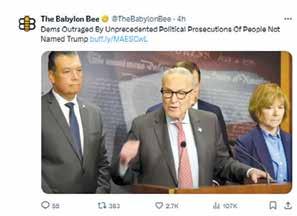



I’m not a Christian, but they are systematically killing the Christians in Nigeria. They’ve killed over 100,000 since 2009; they’ve burned 18,000 churches. This is so much more — these are Islamists, Boko Haram — this is so much more of a genocide attempt than what is going on in Gaza. They are literally attempting to wipe out the Christian population of an entire country. Where are the kids protesting this? No one’s talking about it…because the Jews aren’t involved. That’s why.
- Bill Maher, HBO

You know what is the benefit of October 7 now?
…If you look to the General Assembly yesterday, when about 194 people opened their eyes and looked to the atrocity, to brutality of Israel and all of them, they condemned Israel. We waited for this moment for 77 years. I think this is a golden moment for the world to change the history.
- Lead Hamas negotiator Ghazi Hamad, ym”sh , in an interview with CNN
You know, I met the head of Somalia – did you know that? I suggested maybe he’d like to take [Ilhan Omar] back. He said, “I don’t want her.”
- Pres. Trump talking to the media




The contrast could not be more clear: Republicans are trying to keep the government open and put the interest of Americans first. Meanwhile, Democrats want to take from the American people in order to give taxpayer-funded healthcare to illegal immigrants.
- Vice Pres. JD Vance talking about the possible government closure over the debt ceiling
Hamas was elected by the Palestinian people. Israel withdrew from Gaza thinking they would live in peace. Remember that a long time ago they withdrew. They said, you take it. This is our contribution to peace. But that didn’t work out. That didn’t work out. It was the opposite of peace. They pulled away. They let them have it. And I never forgot that because I said, that doesn’t sound like a good deal to me as a real estate person. I mean, they gave up the ocean.
Instead of building a better life for the Palestinians, Hamas diverted resources to build over 400 miles of tunnels and terror infrastructure, rocket production facilities, and hid their military command posts and launch sites in hospitals, schools and mosques. So if you went after them, you’d be after them, and you wouldn’t even realize you ended up knocking out a hospital or school or a mosque, a terrible thing. Terrible, terrible way to have to fight. No fight is good, but that’s a real bad one. So there are many Palestinians who wish to live in peace, many, many, many.
- President Trump at a joint press conference with Prime Minister Netanyahu
Remember those beepers, the pagers? We paged Hezbollah. And believe me, they got the message – and thousands of terrorists dropped to the ground.
-Prime Minister Benjamin Netanyahu addressing the UN General Assembly
For much of the past two years, Israel has had to fight a seven-front war against barbarism, with many of your nations opposing us. Astoundingly, as we fight the terrorists who murdered many of your citizens, you are fighting us. You condemn us. You embargo us. And you wage political and legal warfare, it’s called lawfare, against us. I say to the representatives of those nations, this is not an indictment of Israel. It’s an indictment of you! It’s an indictment of weak-kneed leaders who appease evil rather than support a nation whose braver soldiers guard you from the barbarians at the gate.
- ibid.
I have a message to these leaders: When the most savage terrorists on earth are effusively praising your decision, you didn’t do something right; you did something wrong. Horribly wrong. Your disgraceful decision will encourage terrorism against Jews and against innocent people everywhere. It will be a mark of shame on all of you.
- ibid.
Giving the Palestinians a state one mile from Jerusalem after October 7 is like giving AlQaeda a state one mile from New York City after September 11.
- ibid.
On October 7, the enemies of Israel tried to extinguish that light. Two years later, the resolve of Israel, and the strength of Israel burn brighter than ever. With G-d’s help, that strength and that resolve will lead us to a speedy victory and to a brilliant future of prosperity and peace.
- ibid.

The problem is not that Kamala’s campaign was too short. It’s that it was too long.
- Vice Pres. JD Vance responding to Kamala Harris’s claim that she lost the 2024 election because her campaign was too short
Agree or disagree with Barack Obama or Bill Clinton, they actually had substance. They could actually articulate a viewpoint. I listened to Kamala Harris for 90 seconds, and I actually feel like I’ve gotten dumber in the process.
– ibid.

From The Desk of Charlie Kirk

On May 2, Charlie Kirk wrote a letter to Prime Minister Benjamin Netanyahu. The text of the letter is printed below.
Dear Mr. Prime Minister, One of my greatest joys as a Christian is advocating for Israel and forming alliances with Jews in the fight to protect Judeo-Christian civilization. Most recently, I am proud to have taken over Ambassador Huckabee’s show on TBN where we continually support Israel and the Jewish people. As Muhammadism spreads into Western societies, it’s critical that Jews and Christians stay united in the effort to contain and roll back radical Islam and Sharia law. I regret to report that anti-Israel and anti-Semitic trends are at record levels on social media. These negative sentiments then flow downstream into college campuses and even seep into the conservative MAGA community.
My team and I have spent months analyzing these trends and debating ideas that could help you and your country pushback against these disturbing developments. Anti-Israel sentiment can undermine American support for Israel. The purpose of this letter is to lay out our concerns and outline potential remedies.
Everything written here is from a place of deep love for Israel and the Jewish people. I think it’s important to be brutally honest with those you love. In my opinion, Israel is losing the information war and needs a “communications intervention.”
I started to compose this letter to you on Easter. I should have been focused on my family, but I was getting bombarded with messages about the Israeli army making it difficult for Christians to access church in Jerusalem on Easter. At the time, I did not see any official statements pushing back on this narrative. It was frustrating because pro-Israel surrogates like me should not be in charge of fact checking every piece of anti-Israel misinformation that pours into social media. It wasn’t just Easter. On my recent campus tours, half the questions I get are about Israel and they’re all negative.
I often spend half my time on these campus tours defending Jews and Israel which I’m proud to do because I love Israel and love the Jewish faith. I spent endless hours with Dennis Prager over the years studying the Torah. Sometimes, it feels like I’m defending Israel in public more than your own government.
My experience on college campuses matches a recent Harvard Harris poll
which reported 48% of 18-24-year-old Americans support Hamas over Israel. Even in young MAGA circles, Israel is losing support. We are getting huge crowds of 4,000-5,000 students on some of my college tours. My campus visits are becoming like a rock concert atmosphere filled with conservative patriots. Yet, on these campus visits, I’m constantly confronted with:
“Israel is an apartheid state.”
“Why does Israel conduct ethnic cleansing?”
“Why is America subsidizing Israel’s genocide against the Palestinian people?”
“Is American aid helping to subsidize Israel’s free health care?”
“Israel and the Jews are running U.S. foreign policy.”
“Israel and Jews are responsible for 9/11.”
“Defending Israel is not in our U.S. national interest.”
“Why is Israel trying to drag us into a war in the Middle East?”
Above are just a sampling of the negative Israel/Jewish comments and questions I confront on college campuses. I’m accused of being a paid apologist for Israel when I defend her; however, if I don’t defend Israel strongly enough, I’m accused of being anti-semitic. I know you’ve got
a 7 front war and my kvetching pales in comparison. But I’m trying to convey to you that Israel is losing support even in conservative circles. This should be a 5 alarm fire.
I’m often asked, “Why is Israel killing so many innocent civilians in Gaza?” I know Israel goes to great lengths by dropping flyers and even calling civilians to clear out of areas about to be bombed. I know Israel posts maps showing which areas should be evacuated. I know that Hamas uses civilians as human shields. But 90% of the younger generations get their news from social media and podcasts, and there is very little pushback or fact checking by the Israeli government and/or pro Israel supporters in the media (especially social media).
I strongly suggest Israel NOT always depend on “subcontracting” their information war efforts to surrogates in America. Mr. Prime Minister, I urge you to REVAMP your information warfare strategy from top to bottom. Sometimes, the impression is given that Israel thinks everyone hates them so why care about winning over hearts and minds? If there’s any truth to this impression, I urge you to consider that social media and podcasts is where you fight for the hearts and minds
of the younger generation. Obviously, all this negative Israel propaganda on social media easily translates into pro Hamas “Free Palestine” sentiment on many college campuses.
Here are some unsolicited recommendations my team and I suggest if you’re open-minded to a communications reset:
1. For starters, you need a rapid response media team. President Trump does this very effectively on social media with his own account and his White House Rapid Response 47 team. The President has strong fighters like Stephen Miller and Karoline Leavitt who battle the press everyday. Honestly, I don’t even know if you have a press secretary. You are an eloquent defender of Israel, but you need a team of information warriors out there pushing back every day in real time. When you don’t push back, anti-Semitism and anti-Israel propaganda fill the void. A pro-Israel friend recently asked me, “Do Israelis even care how the world perceives their country?”
2. I strongly recommend putting together a team of pro-Israel experts who can fact-check misinformation in real time from Israel. Israel needs to take the lead in this effort – no more dependence on subcontractors. Israel never asks for American troops because Israel does its own fighting. I suggest the same approach for the information war. You lead and people like me will follow and provide supplemental support. If you’re open to revamping your communications strategy, my team and I are happy to assist.
3. You need something perhaps like an “Israel Truth Network” (ITN) which can include social media channels and a onestop source of information website where, for example, all the negative Israel questions I get can be thoroughly debunked. I would love to refer students to such a website. This website could also be a conduit to groups like Hillel and Jewish educators like Dennis Prager. There can be links to books, podcasts, media personalities, and pro Israel thought leaders. The website can be a place where Judeo-Christian leaders and groups can share information and form closer alliances in the fight against Islamic fundamentalism. ITN social media can post pro-Israel pro Judeo-Christian video clips, breaking news and articles. ITN could potentially be a news aggregation site for all news pertaining to Israel and Judeo-Christian efforts to preserve Western Civilization.
4. Have you considered inviting some of the released hostages to go on a speaking tour in the U.S.? This could be very effective messaging. These hostages
can talk about how Gazan civilians not once offered any empathy or compassion. President Trump referenced this lack of humanity when some released hostages visited the Oval Office. This was effective messaging. When impactful messaging clicks, keep it going. Also, these hostages and all your spokespersons should be arguing it’s Hamas that is committing genocide on their own people by using civilians as human shields and storing weapons in schools, hospitals etc. That information drips out in the regular media but is almost nonexistent on social media.
5. Maybe interview regular Israelis on the streets asking them what they love about their country. Interview Jews, Israeli Arabs, Druze, orthodox, secular etc. Ask Israelis what do they wish the world knew about Israel. Ask them to respond to examples of misinformation on social media. This could be an entire social media PR campaign called, “Dude, you got us wrong!” Interview Israelis from all walks of life.
Let Israelis explain in their own words how Israel is a pluralistic society, a free country with elected leaders unlike all of the surrounding authoritarian Arab nations. Why not show how your hospitals take care of wounded terrorists? Why not show clips of Israel dropping flyers from Israeli airplanes warning Gazan civilians to get out of harm’s way? It would have been nice to see an Israeli plane with a Star of David arrive in the U.S. full of supplies after a hurricane. Has Israel offered any assistance to the U.S. insofar as technology to protect our border or with the missile defense shield President Trump has discussed? These are examples of effective messaging showing Israel as a close ally of America. Consumers of social media are aware of the billions in supplies we send to Israel, but they’re less aware of what America gets in return. You and your team need to make the argument on social media that Israel is a great friend of America and is vital to U.S. national security. Israel needs to better portray itself as a member of “Team Humanity.” Israel needs to establish a baseline of her identity. To run an effective messaging campaign, you need a clearly defined message. This message should be homegrown from Israel. In other words, create original content from Israel. Videos and visuals feed social media. Keep these edited clips short under 1 minute and post the best ones on the Israel Truth Network (ITN). Don’t rely on non-Israeli social media influencers to create all these clips. Create them Yourselves, and influencers (surrogates) like me can promote this ORIGINAL work and refer people to your social media and websites. Be proactive –

take the lead. Bottom line is Israel needs to learn to fish (i.e. create your own content) and be more self-reliant when it comes to your communications strategy.
6. Iran: Israel could do a better job explaining the Iranian threat. Among the many conservatives who support Israel, there is a concern that America could become entangled in a quagmire in Iran. My generation grew up with disasters in Afghanistan and Iraq. We were promised there were WMD’s in Iraq which proved to be a lie. Our generation was also lied to by the governments of Israel and the U.S. that covid vaccines were safe and effective. Israel intelligence missed the boat on October 7, but we’re asked to trust Israeli intelligence 100% that Iran is on the cusp of obtaining nuclear weapons. Young conservatives are very skeptical of government proclamations. We don’t fully trust intelligence assessments. Right now it seems like Israel is primarily relying on Americans to make the case for attacking Iranian nuclear sites. These arguments get a lot of blowback in MAGA circles. Other than you, Mr. Prime Minister, I see very few Israelis making their case in the media, social media or podcasts. Many agree with you (myself included) that Iran should not get nuclear weap -
ons. At the same time, I share the concern that America will get sucked into another endless war costing thousands of American lives. Where are the Israelis who are arguing their case to win over public opinion? Israel should be making its case 24/7 on social media including long form (English-speaking) podcasts and social media channels and website(s) such as a Rapid Response Team and ITN.
7. A paradigm shift is needed in how Israel presents itself to the world especial-
Many of the PR challenges Israel faces should be looked at through the prism of a political campaign. Like any campaign, the first task is to define the candidate.
Right now, there is not a “one-stop shopping” resource where younger people can learn about this candidate. Every candidate has a website and social media. It would be political malpractice to omit these tools. Sorry for the brutal honesty, but Israel’s approach to social media is “PR malpractice.” Your “candi-
Sometimes, it feels like I’m defending Israel in public more than your own government.
ly on social media. Perhaps the best way to convey my thoughts here is to think of Israel as a political candidate (in this case a younger woman who grew up on social media). Who is this candidate and what does she stand for? Right now, there’s essentially a massive negative ad campaign spreading on social media. These negative ads are defining this candidate. Political campaigns face this challenge all the time.

date” should list all the toughest questions she gets on the campaign trail with detailed expert responses (add footnotes) on her ITN website and use social media to explain her platform on a daily basis. These responses become part of Miss Israel’s “platform” where her positions and values are explained. Like any political campaign, you need surrogates who can articulately promote this candidate’s
platform and identity. Right now, Israel’s identity is being fabricated by those who hate her by a barrage of misinformation in the media - especially social media. Fake news becomes real news if there’s not effective pushback. When a candidate is hit with negative campaign ads, the effective response is for the candidate to PERSONALLY respond to these attack ads. A candidate doesn’t just rely on surrogates to get the truth out. One of Israel’s biggest most fundamental problems is typically your pushback is in a 3rd person voice. I do the “3rd person” voice all the time as I attempt to defend the candidate, Israel. But I don’t live in Israel so I’m more like an attorney defending a client. Israel, the client, also needs to defend itself. I wish I had a “1st person” source of information I could reference where students and Israel skeptics could learn more about this client called Israel. You need a one-stop shopping resource where Israel’s platform and beliefs can be spelled out. You need more Israeli surrogates speaking out on behalf of their candidate. At the moment, you have some wonderful non-Israeli surrogates speaking on behalf of a candidate that has not defined herself - especially when it comes to social media. I know it’s common to think that social media, espe-

cially TikTok, is a waste of time. I thought similar a year ago. But TikTok algorithms have changed. I have increased my followers on TikTok from approx. 1 million to 6.6 million in the last year. We get BILLIONS (with a “B”) views on TikTok. My campus tour last Fall and this Spring have received approx. 5 BILLION impressions. Elon Musk is a good friend to Israel so X offers a great opportunity to make inroads on social media. Israel should not sit back and allow its enemies to define her. A recent Pew Research poll showed 53% of Americans now have an unfavorable view of Israel, up from 42% three years ago. U.S. support for Israel is precarious right now. A new media strategy is urgently needed. I understand social media as well as anyone in the world. From my vantage point, Israel has retreated from social media without a fight. How are you going to win over younger generations if you’re starting out in retreat on social media? Younger generations use their TV’s for Netflix – not the evening news. Narratives for younger and even middle-aged people are fought now on social media. Mr. Prime Minister, stop this retreat – get in the information war fight! The front lines of this information war are on social media. Other than a few guerrilla warfare operations, there’s very little Israel created content. I saw that Israel has increased its Hasbara budget by 20x times which is great news. There’s also hundreds of millions of dollars raised by private pro-Israel groups. Some of this money should be directed into creating pro Israel ORIGINAL home grown content. Next, promote this content on Israel operated social media channels and websites. Use some of these funds to start the Israel Truth Network (ITN).
To sum up, you should perhaps consider reshaping your Hasbara Department into more of a political campaign headquarters with campaign narrative experts. Hasbara could be the mothership hosting ITN where the messaging campaign can be created and then distributed to all the pro-Israel groups and thought leaders.
Majority of staff in these efforts should be in their 20’s and 30’s. The older generation alone is not going to win the information war on social media. You need to fill the ranks with young people who grew up with cell phones and social media – not pay phones and TV news. Once the candidate is defined with a platform backfilled with extensive details, then allow the political operatives to take that platform out into social media with an out-of-the-box approach like some of the earlier suggestions. I’ve seen your IDF spokesman defend Israel standing at a dimly lit podium.
This looks like a scene out of the 1970’s –like some old Walter Cronkite clips of the TV news. You need to tear down your old ways of communicating and start over from scratch. Create a communications and social media platform that is wired to fight back with the same fierceness and determination as the IDF.
Israel has many Americans and some well-known foreigners who defend Israel, which is great. But these are “3rd person” voices. Mr. Prime Minister, you are an eloquent defender of Israel but you don’t post very often on social media. Many of your clips are in Hebrew only. Why don’t you do more press conferences in Israel in English? Take on some of the tough questions I get bombarded with on college campuses. Where are all the Israeli surrogates? I can’t remember the last time I saw an Israeli spokesperson on one of the evening Fox shows other than yourself.
ISRAEL NEEDS MORE FIRST PERSON VOICES TO DEFEND HER! How can Israel defend and define itself if you don’t even have spokespersons out there fighting back every day? Do you have a press secretary like Karoline Leavitt or defenders like Stephen Miller? If not, I encourage you to go find them! You need more Israeli spokespersons who are effective speakers in the media and on social media.
I know you also have a serious deep state lawfare challenge. My team and I have been fighting the deep state every single day for many years. Maybe a revamped information war strategy can help with your internal fights as well?
Israel has enormous capabilities such as how you orchestrated your beeper bomb operation. Perhaps Israel can use some of that same ingenuity to more effectively fight the information war in the media, especially on social media? Israel is the Silicon Valley of the Middle East. Israel has an abundance of brain power and technological expertise. The question is whether Israel has the willpower to step up its game in this information war. From my vantage point, the status quo is not working. Israel is getting CRUSHED on social media and you are losing younger generations of Americans, even among MAGA conservatives. In my opinion, you are losing the information war which will eventually translate into less political and military support from America. The Holy Land is so important to my life, and it pains me to see support for Israel slip away. Feel free to contact me on my private number below if you would like to discuss this further.
Sincerely,
Charlie Kirk


Many are expressing surprise at President Donald Trump’s “stunning” and “extraordinary” pivot on Ukraine, after he declared in a Truth Social post Tuesday that Russia is “a paper tiger” that “has been fighting aimlessly for three and a half years a War that should have taken a Real Military Power less than a week to win.” With Western help, Trump said, Kyiv can “fight and WIN all of Ukraine back.”
But for those watching Trump closely, there is nothing extraordinary about it. Trump’s decision to back Kyiv against Russia was inevitable.
Trump gave Vladimir Putin every chance to prove he was interested in peace. But instead of seizing the opportunity to end the war, the Russian dictator tapped Trump along for months. This summer, Trump noted that Putin would say he wanted peace during “wonderful” phone conversations, but then the first lady would tell him, “Wow, that’s strange because they just bombed a nursing home.” It wasn’t her imagination. A Wall Street Journal analysis shows that Putin regularly intensified military attacks after his conversations with Trump.
Putin’s big mistake was accepting Trump’s invitation to attend the summit in Alaska in August. Trump rolled out the red carpet, treating Putin as a legitimate world leader rather than the global pariah he really is. The implicit understanding was that Alaska would be followed by a bilateral meeting between Putin and Ukrainian President Volodymyr Zelensky, to be followed by a tripartite meeting of the three leaders.
Putin basked in the pomp and circumstance, pocketed the prestige Trump conferred on him, and reneged on his end of the bargain.
In fact, he dramatically escalated the bombing of civilians. In Alaska, Trump
By Marc A. Thiessen

personally handed Putin a moving letter from his wife urging him to make peace for the sake of children affected by the war. Putin responded by bombing a kindergarten – a slap in the face to the first lady.
Then, on September 7, Putin launched his largest aerial assault of the war, striking the Cabinet of Ministers headquarters in Kyiv, which houses the offices of the prime minister and other senior officials - an attempted decapitation strike. Days later, Putin sent military drones into Polish and Romanian airspace. A week after that, three Russian fighter jets violated Estonian airspace.
You don’t do that to Donald Trump. Trump has correctly argued that it was President Joe Biden’s weakness that invited Putin’s invasion of Ukraine, which would never have happened had he been president. Well, now Putin is testing Trump’s resolve and probing for weakness. That’s a mistake. Trump won’t back down in the face of Putin’s escalation.
What’s needed now is a concerted campaign to show that Putin has no path to victory. Step one should be a strategy to drive Russian oil and natural gas off the global market in the same way Trump drove most Iranian oil and gas off the global market
during his first term: by imposing crippling secondary tariffs on all countries buying Russian oil and natural gas.
Unfortunately, it turns out that those countries include NATO nations. The European Union is the world’s largest buyer of Russian natural gas, purchasing 51 percent of Russia’s liquefied natural gas exports and 36 percent of Russia’s pipeline gas. Indeed, a recent report finds that E.U. imports of Russian fossil fuels surpassed all the European financial aid sent to Ukraine. As Trump pointed out during his U.N. address, “They’re funding the war against themselves.”
The worst European violator is Hungary – led by Trump ally Viktor Orban – followed by Slovakia, France, the Netherlands and Belgium. The world’s largest buyer of Russian oil products is Turkey – Trump hosted President Recep Tayyip Erdogan in the Oval Office this week – which consumes more than a quarter of Russia’s exports. Trump should insist that they stop immediately. As he told the United Nations, “The United States is fully prepared to impose a very strong round of powerful tariffs” but that “for those tariffs to be effective, European nations … have to join us in adopting the exact same measures.”
Step two: Respond forcefully to any further Russian violations of NATO airspace. Asked if he thought NATO nations should shoot down Russian aircraft that cross their borders, Trump answered: “Yes, I do.” Polish Foreign Minister Radoslaw Sikorski responded on X, “Roger that.” Red line drawn.
Step three: Sell Ukraine the weapons it needs to put Russian forces on the defensive and lift the restrictions Biden imposed that prevented Ukraine from using NATO weapons to strike Russian territory. As Trump noted on Truth Social last month, “It is very hard, if not impossible, to win a war without attacking an invaders country,” adding that “crooked and grossly incompetent Joe Biden would not let Ukraine FIGHT BACK, only DEFEND. How did that work out?” He is correct. So, take the gloves off Ukraine, and let Kyiv hit military as well as energy targets inside Russia.
Trump has put in place a plan to sell U.S. weapons to NATO, paid for by European allies, which in turn will provide them to Ukraine. This arrangement not only protects U.S. taxpayers, it also generates revenue while strengthening the U.S. defense industrial base. It is a win-win for Ukraine and U.S. national security.
Let’s be clear: None of this is a change in policy. In a July 2023 interview with Fox News’s Maria Bartiromo, Trump warned that if Putin did not agree to a peace deal, he’d give the Ukrainians more weapons than they’ve ever gotten before. When I interviewed him at Mar-a-Lago last September, he reaffirmed that would be his policy.
Trump gave Putin the chance to make peace, and Putin responded with insult and escalation. Now the Russian leader will regret treating Trump with such contempt.


By David Ignatius
After President Donald Trump’s tough talk Tuesday supporting Ukraine and NATO against Russian aggression, several Ukrainian security officials asked a Western contact two basic questions: “What does this mean?” and “How long will this last?”
The honest answer is that it’s too early to say whether Trump’s statements represent a decisive shift in U.S. policy or were an impulsive outburst likely to prove fleeting. But people familiar with Trump’s thinking say he’s fed up. Explains one: “This is classic Trump –tired of getting played and goes back hard the other way.”
Trump didn’t draw a red line Tuesday against further Russian assaults on Ukraine and NATO. But he at least flashed a yellow light warning Russian President Vladimir Putin to stop or face the possibility of NATO retaliation, supported by the United States. His warnings, following a meeting with Ukrainian President Volodymyr Zelensky in New York, were his strongest yet against Russia – following months of oscillating rhetoric as he tried to coax Putin toward peace.
Trump seemed to be resetting the negotiating table in a Truth Social post. Where he had previously urged Ukraine to give up occupied territory as the price for peace, he now said Ukraine could “WIN all of Ukraine back in its original form” and “maybe even go further than that!” He derided Russia as a “paper tiger” that had been fighting “aimlessly” since it invaded in “a War that should have taken a Real Military Power less than a week to win.”
Trump’s post read like a superpower version of “trash talk,” with threats, braggadocio and belittling comments. Whether it will be a prelude to a deeper military commitment is hard to predict.
Trump also broadcast an ampedup version of what’s presumably a U.S. intelligence estimate that Russia is in “BIG Economic trouble” and that “it’s almost impossible for them to get Gasoline through the long lines that are being formed.” Meanwhile, he praised Zelensky as “a brave man … putting up a [heck] of a fight.”
Perhaps most important, Trump offered a blunt “Yes, I do” when a reporter asked whether NATO nations should shoot down Russian aircraft that entered their airspace. He said America’s own military response “depends on the circumstance, but we’re very strong toward NATO.” After a week of escalating Russian air probes against Poland, Romania, Estonia and Germany, that was an emphatic warning to Putin.
Trump is transparent, even as his positions sometimes change day-to-day. He likes to back a winner, and he now lauds Zelensky’s toughness and persistence after saying in February that he had “no cards.” He spurns weakness, and he mocked Putin on Tuesday – not for his aggression but his inability to win. Most of all, he doesn’t like to be publicly embarrassed, as he has been since his failed Alaska peace summit.
Russia’s initial response was lowkey. “Don’t get so excited about every tweet,” said Dmitry Polyanski, Russia’s deputy ambassador to the United Nations. The Russian newspaper Ve -

domosti led Wednesday with Trump’s tirade at the U.N. that Europe is “going to [heck],” burying his threats to Russia.
But a clear sign that Trump’s message had registered with the Kremlin came later Wednesday in a snide comment from former president Dmitry Medvedev: “Trump again got into an alternative reality and issued a portion of political spells on the topic ‘How weak Russia is.’ … He published a bright post. There is the final victory of Kyiv, and a return to the previous borders, and the failed military economy of Russia, and queues for gasoline, and the ‘paper tiger.’”
Medvedev predicted that Trump would soon resume his effort to placate Russia. “I have no doubt he will return. He always comes back. … Or do something else very important that will allow [him] to qualify for the Nobel Prize.”
Let’s assume that Medvedev and other skeptics are wrong. What would Trump do if he’s serious about getting tough? Short of going to war, what steps could the United States and its NATO allies take to make a red line clear enough to be seen from Moscow?
Whenever we think about high-risk crisis management, a useful reference point is the Cuban missile crisis. Facing the threat of Soviet nuclear missiles in Cuba, President John F. Kennedy didn’t rush to bomb the island but instead imposed a “quarantine” on future delivery of such missiles. That was a red line, and after some tense days in October 1962, it worked.
Facing Russian threats against NATO, Trump on Tuesday drew at least
a dotted red line, with his “yes” to the question of whether NATO should shoot down Russian jets or drones in NATO airspace. Message sent and, I assume, received.
Talking Wednesday to U.S. strategists, I heard other suggestions of how the United States could operate in the “gray zone” – actions short of war that deny and disrupt Russia. One approach would be a predetermined set of sanctions which a former official described to me as “institutionalized tit-for-tat.” Another would be what this official called “a shamelessness about the use of U.S. military force.” He suggested “repeatedly stationing forces near Russian borders, putting the onus on Russia to then escalate, which they can’t (or won’t)”; “‘accidental’ airspace incursions – perhaps a pipeline explodes ‘accidentally,’ perhaps under cover of a Ukrainian attack.” The aim, he said, would be to “make the gray zone uncomfortably bright.” Such actions would move the United States up the escalatory ladder but keep things well below the nuclear threshold.
For now, what’s most likely is that Trump will implement the policy he sketched Tuesday: The United States will supply NATO with the weapons and intelligence that could allow Ukraine to push back Russian forces. If Russia’s economy is as fragile as Trump claims, that approach could allow Ukraine to stay in the fight long enough that even Putin will tire of a war he so recklessly created.


By Jonathan S. Tobin
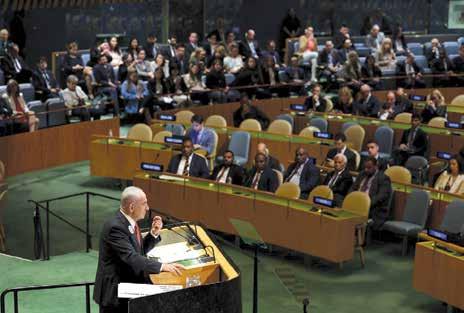
The images coming from the U.N. General Assembly on the morning of Sept. 26 told us all we needed to know about the current state of world opinion. When Israeli Prime Minister Benjamin Netanyahu went to the podium to speak, many of the delegates joined a walkout designed to demonstrate the Jewish state’s isolation on the international stage.
Israeli officials claimed only 77 out of the 199 member states boycotted the opening of the morning session of UNGA, where Netanyahu was the first scheduled speaker, or left once he started to speak. They also noted that some may not have bothered to be there for the start of another long day of U.N. speechifying, which is part of the annual festival of bloviating in which all member states have the right to give an address.
That spin notwithstanding, the images that a global audience for one of the most anticipated moments of the General Assembly saw on their television sets, computer screens and mobile phones proved telling. There’s no denying that Netanyahu seemed to be speaking to a mostly empty auditorium.
Those images illustrated something the prime minister and the people of Israel already knew. As the Jewish state continues to fight for its life against genocidal terrorists and the Islamist governments that back them, most of the international community stands against it. As most of the coverage of the event from legacy outlets like The New York Times indicated, Netanyahu was being given the pariah treatment.
At that moment, the GA seemed to be mirroring the surge of Jew-hatred
that has swept across the globe since Oct. 7, 2023. Judging Israel by double standards applied to no other country—and demonizing and denying Jewish rights—has been normalized in the worlds of politics, diplomacy and even popular culture. Everyone, even the satirists who write for the animated sitcom “South Park,” seems to be blaming Netanyahu and treating Israel as if it were a criminal state for its response to a terroristic slaughter from neighboring invaders.
With even the Trump administration pressuring him to end the war against Hamas and to acquiesce to an outcome that could lead to the survival of the terrorists, Netanyahu—and all of Israel—appears to be facing the sort of ostracism that encourages its enemies to believe that its destruction is only a matter of time.
Rather than pleading for tolerance or understanding, Netanyahu exuded defiance and confidence. As difficult as the diplomatic situation may be—his plane had to avoid flying over the airspace of hostile European countries to get to the United States out of concern about being arrested, as JNS’s Alex Traiman reported —the Israeli prime minister wasn’t giving an inch to his country’s foes or even those who claim to be its friends who have swallowed Hamas propaganda.
And that was the most important thing about his speech, as well as the rest of his visit. Here in the United States, he will have to fend off American pressure to end the war without first securing Hamas’s complete defeat, let alone allowing the creation of a Palestinian terror state, as most of the international community is demanding.
By showing that Jerusalem won’t give in to pressure to make suicidal concessions, regardless of how much of the world is against it, Netanyahu sent exactly the right message to an antisemitic United Nations and Jews in the Diaspora. He modeled exactly the sort of pride and willingness to stand firm in his convictions, if that’s what it takes to survive. That kind of brave stance is needed more than ever at a time when Jew-hatred has again become acceptable in the public square.
That is true regardless of what you think about a leader who has remained in power far longer than any other Israeli premier and who has a legion of detractors both at home and abroad. Above and beyond the debate about what strategies and tactics Israel should be employing on the diplomatic battlefield or the one in the Gaza Strip, by refusing to kowtow to the false narrative about the conflict, Netanyahu showed that he has exactly the sort of moral strength and conviction needed for the Jewish state to navigate through this perilous moment in history.
Rather than beginning his speech with a defense of Israel’s conduct in Gaza, he began with a recitation of the victories his nation had achieved in its fight against Iran and its terrorist proxies. He talked about altering the balance of power in the Middle East and, at least, for the immediate future, removing the threat of Tehran getting a nuclear weapon.
He demanded that the world remember the 48 hostages still being held captive by Hamas—20 of them deemed to be alive—and reminded the international community that the war could have ended at any moment in the last two years had the terrorists released them and laid down their arms.
Only after doing that did he go on to give a cogent explanation for why Israel is right and the rest of the world is wrong about what has happened in Gaza.
The blood libels about Israel committing “genocide” against Palestinian Arabs there or creating a famine haven’t just been mainstreamed by much of the media establishment, which has been captured by ideologues who think that Israel has no right to exist and is always in the wrong, no matter what it or its enemies actually do. Those lies have become unchallenged conventional wisdom among those who follow liberal fashion, which they believe is based on
facts rather than Hamas-fostered propaganda.
This became obvious within days of the orgy of mass murder, rape, murder, torture, kidnapping and wanton destruction that was inflicted on Israel on Oct. 7. The terrorists who committed those crimes and those who cheered for them have been able, with the help of a biased press, to portray themselves as victims, rather than perpetrators of war crimes, whose goal is both Jewish genocide and the destruction of the one Jewish state on the planet.
This has created a narrative about Israel that has cowed many who might otherwise be either supportive of Israel or normally unwilling to join the crowd
stand up and deny the misinformation so many have swallowed.
At a moment in which Jews recoil from the resurgence of antisemitism that few of them anticipated or are prepared to resist, the inclination to distance themselves from Israel and Netanyahu seems to be irresistible. But as any rational or coherent reading of history would teach us, that sort of weakness only encourages the Jew-haters, whether on the mainstream left or on the margins of the political right.
Those who accept the premise that the problem is Israel’s efforts to defend itself or Netanyahu’s desire to cling to power are making the same mistake that countless generations of Jews have
Jews who fight successfully for their lives owe the world no apologies for choosing life.
denouncing it to echo the talking points of the pro-Hamas mobs on college campuses that claim the Jewish state is a uniquely evil entity.
The mainstream media has become a reflection of a U.N. mentality that has long focused its crosshairs on the Israeli-Palestinian conflict while ignoring disasters and human rights abuses in so many other areas. It has aimed its disdain and punishment on the tiny Jewish state, as opposed to the far larger Arab world. After all, it was the Palestinian terrorists who started the post-Oct. 7 war—and it is they who are responsible for the suffering it has caused their own people.
But in an ideological environment in which a generation of young people has been indoctrinated in toxic leftist theories that falsely teach that Israel is a “white” oppressor and “apartheid” state, the truth about Oct. 7, Hamas’s actions and the way the political culture of the Palestinians has compelled them to turn down every opportunity for peace doesn’t matter.
Yet many supporters of Israel, both Jewish and non-Jewish, are so intimidated by this false narrative about Israel that they’ve lost the ability or will to
state, which is what Gaza was on Oct. 6, rather than the absence of one.
What Netanyahu was doing in Turtle Bay this week was telling us that Jews who fight successfully for their lives owe the world no apologies for choosing life.
That’s a difficult lesson for Diaspora Jews. Many aren’t accustomed to being victims of Jew-hatred or positively viewing Jewish identity other than as something rooted in universalist values. However, if they hope for their prosperous communities to resist efforts to break and isolate them, then channeling the spirit of defiance that Netanyahu modeled is the only path forward.
A spirit of blind partisanship has become commonplace in Israel and America—one that has caused many on the left to denounce Netanyahu or think that a surrender to Hamas would be terrible but worth it if it brought him down. What they should be doing at this moment is uniting behind Netanyahu’s insistence on the end of Hamas, as well as ensuring that never again should the Palestinians, their enablers and their allies be put in a position to endanger Israelis.
made in the past. Antisemitism today is, in this respect, no different from the attacks on Jews that were commonplace in the past. As Netanyahu rightly noted, the decades after World War II and the Holocaust, during which Jew-hatred was confined to extremists, were a brief holiday from history. Then, as now, antisemitism is always about the antisemites; it does not stem from the actions of the Jews.
The only way to answer those who attack Israel is by not accepting their premise or apologizing for its actions. Those who falsely judge Israel or think it should respond to existential threats and the worst mass slaughter of Jews since the Holocaust by essentially taking it as their due aren’t just wrong. They are part of a culture in which killing Jews is now considered acceptable. And they must be defied.
Opposing a Palestinian state isn’t, as Netanyahu correctly observed, a marginal point of view in Israel. It’s part of a consensus that stretches from the moderate left to the right. That is because the overwhelming majority of Israelis know that what happened on Oct. 7 was the result of there being a Palestinian
Friends of Israel, both Jewish and non-Jewish, are doing just that. But as opinion polls and the tenor of public discourse about the Middle East indicate, many Americans have been influenced by a biased media, leftist ideology and traditional tropes of antisemitism being spread by the likes of former Fox News host Tucker Carlson and the even more hateful political commentator Candace Owens.
We don’t know what will happen next in Gaza or whether the Trump administration can resolve the cognitive dissonance that defines its current policies, backing Israel’s quest for Hamas’s destruction while also letting the funders of Islamist terror that rule Qatar lead it around by the nose.
We do know that Israel cannot allow itself to be pressured into letting Hamas win the war it started on Oct. 7. The only way to ensure that won’t happen is if Netanyahu remains defiant, even if it means standing alone. And no matter how much it may cost individuals who dissent from mainstream culture and opinion, at this moment, those who care about Israel and Jewish survival must stand with him.
Jonathan S. Tobin is editor-in-chief of JNS (Jewish News Syndicate).
By Chris Buckley and Adam Goldman
United States officials were alarmed in 2023 when they discovered that Chinese state-controlled hackers had infiltrated critical U.S. infrastructure with malicious code that could wreck power grids, communications systems and water supplies. The threat was serious enough that William Burns, the director of the CIA, made a secret trip to Beijing to confront his Chinese counterpart.
He warned China’s minister of state security that there would be “serious consequences” for Beijing if it unleashed the malware. The tone of the meeting, details of which have not been previously reported, was professional, and it appeared the message was delivered.
But since that meeting, which was described by two former U.S. officials, China’s intrusions have only escalated. (The former officials spoke on the condition of anonymity because they were not authorized to speak publicly about the sensitive meeting.)
U.S. and European officials say China’s Ministry of State Security, the civilian spy agency often called the MSS, in particular, has emerged as the driving force behind China’s most sophisticated cyber operations.
In recent disclosures, officials revealed another immense, yearslong intrusion by hackers who have been collectively called Salt Typhoon, one that may have stolen information about nearly every American and targeted dozens of other countries. Some countries hit by Salt Typhoon warned in an unusual statement that the data stolen could provide Chinese intelligence services with the capability to “identify and track their targets’ communications and movements around the world.”
The attack underscored how the Ministry of State Security has evolved into a formidable cyberespionage agency

capable of audacious operations that can evade detection for years, experts said.
For decades, China has used forhire hackers to break into computer networks and systems. These operatives sometimes mixed espionage with commercial data theft or were sloppy, exposing their presence. In the recent operation by Salt Typhoon, however, intruders linked to the MSS found weaknesses in systems, burrowed into networks, spirited out data, hopped between compromised systems and erased traces of their presence.
“Salt Typhoon shows a highly skilled and strategic side to MSS cyber operations that has been missed with the attention on lower-quality contract hackers,” said Alex Joske, the author of a book on the ministry.
For Washington, the implication of China’s growing capability is clear: In a future conflict, China could put U.S. communications, power and infrastructure at risk.
China’s biggest hacking campaigns have been “strategic operations” intended to intimidate and deter rivals, said Nigel Inkster, a senior adviser for cyber -
security and China at the International Institute for Strategic Studies in London.
“If they succeed in remaining on these networks undiscovered, that potentially gives them a significant advantage in the event of a crisis,” said Inkster, formerly director of operations and intelligence in the British Secret Intelligence Service, MI6. “If their presence is — as it has been — discovered, it still exercises a very significant deterrent effect; as in, ‘Look what we could do to you if we wanted.’”
The Rise of the MSS
China’s cyber advances reflect decades of investment to try to match, and eventually rival, the U.S. National Security Agency and Britain’s Government Communications Headquarters, or GCHQ.
China’s leaders founded the Ministry of State Security in 1983 mainly to track dissidents and perceived foes of Communist Party rule. The ministry engaged in online espionage but was long overshadowed by the Chinese military, which ran extensive cyber-spying operations.
After taking power as China’s top leader in 2012, Xi Jinping moved quickly to reshape the MSS. He seemed unsettled by the threat of U.S. surveillance to China’s security, and in a 2013 speech pointed to the revelations of Edward Snowden, the former U.S. intelligence contractor.
Xi purged the ministry of senior officials accused of corruption and disloyalty. He reined in the hacking role of the Chinese military, elevating the ministry as the country’s primary cyberespionage agency. He put national security at the core of his agenda with new laws and by establishing a new commission.
“At this same time, the intelligence requirements imposed on the security apparatus start to multiply, because Xi wanted to do more things abroad and at home,” said Matthew Brazil, a senior analyst at BluePath Labs who has co-written a history of China’s espionage services.
Since around 2015, the MSS has moved to bring its far-flung provincial offices under tighter central control, said experts. Chen Yixin, the current minister, has demanded that local state security offices follow Beijing’s orders without delay. Security officials, he said on a recent inspection of the northeast, must be both “red and expert” — absolutely loyal to the party while also adept in technology.
“It all essentially means that the Ministry of State Security now sits atop a system in which it can move its pieces all around the chessboard,” said Edward Schwarck, a researcher at the University of Oxford who is writing a dissertation on China’s state security.
Chen was the official who met with Burns in May 2023. He gave nothing away when confronted with the details of the cyber campaign, telling Burns he would let his superiors know about the
U.S. concerns, the former officials said.
The Ministry of State Security operates largely in the shadows, its officials rarely seen or named in public. There was one exception: Wu Shizhong, who was a senior official in Bureau 13, the “technical reconnaissance” arm of the ministry.
Wu was unusually visible, turning up at meetings and conferences in his other role as director of the China Information Technology Security Evaluation Center. Officially, the center vets digital software and hardware for security vulnerabilities before it can be used in China. Unofficially, foreign officials and experts say, the center comes under the control of the MSS and provided a direct pipeline of information about vulnerabilities and hacking talent.
Wu has not publicly said he served in the security ministry, but a Chinese university website in 2005 described him as a state security bureau head in a notice about a meeting, and investigations by Crowd Strike and other cybersecurity firms have also described his
state security role.
“Wu Shizhong is widely recognized as a leading figure in the creation of MSS cyber capabilities,” said Joske.
In 2013, Wu pointed to two lessons for China: Snowden’s disclosures about American surveillance and the use by
should create “a national cyber offense and defense apparatus.”
China’s commercial tech sector boomed in the years that followed, and state security officials learned how to put domestic companies and contractors to work, spotting and exploiting flaws
panies to feed information to the state.
“MSS was successful at improving the talent pipeline and the volume of good offensive hackers they could contract to,” said Dakota Cary, a researcher who focuses on China’s efforts to develop its hacking capabilities at SentinelOne. “This gives them a significant pipeline for offensive tools.”
Some countries hit by Salt Typhoon warned in an unusual statement that the data stolen could provide Chinese intelligence services with the capability to “identify and track their targets’ communications and movements around the world.”
The Chinese government also imposed rules requiring that any newly found software vulnerabilities be reported first to a database that analysts say is operated by the MSS, giving security officials early access. Other policies reward tech firms with payments if they meet monthly quotas of finding flaws in computer systems and submitting them to the state security-controlled database.
the United States of a virus to sabotage Iran’s nuclear facilities. “The core of cyber offense and defense capabilities is technical prowess,” he said, stressing the need to control technologies and exploit their weaknesses. China, he added,

and weak spots in computer systems, several cybersecurity experts said. The U.S. National Security Agency has also hoarded knowledge of software flaws for its own use. But China has an added advantage: It can tap its own tech com -
“It’s a prestige thing and it’s good for a company’s reputation,” Mei Danowski, the co-founder of Natto Thoughts, a company that advises clients on cyber threats, said of the arrangement. “These businesspeople don’t feel like they are doing something wrong. They feel like they are doing something for their country.”
© The New York Times

By Ben Hubbard
DAMASCUS, Syria — When a veteran American diplomat met a Syrian rebel commander in 2023, they had a surprisingly cordial chat about their lives on enemy sides in two Mideast wars.
The commander, who went by the name Abu Mohammed al-Golani, recalled when he was a young jihadi shooting at the mobile homes in Baghdad where the diplomat was living after the American invasion of Iraq in 2003.
The diplomat, Robert S. Ford, recounted that in 2012, as ambassador to Syria during its civil war, he had shut the U.S. Embassy for fear that the commander’s al-Qaida faction would bomb it.
The Syrian rebel leader then talked about what he envisioned as his next act, seizing the capital and governing Syria — a prospect that appeared fantastical at the time, Ford told The New York Times.
Last December, the commander did just that.
He led a startling offensive that toppled dictator Bashar Assad and became president of Syria. He swapped his military garb for sharp suits and exchanged his nom de guerre for his real name, Ahmad al-Sharaa.
On Wednesday, al-Sharaa was expected to become the first Syrian leader to address the United Nations General Assembly in 58 years, a stunning turnaround for a man still officially designated as a terrorist by the United States and the U.N.
“As time goes on, we see that alSharaa is less of a hard-line Islamist jihadist trying to appear pragmatic and more of an authoritarian who is trying to establish a stable government,” Ford said. “He is a power seeker.”
Interviews with more than 70 people who tracked or interacted with al-Sharaa during his rise painted a picture of an intelligent, ambitious shape-shifter who

used guile, charm, diplomacy and ruthlessness to survive in some of the most dangerous corners of the Middle East.
Early on, he allied himself with terrorists while fighting the United States in Iraq, joining jihadis who considered that struggle a religious war.
He later returned to his homeland and set up the Syrian affiliate of al-Qaida. As the years passed, he rebranded himself as a moderate rebel leader to broaden his appeal.
His many transformations have fueled questions about what he truly believes and how he intends to lead a country emerging from the ruins of a 13-year civil war — particularly as Syria’s future could be crucial in stabilizing a region in turmoil.
He has won support from the United States and other powers; sought peaceful relations with neighbors, including Israel; and called for reconciliation between Syrians.
But recent sectarian violence has tarnished his reputation. Thousands have
been killed in attacks that human rights groups and the United Nations say his security forces participated in.
He has concentrated power in his hands and those of loyal deputies, raising concerns about whether he really wants to establish a government that represents all Syria’s diverse minority groups or intends to become a new strongman.
He told a small group of reporters, including from the Times, during a meeting in Damascus last week that his past — regardless of what anyone said about it — had prepared him to do what no one else could: topple the Assad regime.
“Whoever has judged us on our past, were they wrong? Or were we?” he said.
Al-Sharaa was born in 1982 in Saudi Arabia to a middle-class Syrian family that returned home to Damascus, the capital, when he was a child. His father was an economist, his mother a teacher. The family talked politics at home but had no history of Islamist extremism.
Neighbors recalled him as bookish and shy.
In his teens, he took to wearing a long tunic and knitted cap that signified increasing religiosity, said Maya Athem, a neighbor.
When he was 20, neighbors stopped seeing him around.
“Suddenly, he disappeared,” Athem said. “Even his mother didn’t know if he was alive or dead.”
He had slipped across the border into Iraq just before the U.S. invasion in 2003. He fell in with insurgents who would go on to form the core of al-Qaida in Iraq, but there is no indication he did significant fighting. An Iraqi security official said al-Sharaa recently told him that U.S. forces arrested him in 2005 during his first mission to plant roadside bombs targeting American troops.
Like many of those interviewed, the official spoke on condition of anonymity in line with diplomatic protocols or for fear of retribution.
The young man was detained in the northern city of Mosul with other suspected insurgents, according to Muzahim al-Huwait, an Iraqi tribal leader who befriended him in prison. Al-Huwait recalled a quiet inmate who identified himself as an Iraqi student named Amjad Mudhafar and who spoke Arabic with a convincing Iraqi accent.
Since then, al-Huwait said he nearly forgot about the quiet inmate until he showed up on television last year as the new leader of Syria.
“Now Amjad Mudhafar, who was detained with me in Mosul, is the president of Syria,” al-Huwait said, appearing still baffled.
Al-Sharaa’s transformation from middle-class Damascene to jihadi in Iraq was the first of various guises, and he succeeded in duping many other people during his six years in prisons in Iraq.
American and Iraqi authorities never realized he was Syrian, according to Iraqi records and the Iraqi justice minister at the time, Hassan al-Shammari.
In 2011, al-Shammari said, the Iraqis reviewed his detention and found no charges against anyone with his assumed name. So he was freed on March 13, 2011, records show.
Days later, anti-government protests inspired by the Arab Spring uprisings broke out in Syria, the first spark of the civil war that would draw al-Sharaa back home.
In late 2011, al-Sharaa and a few comrades sneaked into Syria to inject a new jihadi group into the accelerating civil war.
Before he left Iraq, he turned to Abu Bakr al-Baghdadi, whom he knew from prison and who had become the leader of al-Qaida in Iraq. The Iraqi gave him about $50,000 to expand al-Qaida into Syria, al-Sharaa has said.
His new group, the Nusra Front, made its presence known in early 2012 by dispatching suicide bombers to attack security personnel in Syria’s largest cities, killing hundreds of people.
In an online message claiming responsibility for two big attacks, alSharaa promised more.
“This regime will never stop except by the power of G-d and the power of weapons,” he said, using his new nom de guerre, Abu Mohammed al-Golani. Almost no one knew his true identity.
At the time, most Syrian rebels saw their fight as a revolt against a brutal dictatorship. The Nusra Front added the tactics of violent jihadism and sought to make its rigid interpretation of Islam the law.
But a rift emerged with his Iraqi patron who, in 2013, created the Islamic State in Iraq and Syria, or ISIS. AlSharaa refused to integrate the Nusra Front into it.
The Islamic State began what it considered global holy war and staged attacks in Paris, Cairo, and elsewhere. Al-Sharaa pledged allegiance to Ayman al-Zawahri, global leader of al-Qaida, though the Nusra Front kept its fight inside Syria.
“We do not seek to rule the country,” al-Sharaa said in his first television interview with al-Jazeera in 2013, his face and true identity still concealed. “We seek that G-d’s law will rule the country.”
His forces based themselves in Idlib province, a poor corner of northwestern Syria. They took down other rebel fac -
tions there, including some that Washington supported.
Rights groups and Syrian activists accused them of killing and detaining critics, and videos shared online showed them executing women they accused of certain crimes. They were tough on religious minorities, whose beliefs they considered heretical.
They forbade Idlib’s Christians from displaying crosses or ringing church bells, and they and other rebels seized Christian homes and farmland.
Hanna Jallouf, a Roman Catholic priest in Idlib at the time, said the Nus -
key, pushing millions of refugees into its territory and creating a haven across its southern border for jihadis, including the Nusra Front.
By 2013, Turkish intelligence officers had established ties with al-Sharaa, according to two officials familiar with the matter.
In 2016, al-Sharaa showed his face publicly in a video announcing that his group was no longer linked to al-Qaida. The next year, he founded Hayat Tahrir al-Sham, the primary group that toppled Assad and which now forms the core of Syria’s security services.
Al-Sharaa’s transformation from middle-class Damascene to jihadi in Iraq was the first of various guises, and he succeeded in duping many other people during his six years in prisons in Iraq.
ra Front kidnapped him in 2015 for 20 days. An international outcry prompted his release.
“They took everything,” he recalled. “You had no rights. You had no worth as a human.”
Two years later, Jallouf received a visit from two Muslim clerics in Idlib who said they wanted a reconciliation with local Christians. Al-Sharaa had sent them, he said. The priest showed them the seized properties, and the fighters began returning them to their owners.
In 2022, al-Sharaa apologized to the priest and to other Christians, expressing hope that they could turn the page, said Jallouf, who is now bishop of Aleppo. Much of the Christians’ property has since been returned.
“This man is trustworthy,” he said. “If he promises something, he carries it out.”
Al-Sharaa’s reconciliation with Idlib’s Christians was part of a broader turn away from extremism. His group stopped carrying out suicide bombings and reframed their fight against the dictatorship in more nationalistic terms.
Urging al-Sharaa along this path was Turkey, which engaged with him early in the war, according to six officials and others familiar with the matter.
Syria’s war was a nightmare for Tur -
they could be a useful interlocutor,” said Dareen Khalifa, a senior adviser at the International Crisis Group, who met alSharaa during this time.
Those efforts opened new lines of communication.
Jonathan Powell, now the British national security adviser, met with alSharaa. A group Powell founded, Inter Mediate, organized Ford’s trip to Syria in 2023, during which he was surprised by al-Sharaa’s confidence that his forces would reach the capital.
“I just thought, well, he’s never going to get to Damascus,” Ford said. “But it is interesting that even young jihadists may temper their enthusiasm as they get older.”
A few weeks after the rebels reached Damascus, an old acquaintance came to visit al-Sharaa, now Syria’s leader.
Ezzat Alshabandar, an Iraqi politician, lived in Damascus in the 1980s and early 1990s, and his son had been a childhood friend of al-Sharaa. Alshabandar said that when they met again last year, al-Sharaa reflected on his life.
As government forces advanced, Assad was sending rebels who had been routed in other parts of the country to Idlib, exacerbating a humanitarian crisis in the province. Turkey worried that the dire situation there would push more refugees into its territory, officials said.
To stabilize the area, Turkey sought a Syrian partner, and al-Sharaa appeared to be the most capable, according to five people familiar with the matter. So Turkish intelligence increased its support for him while encouraging him to move away from extremism.
Over time, al-Sharaa used his growing power in Idlib to fight or restrain extremists while parts of his group provided information that helped foreign intelligence agencies pursue al-Qaida and ISIS, according to current and former officials.
He also took advantage of a truce around 2020 to develop a civilian administration and pursue talks with Western governments. None wanted to talk directly because they still considered him a terrorist.
So he took another tack, inviting researchers and conflict-resolution workers to Idlib to see how he and his fighters had changed and to find out how they might get rid of their terrorist designation.
They wanted the Americans “to know that they were no longer a threat, that
Al-Sharaa acknowledged he had been more extreme when he was younger but said his experiences made him more moderate, Shahbandar recalled. Now, he said he had to be a “realistic Islamist” to lead all of Syria.
Alshabandar said he believes alSharaa wants to build a civil state but has to proceed gradually lest he antagonize the more extremist fighters in his ranks who stuck with him through the civil war.
As al-Sharaa takes the U.N. stage to put forth his vision for Syria, other leaders are trying to decipher his latest transformation.
After meeting al-Sharaa in May, President Donald Trump expressed confidence in him and announced the lifting of U.S. sanctions.
But the waves of sectarian violence in Syria have amplified doubts about alSharaa’s ability to restrain his more extreme followers. It is also making it more difficult to bring large minority-run regions under his authority.
Alshabandar said that al-Sharaa’s greatest challenge was to prevent a new civil war. He said he had warned alSharaa that extremists in his security forces could undermine him.
“He told me, ‘Maybe I have no control over the palace that I’m in,’” Shahbandar recalled.
By Avi Heiligman
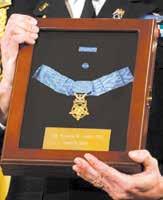
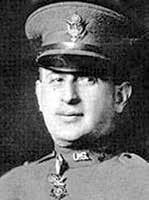


National Guardsmen fight for both the state that they represent and the federal government. While serving stateside, they respond to the commands of the governor, but they also can be called upon by the President to serve both domestically and overseas. State militias have been around since 1636 and have been called the National Guard nationwide since 1903. There have been many members of the National Guard that have been awarded prestigious medals and citations for gallantry in action while serving in uniform.
First Sergeant Sydney Grumpertz served with the Illinois National Guard before entering active duty with the army during World War I. The Jewish noncommissioned officer was assigned to the 33rd Division which formed in 1917 from the Illinois National Guard. Gumpertz was with Company E, 132nd Infantry Regiment, 33rd Infantry Division, and the regiment was under the command of Jewish Colonel Abel Davis.
On October 24, 1918, Gumpertz faced a dangerous situation near Bois-de-Forges, France. Leading an advance with two other soldiers, they neutralized two German machine gun nests and captured dozens of enemy troops. However, a barrage of exploding shells struck, killing his two comrades and leaving Gumpertz to confront a third, still-active machine gun nest alone. Undeterred, he single-handedly charged the position, silencing the gun and captur-
ing an additional nine German soldiers. His exceptional bravery and daring actions that day earned him the Medal of Honor.
Some Medal of Honor recipients are awarded their medals decades after their heroic feats. This was the case for Woodrow W. “Woody” Keeble, who was a National Guardsman from North Dakota who was posthumously awarded the medal in 2008 for actions during the Korean War. Keeble was a Native American born in South Dakota whose family moved to North Dakota when he was young. While in school, he excelled at baseball and was being recruited by the White Sox when his National Guard unit, the 164th Regiment, was called for World War II duty.
The 164th entered federal service in February 1941 and was sent to fight in the South Pacific attached to the 23rd Americal Division. In October 1942, they were sent as replacements for the 1st Marine Division that had seen heavy fighting on Guadalcanal in the Solomon Islands. Keeble was a BAR (Browning Automatic Rifle) man in his company and used his pitching arm to throw hand grenades with pinpoint precision. The 164th received the Presidential Unit Citation for their heroic fighting on Guadalcanal. Later in the war, Keeble and the 164th fought on Bougainville, Leyte, Cebu and Mindanao in the Philippines before taking part in the occupation of Japan in the immediate aftermath of the Japanese surrender in 1945.
Keeble returned to North Dakota after
World War II but was recalled to active service when the 164th was reactivated during the Korean War. By this point, Keeble was a sergeant and volunteered for front line service. He was assigned to G Company, 2nd Battalion, 19th Infantry Regiment, 24th Infantry Division and soon was leading 1st Platoon as a master sergeant. In October 1951, the division was assigned the formidable task of capturing a series of steep, heavily defended mountains that served as a natural barrier protecting a major Chinese supply dump. Dubbed Operation Nomad-Polar, this offensive was to be one of the last major actions of the war. Keeble was wounded on four separate occasions in six days and received one Purple Heart. He did receive a Silver Star for actions on October 18.
Two days later, there was just one very strongly held Chinese position that lay between the Americans and the depot at Kumsong. Keeble had been advised by a medic to stay back because of previous wounds in his arm, shrapnel from a grenade in his face, and a bad knee. He insisted in leading the charge up the mountains, but three times the different platoons were repulsed. Keeble decided that he alone would attempt to break through the lines armed with his BAR and grenades. There were three fortified and well-placed enemy positions that soon would be firing directly on Keeble. Despite the dangerous situation, he crawled to the first enemy
pillbox and eliminated it with his rifle and grenades. Then he went back to Americans lines to come up on the enemy’s left flank to take out another Chinese position. Keeble took another grenade and with precision accuracy took out the middle pillbox. This was done under very heavy enemy fire that was directed at his location. The rest of G Company moved forward and took the objective.
Keeble’s one-man assault was put in for the Medal of Honor twice, but the paperwork was lost. Instead, he received the Distinguished Service Cross in 1952. Efforts were renewed by senators to have Keeble receive the medal, and they drafted legislation to have the statute of limitations removed so that Keeble would be properly honored. Keeble had passed away in 1982 so his stepson accepted the medal from President W. Bush in a White House ceremony.
Gumpertz and Keeble were two of the more than 120 National Guardsmen to have been awarded America’s highest military award for valor. The actions of recipients of the Medal of Honor are carefully reviewed, and only those who are really deserving are given the prestigious award.
Avi Heiligman is a weekly contributor to The Jewish Home. He welcomes your comments and suggestions for future columns and can be reached at aviheiligman@gmail.com.

DU N DURT
Power & Soft Washing
We clean siding, stucco, decks, driveways, concrete, pool patios, pavers & sidewalks. Say goodbye to grime, mold & allergens! Call/WhatsApp: 718-688-2964
Email: dundurtny01@gmail.com
VACUUM SALES AND REPAIR
All areas call Max Flam 718-444-4904
THE LEATHER SHOPPE
The spot for all your custom leather Judaica. Tallis/tefillin bags, lulav and esrog bags, havdallah sets, challah covers, shtenders, pesach sets, matzah/afikomen bags. WhatsApp: (732) 523-0007 or email: theleathershoppe732@gmail.com for a full catalog. We ship.
PEACEFUL PRESENCE STUDIO
Men’s private yoga, Licensed Massage & Holistic Health Guidance 436 Central Ave, Cedarhurst Info. & free video training www.peacefulpresence.com 516-371-3715
DO YOU OR YOUR LOVED ONE? Need trusted extra help for everyday tasks?
JustCallCorey.com See References. Call or Text 718-757-0766
GERBER MOVING
Full Service Moving Packing Moving Supplies
Local Long Distance. Licensed Insured 1000’S Of Happy Customers Call Shalom 347-276-7422
HANDYMAN AVAILABLE
For big or small jobs, Sheetrock, carpentry, painting, electrical, plumbing, install & repair appliances Call Ephraim at 347-593-4691
MANAGEMENT STAFF WILL ASSIST
you with: * Obtaining Medicaid and Pooled Income Trust
* In-home Assessments, Individual and Family Counseling
* Securing reliable home care assistance
* Case and Care Management services Dr. S. Sasson, DSW, LCSW (718) 544- 0870 or (646) 284-6242
HAIR COURSE:
Learn how to wash & style hair & wigs. Hair and wig cutting, wedding styling Private lessons or in a group Call Chaya 718-715-9009
ZEVIZZ WOODTURNING JUDAICA
Challah knifes, batei mezuzah, besamim holder, kiddish cups, havdalah candle holders, yad for sefer torah, pens, stenders, bowls and more 952-356-2228
MY MOTTO IS DON’T WAIT TO buy real estate
Buy real estate and wait Your realtor for life 516-784-0856 Alexandra at Realty Connect USA
REAL ESTATE MANAGEMENT Services – Do Not Manage Your Properties Alone!
Contact Aliyah Suites for all your real estate management needs and affordable office space near you! (516) 366-1049
Management@aliyahsuites.com
Marc Jeret (MJ)
Team Leader & Licensed Real Estate Agent




















Prime Restaurant Location For Lease.
For more information:
Call/Text/WhatsApp Owner:
(516) 206-1100
Don’t Get Stuck With a Two Story House Ya Know, It’s One Story Before You Buy It But a Second Story After You Own It!
Call Dov Herman For An Accurate Unbiased Home Inspection InfraredTermite Inspection
Full Report All Included NYC 718-INSPECT
Long Island 516-INSPECT www.nyinspect.com
ASSISTANT TEACHER, AFTERNOON POSITION
Join our Specialized team at Zareinu. Looking for a warm and caring teacher assistant to work with an experienced teacher in a small 7th and 8th grade girls’ class in Shulamith.
Great Pay! Great Opportunity! Warm environment with administrative support!
Email resume: jlepolstat@zareinu. org or call 516-993-2142
DELIVERY PERSON NEEDED to deliver this Newspaper every Thursday morning to locations in Brooklyn. Must have Mini van or SUVand availability to work Consistently every week.
Good pay - Please email gabe@fivetownsjewishhome.com or call (917) 299-8082
REGENTS EXPERT
Tutoring regents in Algebra and Geometry A Darchei Torah instructor. Guaranteed results Text 347-491-8045 WhatsApp 347-767-1755
SEEKING ELEMENTARY TEACHERS and assistants for General Studies for the ‘25-’26 year. Assistants should have skills to take over for teachers if needed. Far Rockaway area boys’ school, M-Th, PM hours, strong support. Excellent salary. Send resume to teachersearch11@gmail.com.

YESHIVAT KOL YAAKOV
In Great Neck, NY, is seeking general studies teachers for both the elementary and middle schools, for the upcoming academic year. Mon-Thur afternoons. Competitive salary, warm and supportive environment. Send resume to m.kalati@kolyaakov.org
5 Towns area Nursing Home management office seeking a Regional/Corporate level MDS Nurse to work in our office. Must be an RN. Regional experience preferred. 2-3 years MDS experience with good computer skills required. Position is Full Time but Part Time can be considered. Great Shomer Shabbos environment with some remote options as well. Email: officejob2019@gmail.com
DEVELOPMENT ASSISTANT
A multi-tasker needed for general office work. The ideal candidate is someone who is detail-oriented, responsible, and can take ownership. Looking for someone who is eager to learn, and expand his/her skill set while possessing the ability to work independently and as part of a team. Experience with Excel required. Five Towns location. In-office position only, not remote. Please send resume to 5tpart.timecareer@gmail.com
A Five Towns Real Estate Company is seeking a full-time Bookkeeper. The right candidate must be proficient with QuickBooks and Excel. They must also be self-motivated, organized, detail oriented, reliable, and able to work independently or as a team player. Warm, frum office environment with excellent salary & benefits. Please email resume to HR@capsprop.com

SCHOOL ADMINISTRATIVE SECRETARY
Boys HS in Forest Hills seeks mature, middle-aged female. $65–70K. Mon–Thu, occasional Sundays. Warm environment. Email malky@candidrecruits.net or call/WhatsApp 8458015114
REBBE, SUNDAY POSITION
Join our Specialized team at Zareinu! Looking for a Rebbe to teach a small class of second and third grade. You will be working with experienced assistants. Great Pay! Great Opportunity! Warm environment with administrative support! Email resume: jlepolstat@zareinu.org or call 516-993-2142
HEAD ENGLISH TEACHING POSITIONS
Join our Specialized team at Zareinu! Looking for a qualified teacher to teach a modified English curriculum for a small group of 4th grade girls in Far Rockaway. Great Pay! Warm environment! Great administrative support! Email resume: jlepolstat@zareinu. org or call 516-993-2142





GOOD NEWS!
The new ‘Noble Wines’ catalog is ready just in time for Yom Tov. Please request your copy by mail, simply call, text, or email your address: (845) 716-8306 news@noblewinesinc.com
HASHAVAS AVEIDA Apple airpods found on Wednesday morning on the way to the Woodmere dock. To claim, 516-351-8105.
LOST TENNIS BRACELET If found. Please call 347-306-2049
SHMIRAS HALASHON
Text 516-303-3868 with a time slot of your choice to be careful on lashon hara. Be a part of the 1,000 people for klal yisroel!
BEIS HAMEDRASH CONG. Chasdei Uvois Oshpitzin Talmidei chachomim are willing to learn mishnayos, say kaddish and be the shliach tzibbur to daven for the umid on the yartzeit yom hashanah of your parents or close relatives or loved ones To arrange please call Rabbi Miller 917-445-6220


By Rivki D. Rosenwald Esq., LMFT, CLC, SDS
Paste, loop; paste, loop! Does anyone still make those homemade chains to float across their sukkahs?
They seemed to have been replaced by tinsel and gold a while ago. After all, that wasn’t terrible because after the first rain you’d have the color papers dripping into your meal.
But the tinsel is almost a thing of the past as well. Nowadays, living room decor seems to have replaced the old, ad hoc designs. Chandeliers, sofas, tapestries… none of these are unusual to find in a suk-
kah these days.
My grandfather collected old doors and nailed them together. That was our sukkah of yesteryear – almost as if there was a door for every Ushpezin to arrive through, assuming they could pry them apart.
Today, many sukkahs are works of art. They are often completely clear, and you can see through them to the stellar decor within.
They certainly challenge the concept of a temporary dwelling a bit – though it would still be a studio and no family,


wishing to remain one, would move in together like that except temporarily.
Kids still do hang their artwork in many sukkahs, though. And that is a highlight for them and us. They are proud, and we are prouder.
Of course, at least one child wants to hang their rendering of dip the apple in the honey, a song that definitely is in dire need of a replacement. As cute as it is, there’s no way we can’t do a little better. And while we are at it, maybe we can
space for a table, chairs and people. Sure, if you have a big yard with no overhanging trees you’re OK. But what about apartments and the like?
Of course, the toughest challenge is making sure it’s conveniently located close to the kitchen because meal after meal is consumed there. And no holiday meal has less than umpteen courses. Where’s the fun then?
The holiday itself is a reunion. We’ve come through the difficult stuff. We’ve
Nowadays, living room decor seems to have replaced the old, ad hoc designs.
update “Frogs here, frogs there, frogs are jumping everywhere.”
Sukkos is a fun holiday. Though it has some challenges as well.
It continues the outdoor barbecue season well past when we might have, though the outdoor component can go from way too hot to shakily cold.
The space you have to construct it can also add complications. After all, no one wants to celebrate alone, so you need
reaffirmed our desire to complete our individual missions. We’ve cleaned our slates and committed to be part of a united people.
Now, that’s great, so it’s party time. We’ve reconnected with our Maker. We are there for one another. And we celebrate with friends and family. What can be nicer than a week of partying?! Eight days! And that’s just what we are in for.








By Rabbi Berel Wein z”l
This song of Moshe is the song of the Jewish story. It accurately portrays the arc of Jewish history in its glorious as well as its dolorous moments. The Ramban’s comment as to the proof of the holiness and accuracy of Moshe’s prophetic words – “if someone stood and accurately foretold what would happen many centuries later, would not one in hindsight be forced to admit to the truth of that prophet and his words upon seeing the minute fulfillment of that prophecy” – certainly carries even more weight in our age, a further eight centuries removed from Ramban’s time.
Moshe calls forth the heaven and
earth to bear witness to his words of prophecy, for he is aware that human logic and memory can never really be trusted. Unfortunately, memory can be dimmed and lost, and logic distorted and/or ignored. In fact, it is these factors – lost memory and flawed logic – that Moshe identifies as the cause of the sins of the Jewish people and of much of the predicted travail that will accompany them throughout their history.
It is not so much that there is a rebellion against G-d and Torah in our current society as it is that G-d and Torah have simply been forgotten, erased from the Jewish consciousness – for many Jews


they simply do not exist. And in such a climate of almost willful forgetfulness, certainly any attempt to convince others of the errors of their ways by the use of logic is doomed to frustrating failure.
Moshe concludes his visionary song/ poem on an optimistic note. Somehow, the covenantal relationship between G-d and Israel will remain binding and unbroken even unto the end of days. There will
completely forgotten by all of the Jewish people reassures us that somehow the restoration of Jewish memory is possible and even guaranteed. And our logic will eventually not fail us as well.
We will survey our world and our situation and come to a logical and holy conclusion as to what our policy and path in life should be. A nation of wisdom and insight, creativity and scholarship will
The fact that Moshe promises us that G-d and Torah will never be completely forgotten by all of the Jewish people reassures us that somehow the restoration of Jewish memory is possible and even guaranteed.
always be a core group of Jews who will not allow themselves – as well as others – to forget.
Events will constantly jog the Jewish memory, and new generations will arise and ask: “Who are we and why are we here?” And the response to those questions can only be found in the eternal memory bank of the Jewish people and their history.
It is a very difficult task to restore memory, but the fact that Moshe promises us that G-d and Torah will never be
not always remain illogical and foolish.
Moshe also encourages us by promising that eventually our enemies will be vanquished and shamed. Their nefarious ambitions will be thwarted, and the L-rd will balance all accounts with those who attempted to destroy the Jewish people. Good sense, accurate memory, strength of purpose and clarity of ideals will prevail and rule the Jewish world. Moshe’s song will continue to be heard throughout eternity.
Shabbat shalom.


By Rav Moshe Weinberger
Binyomin Wolf
The Midrash (Shir Hashirim Raba 1:10) quotes a dispute regarding the order in which Shlomo Hamelech wrote the seforim of Shir Hashirim, Mishlei, and Koheles. The Midrash notes, however, that everyone agrees he wrote Koheles last, in his old age. A person only begins to realize that all of the dreams and delusions he clung to during his life were just “vanity of vanities” as he approaches the end.
This is the normal way of life. A person chases after so many things throughout his life, whether it is honor, authority, a position, clothing, furniture, fancy “toys” and gadgets, or physical pleasures. But he does not begin to realize how empty all of those things are until he has attained them, that instead of fulfilling him and making him happy, he finds that they do not fill him up at all. Every time he reaches one goal, he immediately begins looking forward to the next step on the ladder. At the end of it all, he achieves his goals and finally asks himself, “This isn’t it? Is this all? What was all of this for? What was the point of everything?” A person looks at everything of this world he worked for and hoped for and finally says, (Koheles 1:14) “Everything is vanity and frustration.” He asks, “Is that what I have been living for?”
We read Koheles on Shabbos Chol Hamoed Sukkos. In terms of a calendar year, Sukkos is at the end of the year, at the end of the agricultural process, the time of harvest. The pasuk (Shmos 34:22) calls Sukkos “the festival of gathering, the strength of the year.” If it is at the end of the year, why is called the “strength of the year”?
We can look at the year as a microcosm of a person’s life. The first yom tov of the year is Pesach, in the spring,

when life and strength abound. It corresponds to a person’s youth, when he is full of strength. He does everything he can to escape from the limitations of the body, the physical world. Then, as he gets older, he slowly works on himself and his middos during the days of sefira, and then, when he gets to middle age, he reaches a level of maturity. That is when he truly begins to accept the Torah, and we have the yom tov of Shavuos. Then, as the year progresses, things begin to dry up and the leaves turn brown and begin falling. Fall has arrived, and winter is on its way. In a person’s life, this is the period of old age, when things don’t work as well as they used to. One has less energy, weaker desires, and the body generally has less to offer but has less of a grip on the person as well.
Seemingly ironically, the Torah calls Sukkos, the holiday which corresponds to old age, the “time of our joy.” In terms of physical vitality and joy, it should be just the opposite! A person’s main joy in life is his youth. As the pasuk (Koheles
11:9) says, “Rejoice o youth in your childhood and let your heart bring you joy in the days of your youth.” That is the time of life when one’s desire for and ability to enjoy the physical pleasures of this world are at their height. In contrast, when a person gets old, it takes great effort even to climb a few stairs. Medical problems, doctor visits, frailty, and the like take over, and he can no longer enjoy the pleasures of this world. Shlomo Hamelech even says (ibid., 12:1) “Remember your Creator in the days of your youth before the bad days come and the years arrive about which you will say, ‘I have no desire for these.’” Ostensibly, the time of the year compared to old age should not be the “time of our joy!”
The explanation must be that when a person’s body and soul disengages from one another as he grows older, it is a source of joy for a person who has been consistently working to grow in his service of Hashem. Such a person has been working to identify his “I” as his soul and recognize that his body is merely a
garment for the soul. In his youth, when the body’s strength and desires were strong, the body and the physical world presented a difficult challenge, always trying to pull him away from G-dliness and confuse him with their illusory goals, pleasures, and priorities. When Hashem formed man, the pasuk says, “And He formed” with two yuds, which the Midrash teaches means that Hashem created man partly in this world and partly in the World to Come (Bereishis Raba 14:4).
As long as a spiritually growing person lives, he struggles to strengthen his connection to the upper world and weaken this world’s hold on him. When a spiritually growing person like this begins to reach old age, when his body begins to weaken, when his appetite for physical pleasures wanes, he is happy! He rejoices that the arduous battles for the supremacy of the spirit may finally be behind him as he begins to get a foothold in the next world and maintains less of a commanding presence in this world. He is so grateful that his body no longer masks his search for the Divine like it used to.
This is the beauty of an elderly talmid chacham. He begins to feel the holiness of Shabbos and Torah like never before because his body is not in the way like it used to be. While the slowness, impairments, and pains of the body may be bothersome, it is a small price to pay to finally be able to more fully enjoy the life of the spirit that had been so much more of a challenge until that point. In the Sukkos of his life, the later part of his days, he is finally achieving everything he had been working for his entire life! This is why the word Sukkah comes from the root word meaning “to look,” as the Gemara (Sanhedrin 69b) says,

“Looking [shoresh of sukkah] with Divine inspiration.”
Sukkos is the yom tov on which we draw down Divine inspiration (Yerushalmi Sukkah 5:1). The joy and strength of the spirit is revealed on Sukkos, at the time of old age for the spiritual worker, the elderly talmid chacham.
This is in contrast to the unrefined old man. He spent his entire life running after the pleasures and achievements of this world. As he reaches the wintertime of his life, he can no longer enjoy the physical world. He cannot even climb a set of stairs without incident, much less enjoy almost anything else. He sits around with his friends either reminiscing about the pleasures of his youth or frittering away the hours discussing diagnoses, symptoms, medications, and doctors’ appointments. He laments the fact that he no longer has the appetite to even enjoy a pastrami sandwich anymore. He pinned his hopes on the physical world, but it left him behind. He looks ridiculous trying to dress like a young man, and his wife looks equally if not more absurd trying to recapture her lost youth. He looks back on a life of empty dreams and sums it up by saying “vanity of vanities, it is all vanity.”
One year, the chassidim of the Bobover Rebbe, Rav Shlomo, zy”a, found what everyone agreed was the perfect esrog. None of the chassidim had ever seen such an esrog. Its color, shape, and bumpiness were perfect. It was free of any type of blemish of any color. It was the perfect esrog. The chassidim were
Rebbe came to shul with a different, much simpler, esrog. Not really understanding why the Rebbe switched esrogim, the chassidim lined up as usual to fulfill their mitzvah with the lulav and esrog used by the Rebbe. Meanwhile, one enterprising young bochur was determined not to miss the opportunity to ful-
As long as a spiritually growing person lives, he struggles to strengthen his connection to the upper world and weaken this world’s hold on him.
very excited to give it to the Rebbe and looked forward to personally doing the mitzvah with that esrog as well. The custom was that after the Rebbe took his lulav and esrog, all of the chassidim lined up and did the mitzvah with the same lulav and esrog used by the Rebbe.
Much to everyone’s surprise, on the first morning of Sukkos that year, the

fill the mitzvah with the most beautiful, most “mehudar ” esrog anyone had ever seen. He snuck into the Rebbe’s house and nervously picked up “the esrog,” unwrapping it from its stringy protective packaging. He was so nervous, in fact, that he fumbled and dropped the esrog on the floor, pitom first, though fortunately it did not break off. Afraid for his life, the bochur quickly re-wrapped the esrog and fled.
Later on, after davening, the Rebbe returned and went to look at his “perfect” esrog. Noticing that the wrapping was not in the same condition in which he left it, the Rebbe took a closer look. Upon inspection, he realized that while the pitom was not detached, it was partially dislodged and someone, presumably the distributor, original seller, or farmer, had placed a pin in the esrog to hold the pitom down. Not only was the esrog not the “perfect” esrog, but it was completely disqualified for use in the mitzvah of lulav and esrog.
Knowing that the chassidim would begin talking about his “ruach hakodesh ,” Divine inspiration, the Rebbe told a few people that he did not have any knowledge of the esrog’s status before discovering the pin. He had decided not to use it based only on a hunch. He explained that he had lived a long time, including through the war, and he knew that nothing in this world is perfect. Therefore, when he was presented with the “perfect” esrog, it just felt wrong. He just did not trust that esrog.
Along similar lines, it is told that there was a non-Jewish, African-American painter who worked in Boro Park named Gary. This man did a lot of work for
Jews and therefore lived a very difficult, stressed life. Everyone was very demanding and inspected every detail of his work, withholding payment or making deductions from the agreed-upon price unless they were absolutely satisfied with his work. When the Bobover Rebbe passed on into the next world, some chassidim noticed that Gary was there and crying like a baby. When he was asked why he was crying, he told them that Reb Shlomo Bobover was “my rabbi.”
How did the Bobover Rebbe become his rabbi? Gary explained that he was once hired to paint the Bobover Rebbe’s house. He arrived the first day, early in the morning. The first unusual aspect of this job was that the Rebbe invited him into his dining room to have breakfast, which the Rebbetzin brought to him. He was impressed and moved that they were so concerned that he was eating properly, unlike any of his other clients, until the Rebbe sat down, saying he wanted to talk. “Oh no,” Gary thought, “Here it comes: ‘Everything has to be exactly right. You won’t get all of the money until we are totally satisfied,’ etc. etc. etc.” But to his surprise, the Rebbe told him, “Gary, listen, I’ve been around in this world long enough to understand that nothing in this physical world is perfect. So don’t be stressed. If there’s a little imperfection here or there, don’t worry about it. No one and nothing in this world is perfect. I know you’re good at what you do, so I’m happy with however it is.” Gary had never heard anyone tell him that something in this world “doesn’t have to be perfect.”
Sukkos, the autumn of life, is the time of joy for the elderly talmid chacham. The body does not conceal the soul like it used to, so it is easier for him to enjoy Torah, mitzvos, davening, and a niggun – the things which give life meaning. Tzaddikim like the Bobover Rebbe understand that nothing in this physical world is perfect and are relieved to relinquish the stresses of this world felt by those who feel that this world is an end unto itself.
May we recognize how physical life is just a temporary dwelling and work to identify with and reveal our true identity, our soul, so that when we reach the Sukkos of our lives, it will be “the time of our joy.”
Rav Moshe Weinberger, shlita, is the founding Morah d’Asrah of Congreagation Aish Kodesh in Woodmere, NY, and serves as leader of the new mechina Emek HaMelech.

By Rav Yaakov Feitman

Ihope our dear readers won’t mind, but I must try to unburden myself.
We are, b’ezras Hashem, entering the happiest season of the year, Zman Simchaseinu , but I can’t help but think of the hostages and all the families that have suffered so much. The words Shemini Atzeres and Simchas Torah carry so much joy, yet even just mentioning these beautiful yomim tovim brings tears to my eyes. As usual, I believe that the only antidote to these types of feelings and emotions is immersion in the Torah about the subject, so let’s explore together the grandeur and uplifting message of these special days and see if it will help us to be b’simcha despite what happened exactly two years ago.
Let us begin with a wonderful metaphor coined by Rav Dovid Cohen, Rosh Yeshivas Chevron (see Zman Simchaseinu, page 451). He writes, based upon the Zohar, that Shemini Atzeres represents an invitation from the King (Hashem) to spend time with Him and receive His blessings for the entire year. This concept is also based upon the Medrash (Yalkut Shimoni Pinchos, end of
782): “A king made a party, which kept his son busy with many guests. However, on the seventh day, he said to his son, ‘I know that you have been busy with the guests for the past seven days. However, now let us celebrate alone together.’”
These words of Chazal make clear that Shemini Atzeres is all about the exclusivity of Klal Yisrael and of our unique relationship with Hashem. The Gemara (Sukkah 55b) also identifies Shemini Atzeres as the day which heralds the special relationship we have with our Creator. As we all know but sometimes wish to forget, this relationship also has a side which seems to be negative. The Navi Yechezkel (20:33) warns us that when Hashem is angry at us, He will not reject us but He will still be our King, even against our will. He expresses it in these words: [Hashem] swears that “I will rule over you with a strong hand and with an outstretched arm and with outpoured wrath.” The great mekubal , Rav Eliyahu Yisrael Weintraub (B’Yesod Yesharim, Pesach, page 368; Einei Yisrael, “Ikvesa D’Meshicha,” page 269) explains, based
upon Rashi, this to mean that Hashem loves us so much that He will not allow us to disappear amongst the nations, even if we try to do so. The Meshech Chochmah (end of Parshas Bechukosei) also explains a good deal of Jewish history using this concept.
In any case, we need to know that, like the loving Father that Hashem is, He will not allow us to self-destruct, no matter what our inclination may be. Thus, says Rav Meir Simcha, whenever we as a nation were at the precipice of total assimilation or intermarriage, G-d forbid, He whisked us out of that country in what seemed to be simply an expulsion by anti-Semites, but He was actually saving us from ourselves. The anti-Semites deserve no credit, since as far as they were concerned, they were just evicting us from our homes. We, however, need to know that each time this happened – whether in England, France, Germany or many other lands – it was our Father protecting us from a fate worse than expulsion.
The Yid Hakodosh (Holy Jew) of Pershischa, Rav Yaakov Yitzchok Rabinow-
itz, taught in the name of his own rebbe, the Rebbe Reb Bunim, that “Shemini Atzeres is the day when Hashem throws away the bad times.” Perhaps we can understand this in light of the above. Although Hashem is kind enough to save us from ourselves, Shemini Atzeres prevents the potential calamities from being permanent or hurting the entire nation. Despite how horrific the Hamas massacres were, we must know that there were hidden miracles which prevented even more significant carnage. Let us explore some of the sources for this contention.
Rav Yerachmiel Yisrael Yitzchok Danziger, the Alexsander Rebbe, writes (Yismach Yisrael, “Shemini Atzeres”) that “in our time, when the darkness is very great, one wonders how we can be joyous. In response to this, our sages allowed us to ‘borrow’ from the joy which existed at the time of the Bais Hamikdash (apparently the Simchas Bais Hashoeivah) and to celebrate as if everything was perfect.” He references a thought he developed elsewhere that “our sages gave us an extra day of yom

tov so that those who could not absorb the holiness from the first day, could accept the yoke of heaven, and receive the kedushah of the yom Tov.” Here, too, we see that Shemini Atzeres is a day which carries tremendous potential for joy, although at times it turns out to be a dangerous time for us.
The most important connection, however, for understanding why Shemini Atzeres became a day of sadness and how to overcome this is based upon the ancient tradition that the final war, known as Gog and Magog, will take place on Sukkos. The haftorah of Shabbos Chol Hamoed Sukkos (from Yechezkel 37) makes this clear, and the Tur (Orach Chaim 490) codifies this as halacha. Furthermore, the Shulchan Aruch (664) indicates that Sukkos continues the judgment of the Yomim Noraim, which culminate in Hoshanah Rabbah. The Tur quotes from Rav Hai Gaon that this final war will begin in Nissan but will end in our triumph during Sukkos. Rav Moshe Shapiro (Afikei Mayim No. 13 “Gog Umagog, pages 183-195) details what will happen during those apocalyptic days. He explains that when the water is judged, we will be judged as well. Quoting from the Yerushalmi and Yalkut
(Vayikra 653), he shows that when we leave our homes to enter the sukkah, we obtain forgiveness for ourselves and will not have to suffer further exile. Of course, this has not yet happened because we did not prove worthy enough, but the potential of these days is to finally end our galus and bring Moshiach.
Hashem will test them with the mitzvah of sukkah, which they will fail miserably (Avodah Zarah 3a). This indicates that the war which will validate Klal Yisrael will conclude on Sukkos, with the final downfall of our many enemies. This may explain why, as we approach the Era of Moshiach, both the danger and
Hashem loves us so much that He will not allow us to disappear amongst the nations, even if we try to do so.
This scenario will also explain the many references to Sukkos and the role of the gentiles. First of all, we offer sacrifices for the seventy nations of the world, but they don’t appreciate our efforts, and eventually, the number is reduced until there is only one korban for ourselves (Rashi, Bamidbar, 29:18). Secondly, at the end of times, when the gentiles will demand one more opportunity to prove themselves our equals,
the greatness of Sukkos, especially its last days, come to pass.
Finally, my rebbe, Rav Yitzchok Hutner, zt”l (Pachad Yitzchok, Yom Kippur Maamorim, 7-8) explains, based upon the Maharal, that the three yomim tovim of Pesach, Shavuos and Sukkos represent three stages of the “mission” of Klal Yisrael in the world. On Pesach, we were created as a nation and given a mandate to be Hashem’s bechor. On Shavuos, we
were given the mission to accept and keep the Torah. Sukkos is the final test for all others and the completion of the mission. For this reason, the gentiles play a role in Sukkos, unlike Pesach and Shavuos, but are ultimately not capable of joining us in the ultimate geulah. We can now understand why Sukkos in general and Shemini Atzeres/Simchas Torah are so crucial to us in these Final Days. They are indeed wonderful, beautiful days ,and we should celebrate them with holiness, purity and, yes, great joy. But they are also dangerous, so we should be very careful to make every moment count for all the mitzvos we were given during the precious days ahead. We should also remember Rav Moshe Shapiro’s teaching that we are being judged along with the water. Perhaps this is actually because we are mostly water or because we are edging slowly to the most dangerous but most important days in the history of the world. May Hashem protect us during these crucial times ahead, bringing us the geulah sheleimah bimeheira b’yameinu
Rav Yaakov Feitman is the rav of Kehillas Bais Yehudah Tzvi in Cedarhurst, NY.


B Y Ra BB i Danie L G L atstein
That there is an association between the Beis HaMikdash and the theme of being children of Hashem is practically an explicit verse. In Shmuel II (7:11-14), the pesukim describe how Nosson HaNavi informed David HaMelech that it would be his son, Shlomo, who would build the Beis HaMikdash. “He shall build a Temple for My sake,” verse 13 states. The following pasuk continues, “I shall be a Father unto him and he shall be unto Me a son .”
The juxtaposition of these two pesukim makes it clear that building the Beis HaMikdash would result in Shlomo becoming a son to Hashem.
Although the pesukim in Shmuel make the father-son reference only in regard to Shlomo HaMelech, the words of the Midrash imply that the Beis HaMikdash signifies Hashem’s Fatherhood toward all of Klal Yisrael. There, regarding building the Mishkan, the Midrash shares the following perspective: It is an honor for the children when they are with their father, and it is an honor for the father when he is with his children … Make a house for the father that he may come and dwell with his children. For this reason it is stated (Shemos 25:8), “They shall make a Sanctuary for Me.”
The Midrash portrays the function of the Beis HaMikdash as a home for our Father to dwell among His children. In fact, R’ Chaim Palagi writes explicitly that from this Midrash we learn that the Beis HaMikdash is a testament to our being Hashem’s children. This concept helps us understand the Gemara (Yoma 9b) that tell us that the Second Beis HaMik-
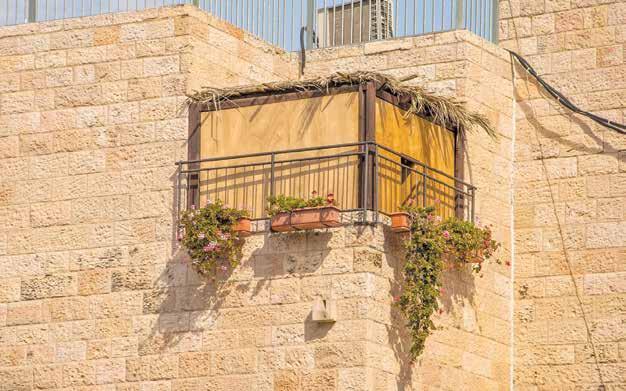
dash was destroyed because of sinas chinam, baseless hatred. It is a difficult Gemara to understand. What is it about sinas chinam that is so horrific that it should result in such terrible destruction? Why does it have such drastic repercussions?
If the Beis HaMikdash reflects our status as Hashem’s children, the Gemara is quite understandable. R’ Chaim Palagi points out that several times in Tanach we see a reference to Bnei Yisrael as “b’ni, My son.”
The expression is in the singular, and R’ Chaim Palagi understands that to be specific. When the Jews are united, functioning as a single unit, then we are
considered “Hashem’s son.” But when there is divisiveness among Jews, our status as “Hashem’s son” becomes compromised.
This same principle is found in the sefer Devash HaSadeh, citing the Eishel Avraham, who expounds upon the verse in Yeshayah (9:5) which refers to Hashem as “Avi ad sar shalom.” The simple translation of this is “Avi ad, eternal Father,” “sar shalom, Prince of Peace.” The Eishel Avraham interprets it homiletically. Hashem can conduct Himself either as a Father or as a Master. The determining factor will be: Are we at peace with one another? Thus, the verse is to be read

as follows: “Avi ad sar, the divide between the attributes of ‘Father’ and ‘Master,’” “shalom, will depend on peace. ” Through peace, we bridge the gap between av and sar.
The sukkah and the Beis HaMikdash are deeply connected, and these two representations of Hashem’s love are one and the same.
In Parshas Re’eh , the Torah discusses the korbanos that are to be brought on each of the three Regalim. These, of course, are brought in the Beis HaMikdash, for which the Torah uses the wording, “Bamakom asher yivchar Hashem Elokecha l’shachein Sh’mo sham, In the place where Hashem, your G-d, will choose to rest His Name” (Devarim 16:2,11).
However, there is an exception to the usage of this expression. The Torah uses it in the context of Pesach and Shavuos; when discussing Sukkos, however, it curiously leaves out the words “l’shachein Sh’mo sham,” to rest His Name. Rather, the pasuk simply says, “Bamakom asher yivchar Hashem, In the place where Hashem will choose” (ibid. v. 15).
The Meshech Chochmah points out this discrepancy. Why is the Beis HaMikdash described differently in the context of Sukkos?
The Gemara (Sukkah 9a) tells us that one may not utilize the wood of the sukkah for any purpose other than the sukkah for all seven days of Sukkos. The reason for this, says the Gemara, is because “chal Shem Shamayim al ha’sukkah, the Name of Heaven rests upon the sukkah .”
This concept is used to explain another halacha as well. The Mishnah tells us that a sukkah must be a minimum of ten tefachim in height. The Chessed L’Avraham writes that this is because we have a rule (Sukkah 5a) that the Shechinah does not descend lower than ten tefachim. The Gemara uses this rule to demonstrate that the Aron placed within the Kodesh HaKodashim was ten tefachim high, allowing the Shechinah to manifest there. This applies to sukkah as well, says the Chessed L’Avraham. The Shechinah rests upon the s’chach, and it therefore must stand lower than ten tefachim.
This begs the question: What is it about the mitzvah of sukkah, over all other mitzvos, that elicits such an intimate bond with the Shechinah?
We can answer this question based on the words of the Shem MiShmuel. Sukkos is referred to as Zman Simchaseinu, the Festival of Our Joy. Why is this? The Shem MiShmuel offers an incredible idea. The sukkah, he writes, is a dugmah, a microcosm, of the Beis HaMikdash. The humble

walls bearing plain slats of wood are somehow akin to no less than the holiest structure in the world, the one whose destruction we mourn and for whose rebuilding we pray.
Regarding the Beis HaMikdash, the pasuk says, “Nagila v’nismecha bach, we will rejoice and be glad in You” (Shir HaShirim 1:4). Just as the Beis HaMikdash elicits joy, so, too, does the sukkah.
•
On Sukkos, each and every sukkah in which Jews sit throughout the world is yet another resting place for Hashem’s Name.
The Rema codifies the prevalent custom that when people take leave of the sukkah, they do so with a designated prayer to merit in the coming year to sit in the protection of the Livyasan
Why would there be a special ritual when taking leave of the sukkah, more than when we complete any other mitzvah? Again, the Pachad Yitzchak explains that since the sukkah encompasses the sanctity of the Mikdash, we take leave of it in the same way we would the Beis HaMikdash. One does not simply leave Yerushalayim; there is a practice of “linah,” when one spends the night before returning home. So, too, taking leave of the sukkah is performed with a special protocol and procedure.
Having established that the kedushah of the sukkah is a paradigm of the sanctity of the Beis HaMikdash, let us probe further to discover why indeed the sukkah has this sanctity.
The Vilna Gaon teaches that the objective of the yom tov of Sukkos is not just to celebrate the miracle of the Ananei HaKavod. We celebrate Sukkos, the Vilna Gaon explains, to commemorate the reinstatement of the Ananei HaKavod, which had no longer afforded protection after the sin of the Eigel HaZahav, Golden Calf. On Rosh Chodesh Elul, Moshe Rabbeinu ascended to Shamayim for the third time, where he davened to Hashem to forgive Bnei Yisrael for the Cheit HaEigel, and on Yom Kippur, Hashem said, “Salachti k’dvarecha, I have forgiven because of your words” (Bamidbar 14:20).
bidg.com, and other venues.
The Shechinah rests upon the sukkah just as it rests upon the Beis HaMikdash.
R’ Yitzchak Hutner, in Pachad Yitzchak , uses this idea to explain the discrepancy pointed out by the Meshech Chochmah Why is it regarding Sukkos, the Meshech Chochmah asked, that the Torah veers from its previous language and writes, “Bamakom asher yivchar Hashem, In the place that Hashem will choose ,” while omitting the phrase “l’shachein Sh’mo sham, to rest His Name” ?
The Pachad Yitzchak explains that on Sukkos, there is more than one place where Hashem rests His Name. On Sukkos, each and every sukkah in which Jews sit throughout the world is yet another resting place for Hashem’s Name.
Although Hashem forgave Bnei Yisrael, they were still deprived of the protection of the Ananei HaKavod, and they felt that forgiveness alone did not suffice. They wanted more than to be forgiven; they wanted ritzui, to be desired, to know that their relationship was restored to what it had been prior to the sin. It was only when the construction of the Mishkan had begun that Hashem openly demonstrated His love for us by again providing us with the Ananei HaKavod. This ritzui, acceptance , took place on the fifteenth day of Tishrei.
Thus, we can understand why the sukkah has the sanctity of the Beis HaMikdash, as it commemorates the return of the Ananei HaKavod and the resting of the Shechinah upon the Mishkan at this very time of the year.
We have learned that the sukkah is akin to the Beis HaMikdash, and we learned that the Beis HaMikdash symbolizes our father-child relationship with Hashem. Bringing this full circle, we can conclude that the sukkah, as well, is a symbol of Hashem’s Fatherly love for His people.
On Sukkos, as we celebrate the joys of the festival, we can celebrate this magnificent truth as well: either way, we are called children of Hashem.


By Rabbi Benny Berlin

Have you ever looked back on something you once did and cringed? You think to yourself, “I cannot believe how immature I was. I cannot believe I thought that was a good idea. If only I could erase that moment completely.” Judaism teaches us to see those very experiences differently. They are not stains to be hidden but steps in the path of our becoming.
On Sukkos, we perform the mitzvah of the Arba Minim, binding together the lulav, hadassim, aravos and esrog. A curious halachic detail arises in how we handle the esrog. Before reciting the blessing, one is instructed to hold it upside down, with the pitom facing downward. Only after the blessing is recited is it turned upright, “k’derech gidulason,” the way it naturally grows on the tree.
The reason seems technical. If the esrog were held upright from the beginning, the mitzvah would already be fulfilled upon taking it with the other species, leaving the blessing out of place.
To avoid fulfilling the mitzvah prematurely, the esrog is first inverted. Only after the blessing is it turned upright, teaching that the true fulfillment is to hold it in the way it grows.
At first, this appears to be a halachic precaution. Yet the ritual conveys a profound spiritual lesson. To serve Hashem authentically, we must serve Him “k’derech gidulason ,” in the way we grow.
The Midrash in Bereishis Rabbah teaches that when Avraham Avinu first recognized the Creator, he felt anguish over the years he had wasted in idolatry. He regretted his past and felt ashamed of his mistakes. Hashem reassured him that even those years were precious, for they were part of the very process that led him to truth. His wandering was not wasted. It was the road by which he grew into faith.
This theme is echoed in contemporary psychology. Samuel and Pearl Oliner studied the Righteous Gentiles, non-
Jews who risked their lives to save Jews during the Holocaust, and compared them with bystanders. One of their most important findings was that rescuers were often raised in homes where authentic moral conversations took place. At the family table, parents and children did not only speak about rules or obedience. They shared their day, reflected on their struggles, admitted mistakes, and spoke about how they could grow.
These conversations created a culture of honesty about the human journey. Children learned that moral life is not about rigid perfection but about embracing the messy process of becoming. That authenticity bred empathy. That empathy became the foundation of extraordinary moral courage. Decades later, when confronted with choices of life and death, these individuals drew strength from the moral habits that had been nurtured in the way they grew.
Sukkos invites us into this same joy of authenticity. To stand with the es -
rog upright in our hands is to declare that our growth is real and our journey is sacred. Every regret, every phase of immaturity, every moment we wish we could erase is still part of our derech gidulason.
That is why the mitzvah is not complete until the esrog is turned upright after the blessing. The act is a declaration that my growth matters, that my path is holy, that my imperfections are part of what I bring before G-d. Serving Hashem k’derech gidulason means bringing our whole selves, including the awkward, the searching, the moments we regret and the moments we celebrate. When we do so, we discover the true joy of Sukkos, the joy of standing before G-d fully and authentically.
Rabbi Benny Berlin is the rabbi of BACH Jewish Center located in Long Baeach, New York. For more information, visit: https:// www.bachlongbeach.com/.

By Rabbi Immanuel Bernstein
An idea that features very prominently in the mitzvah of arba minim is that of hiddur mitzvah—beautifying a mitzvah. Whereas in principle this is something that applies to all mitzvos, when it comes to the arba minim, it takes on an entirely new dimension. In general, if a mitzvah is lacking in hiddur, the mitzvah itself is still kosher. However, if one of the arba minim on Sukkos is sufficiently lacking in hiddur, it is completely disqualified. According to Tosafos, this is based on the fact that the Torah itself refers to the esrog as a pri eitz hadar, indicating that hiddur is an intrinsic characteristic of the esrog, and by extension the other species as well.
How are we to understand the crucial role hiddur mitzvah plays within the arba minim?
The central theme of hiddur is not to “merely” perform mitzvos, but to reclaim them from the sidelines, where they may have been pushed by other less important things. The things we invest in making beautiful are the things that are important to us. This is the (re) orientation of Sukkos, directing our sense of hiddur and beautification toward mitzvah acts.
Indeed, looked at this way, we can see that the sukkah and the arba minim work together as a team, for the sukkah as a temporary dwelling de-emphasizes physical priorities that may have taken over, while the arba minim restore mitzvos to the center of our focus and attention where they belong.
There is another layer here. The idea of hiddur mitzvah with regard to mitzvos generally is derived from the words, “Zeh keli v’anveihu, this is my G-d and I will glorify Him,” which the Gemara explains as communicating the message, “Hitnaeh lifanav b’mitzvos, beautify the mitzvos before Him.” (Shabbos 133b)
However, if we look carefully at these words, we will notice that the word hitnaeh which is reflexive, does not mean to beautify something else, but rather to beautify oneself! This means that the verse is saying, “Beautify yourself before Him with mitzvos.” This seems rather strange.
Since when is beautifying ourselves a value, and what does that have to do with hiddur mitzvah?
Here we are being taught a profound lesson: everyone has something he takes pride in. Although pride is generally considered an extremely negative character trait, this is only when it is self-serving and egotistical. However, taking pride in something that is greater than oneself can actually be very positive. Anyone who is proud to be Jewish is not exercising bad middos, he is expressing something very beautiful and profoundly important. We
lose our way when the things we take pride in shift from matters of ultimate importance to those of lesser importance.
This is the goal of hiddur mitzvah. When we invest in and beautify a mitzvah, we are saying, “The things in life that make me look beautiful are mitzvos like this one!” In truth, that is the greatest honor we can give to a mitzvah.
And so, as we take our arba minim during these seven days, we are reminding ourselves of the things that should make us look good. Those are the things that really count, and they are what deserve our pride, our attention, and our energy. If we can take this lesson and use it to draw up our map of life, the beauty of hiddur mitzvah will be reflected in everything we do in the year ahead.

It is worthwhile concluding our discussion of the idea of hiddur mitzvah on Sukkos by returning to look again at the verse where this idea is taught. Although the concept of hiddur mitzvah applies to all the four species, it is mentioned explicitly only with regard to the esrog (“pri eitz hadar ”), while all the other species are extrapolated from there. There is a very poignant lesson here regarding the entire concept of beauty. The Midrash describes how the each of the arba minim represents a significant part of the body:
• The esrog represents the heart.
• The lulav represents the spine.
• The hadasim represent the eyes.
• The aravos represent the lips.
As we know, it is very easy for beauty to become a purely external display, with all emphasis on appearance and none on inner content. To this end, the verse links the concept of hiddur specifically with the esrog, representing the heart, as if to say, the way you carry yourself (lulav), look (hadas), and speak (aravah) in Jewish living should all be a product and expression of how much your heart (esrog) cherishes the Torah’s mitzvos and values. For true hiddur comes from the heart.
The verse in the book of Eichah reads (Eichah, 2:1), “Hishlich m’shamayim eretz tiferes Yisrael.” The basic meaning of these words is that they are lamenting the fallen glory of Israel, which has been cast down from the heavens to the ground.
However, there is another underlying meaning. Everyone has his tiferes—his sense of glory, the things he takes pride in, the things he boasts about. The problem begins when the tiferes of Israel falls from taking pride in heavenly things, shamayim, and focuses instead on earthly or temporal things, eretz.
As we use these days to take stock of our lives and how we have been leading them, an underlying question is, “Where is my tiferes? What do I take pride in, and why?”
Much of what we need to do teshuvah for by the time Rosh Hashana comes around can be traced back to this imbalanced perspective that has diverted our tiferes from “heaven” to “earth.”
Hence, a central part of our rehabilitation involves restoring it to its rightful place.


By Ra BB i aR yeh Dachs
he reading of V’zos Habracha, the final parsha in the Torah, takes place during a magical time, amid spirited dancing and revelry.
Shuls have a large kiddush to which everyone is invited. Candies are given to all the children. Everyone is called to the Torah on this day. The community makes it a point to ensure that everyone is part of the celebration.
V’zos Habracha is not read on Shabbos; it is read on the holiday of Simchas Torah, which, as the name of the day suggests, is a joyous day. I always understood that on Simchas Torah we celebrate the completion of the reading of the Torah. It is similar to the celebration of a siyum, the festive meal with which we celebrate the completion of a significant portion of Torah study, or a tractate of the Mishnah or Gemara. The simcha, joy, of the day accompanies our communal siyum of the Torah we’ve read week in and week out throughout the year.
However, the Sefas Emes explains that the joy of Simchas Torah is also the other way around. The holidays of Sukkos and Shemini Atzeres/Simchas Torah are an especially joyous time. We therefore channel that joy to coincide with our completion of the Torah. He continues with an idea he heard from his rebbe, Rabbi Menachem Mendel of Kotzk. The day of Simchas Torah is referred in
the Torah as “Atzeres,”and Rashi teaches that this means “kenufiya,” a gathering (for food and drink).
The verse in V’zos Habracha calls the Torah itself, a “morasha kehillas Yaakov —an inheritance for the gath-
Even when the Jewish People are not acting in a way that befits Hashem, Hashem still rejoices in His lot: His people, the Jewish People.
ering of Yaakov.” It is therefore only appropriate for the Torah to be celebrated when the Jewish people are united as a “kehilas Yaakov.”
G-d’s Lot
This story is brought up in a footnote in the sefer,
Chofetz Chaim al HaTorah, on Parshas Haazinu.
Once, Rabbi Chaim of Volozhin had difficulty understanding a cryptic statement made in the ancient text, Tanna D’Bei Eliyahu. The statement of the Tanna D’Bei Eliyahu delineated different attributes of Hashem. One of these is that Hashem finds joy in His lot; He is sameiach b’chelko. This is obviously a baffling statement.
People have a “lot” apportioned to them by the Almighty. It is praiseworthy when they find joy in, or are even content with, their lot. G-d apportions; He does not have a “lot” apportioned to Him. There is no concept of G-d finding joy in His lot!
Rabbi Chaim of Volozhin presented this question to his rebbi, Rabbi Eliyahu, the Gaon of Vilna. The Gaon explained that in Parshas Haazinu the Jewish People are called “chelek Hashem,” G-d’s portion. Even when the Jewish People are not acting in a way that befits Hashem, Hashem still rejoices in His lot: His people, the Jewish People. We are His people. He loves and appreciates us unconditionally. Even in our lowest moments, Hashem finds great satisfaction in us.
Perhaps, we can find a way to appreciate ourselves, even when we don’t feel that special.
This article has been excerpted from Our Parshah by Rabbi Aryeh Dachs, published by Mosaica Press.

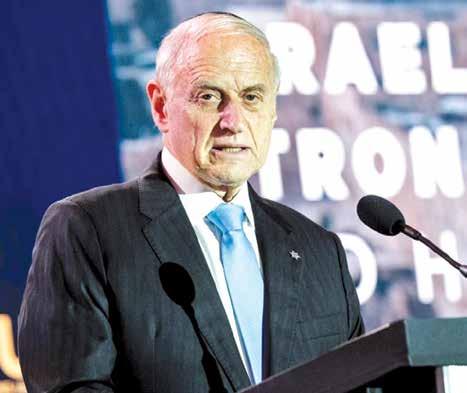
Malcolm Hoenlein doesn’t speak in slogans or chase headlines. He speaks with the weight of experience— measured, deliberate, and shaped by more than five decades of leadership in Jewish communal life and international affairs. As one of the most influential yet discreet figures in American Jewish advocacy, Hoenlein has long operated behind the scenes, advising U.S. presidents, Israeli prime ministers, and global leaders while steering some of the most consequential efforts in modern Jewish history.
He is best known for his role as Executive Vice Chairman of the Conference of Presidents of Major American Jewish Organizations, a position he held for over three decades, where he became a central player in shaping American policy toward Israel and the Middle East. Before that, he founded and led the Greater New York Conference on Soviet Jewry and later founded and served as executive director of the Jewish Community Relations Council of New York. His activism began in the 1960s, organizing rallies, lobbying governments, and galvanizing public opinion to support persecuted Jews in the Soviet Union and Arab countries.
Through quiet diplomacy, relentless advocacy, and a deep network of relationships, Hoenlein has helped guide the American Jewish community through shift-
By S. Schwartz
ing political landscapes and global challenges. But if you ask him how it all began, he’ll brush aside any notion of a singular turning point.
“It wasn’t a defining moment,” Hoenlein says. “It was the course of my life from the age of 10. I was drawn to political activity. The Shoah was formative for me, impressing upon me the importance of advocating for my fellow Jews and having the ability to determine our own fate. My father got out on the last boat from Holland, and my mother smuggled herself through Germany and France to get to Cherbourg and then to Philadelphia. I remember vividly when they got the notices that their families had been killed.”
That sense of inherited responsibility never left him.
“I didn’t control the course,” he reflects. “I never looked for a job in my life. Everything happened to me, and I believe I was blessed to spend my life doing what I cared about most. It may not have been the most lucrative path, but it was the most meaningful. I care deeply about our people, about Israel, about our faith, about our very existence—and we’re being challenged in many ways today.”
“I grew up in Philadelphia,” Hoenlein says, “not from money or position, just a regular family. But I was given a strong Jewish education. From early on, I was exposed to people who shaped me—rabbis, teachers, role models. I can’t say it was one person. There were many along the way. Later, I had the privilege to
meet some of the great figures of our time—Rebbes, prime ministers, world leaders. Many of them helped me a lot and extended themselves for me, people like Senator Scoop Jackson. I’ve worked with every president since Jimmy Carter. That didn’t come because I planned it or chased it. It came because Hashem opened doors. I met giants when I was still young. I remember the Lubavitcher Rebbe and the Bobover Rebbe, zt”l; just being in their presence had an effect. I didn’t seek many of those opportunities. They came, and I felt I had to rise to them.
“You don’t always know at the time what’s happening, but you look back and you see a pattern. I didn’t have a map. But I had a sense of mission, and I had emunah. That’s what guided me.”
Hoenlein speaks of these relationships not as name-drops but as building blocks of a broader strategy – one that aimed to bridge the gap between the passionate urgency of the grassroots and the institutional weight of the establishment.
“When I came to New York to start the Soviet Jewry Conference,” Hoenlein recalls, “we succeeded because I reached out to grassroots communities. I saw that if we could combine the energy of the grassroots with the power and capabilities of the establishment, that would be the key to our future.”
He understood early on that change couldn’t come from the top alone.
“You can have the influence in Washington or Je -

rusalem,” he says, “but if you don’t have the people, if you don’t mobilize them, it won’t last.”
That philosophy guided his work not only for Soviet Jewry but across decades of activism –whether it was organizing rallies that filled Madison Square Garden, working with student groups or quietly advising heads of state.
His belief in achdus isn’t just tactical; it’s spiritual, too.
“Every miracle that’s happened to the Jewish people came when we were united,” Hoenlein notes. “From Har Sinai to the rescue of Russian, Ethiopian, Iranian and Syrian Jews. It is the one precondition that Hashem set. That’s why I’ve always worked within umbrella organizations. You might have to work with people you sometimes disagree with. It’s not easy, but it’s essential.”
One of the most pivotal moments in his career came when he had to choose between two major leadership positions.
“The same day I was offered to head the Conference of Presidents, I was also offered the top job at UJA Federation of New York. That job paid many times more and had a staff 100 times the size. I was torn, because both jobs were in important roles that would help Klal Yisroel. Everyone had an opinion about what I should do – politicians, rabbanim, colleagues.”
It was his son who clarified things.
“He was maybe 13 years old, and he sat down with me and asked, ‘What’s the real choice you’re facing?’ I answered him honestly. And he said, ‘You’ll never do
“ i didn’t have a map.
But i had a sense of mission, and i had emunah . t hat’s what guided me.”
anything just for money. Where are you going to make the biggest difference?’ That was it. That was my answer. And now, I can look back and say I played a role in rescuing Jews from Russia, Syria, Ethiopia, Yemen, Iran, Iraq... What greater reward is there?”
To an outsider, it might seem glamorous and exciting to have an entree into the halls of political and diplomatic power, and it can be. But as Hoenlein says, “The only value of recognition and respect is if it gives you access to help others and accomplish your goals.”
When asked for some memories of instances where his access made an impact, Hoenlein replies with the cautious discretion of a seasoned veteran. Some of his efforts with regards to Israel and Soviet Jewry cannot

be discussed in full detail, but he recalls a different striking example of how access made all the difference.
“There was a 48-hour window during the Ethiopian revolution where we could get Jews out. I went to see General Scowcroft, then Chief of Staff to President Bush Senior, and made the case. They said they needed someone on the ground that weekend, with presidential backing.”
Hoenlein picked up the phone and called Senator Rudy Boschowitz, who was in Vail skiing at the time.
“I said, ‘I don’t have time to explain. Will you go to Ethiopia this weekend for the Jews?’ He agreed immediately. Just like that. No questions asked.”
General Scowcroft initially rejected the plan; Hoenlein acted on instinct.
“He got a call to go in and see the President. I think we were all expected to leave, but I told everyone to stay put. As he was walking out to meet the President, I said, ‘May I ask one thing, please? Could you ask the President if he can afford to see pictures of dead Ethiopian Jews like the dead Kurds that were on the front page of today’s New York Times?’ He looked horrified. Honestly, I don’t know where the words came from. Hashem put them in my mouth.”
Minutes later, Scowcroft returned.
“He sat down, looked at me, and said, ‘The President said yes.’
“That led to the Boschowitz mission, the negotiations and the ultimate rescue.”
There were other moments – tense, high-stakes, behind-the-scenes efforts – that didn’t always make the headlines but made a difference. One example he recalled vividly involved the Jewish community in Syria and the need to keep the U.S. administration to its commitments.
“There was enormous pressure at the time,” Hoenlein recalled. “You had to push past bureaucratic inertia, past diplomatic pleasantries. We had assurances from Secretary of State James Baker and Vice President Dan Quayle about a specific date when action would be taken. They said December 5. That date came and went, and nothing happened.”


With President George W. Bush
But Hoenlein didn’t let it slide.
“We met at a White House event, and I told them, ‘You said December 5. Well, today is December 6.’ And I kept pressing. The next day, we had the decision.
“There were many times like that, where I heard myself say things I couldn’t explain. I really believe Hashem puts the words in your mouth. You have to build relationships, do the work, and be patient. Too many people today are quick to condemn and criticize the politicians. But real influence takes investment and time.”

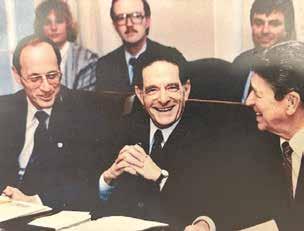

Despite his activism – including leading more demonstrations than any other living Jewish figure – Hoenlein insists that passion alone isn’t enough. He warns against ego-driven leadership.
“Activism must be guided. You consult poskim, with political experts. Even now, after six decades, I don’t act alone. If your goal is kavod, you won’t achieve anything in the long term. Those are byproducts of real work that is done. I didn’t have PR people for most of my career. You should be known for what you do, not what you say you do.”
Looking back over the decades of American Jewish life, Malcolm Hoenlein doesn’t see a single transformative moment. He sees a mosaic – shifting, restless, layered with complexity.
“That’s a book, not a question,” he chuckled when asked to identify the most significant shift he’s witnessed. “There were constant changes, and you have to be flexible enough to maneuver. You can’t be rigid.”
Over the years, Hoenlein has worked with an enormous diversity of leaders – religious and secular, indifferent to Judaism and passionately engaged. This expresses one of the core lessons of his career: the importance of achdus and building coalitions.
“I’ve had chair-people over the last 60 years who ran the gamut – some people who didn’t know a thing about Yiddishkeit but who were influential leaders. You couldn’t find a bigger variety anywhere. Heinz can’t come close with its 57 varieties. And I realized it was my job to adjust to them, to earn their respect. You don’t demand it. You earn it.”
He recalled an early moment with one of the newly appointed chairmen – an accomplished, well-meaning individual who simply lacked exposure to Jewish tradition.
“It was his first week on the job,” Hoenlein said. “I told him the office would be closing early for Shavuos. He looked at me and said, ‘What date does your holiday begin?’ He had no idea what Shavuos was. It wasn’t hostility – it was just unfamiliarity.”
That wasn’t unusual. Many of the lay leaders and public figures Hoenlein worked with over the years came from secular backgrounds, without formal Jewish education or a strong connection to Yiddishkeit.
“They weren’t antagonistic. They just never had the chance to be exposed,” he said.
But things changed. Through their work together, he witnessed many of them grow in their Jewish identity.
“By the time that chairman left his position,” Hoenlein said, “he never failed to call me every Friday to say, ‘Good Shabbos.’ That meant a lot. It showed that relationships, sincerity, and shared purpose could move people – not through lectures, but through example.”
In his early years at the JCRC, Hoenlein discovered how little exposure many Jewish leaders had to the Orthodox community.
“Most had never been to Boro Park or Flatbush. So I organized a trip to take them to see the Bobover Rebbe. We drove up in three black limos, and by the time we came out, mobs were in the street trying
to figure out who was in the cars. We had influential people like Larry Tisch and George Klein with us. The Rebbe was incredible; he won their hearts, minds, and souls. I knew it wouldn’t fail to make an impression. I took them to see the Satmar Rebbe, the Lubavitcher Rebbe, Rav Soloveitchik. It opened a whole new world for them. These were people for whom much of the frum community was alien. After that, some of them continued to go visit those gedolim on their own.”
Hoenlein saw the Soviet Jewry movement as a model for the type of coalition building where people from diverse backgrounds and positions in society came together to achieve something great.
“ i said, ‘ m ay i ask one thing, p L ease? Cou L d you ask the p resident if he C an afford to see pi C tures of dead e thiopian Jews L ike the dead k urds that were on the front page of today’s n ew York Time S ?’”
“We needed the energy of the grassroots. High-level meetings wouldn’t matter if we couldn’t show we were in the streets. That led to creating Solidarity Day. No one wanted to help us with the first one – until 50,000 people showed up. Suddenly, everyone took credit. After that, every year, we built the numbers. Solidarity Day became so powerful, even the Soviets would try to preempt us with gestures, releasing prisoners, to blunt the impact. We had Black Americans for Soviet Jewry, Hispanic leaders, doctors, lawyers. We made it the number one human rights cause in the world. And not just Jews came – once the Jews were there, others joined.”
Asked whether his religious convictions ever conflicted with his political responsibilities, Hoenlein was firm: “I wouldn’t compromise, but you have to be flexible and know how to maneuver situations diplomatically.”
He recalled the earlier years of his work, when ko -
sher food wasn’t a given at major functions –even at the White House.
“I insisted on kosher. I wouldn’t eat otherwise. I wear a yarmulke because you have show you are confident with who you are. I find that people respect you if you’re consistent, if your word is your word. Because I have always been proudly observant, and leaders see that consistency, I have earned their trust. I’ve had presidents of the United States and leaders from Arab countries share things with me in confidence, and they say, ‘Everyone knows you don’t leak.’
“Today, almost everything leaks. It could be fun once in a while to make a headline because of what you know. But it’s better to have the leverage to do good than get five minutes of fame from a juicy tweet. Instant gratification might get you your name in the paper, but you lose the ability to do real work, because you lose people’s trust, and that is the ultimate currency.”
When it comes to future Jewish leaders, Hoenlein didn’t mince words.
“When we look at future Jewish leadership, they have to be Jewishly knowledgeable. Many are not. And leadership has to come from a sense of mission. Your position should never be the goal – that’s how you fail. It can be the result, but it can’t be the objective. You have to put the community first.
“I’ve met with a lot of these influencers. Many of them are well-intentioned, and some are very smart. But they often lack experience. They say things, post things, without realizing the consequences. We’ve had cases where tweets endangered Jews. If they had come to us, we would have told them not to put that out. But many of them are good Jews – and they’re hungry. They want knowledge, they want connection.
“After October 7, there was a real shift. I call them the ‘October 8 Jews.’ There’s new grassroots energy. Non-observant young Jews started having Shabbos events. Sometimes it wasn’t really Shabbos – they’d say kiddush, but nothing was kosher. Still, it showed a hunger and a desire to reconnect, and that’s something we can work with. There’s a revolution happening. It’s not just reactive; it’s positive. There’s a group of young people I am working with who are doing cutting-edge work fighting antisemitism, off and online. But we need a revolution in funding, too. We’re winning battles against Jew hatred, but we’re losing the war.”
Asked to name the hardest and most rewarding moments of his long career, Hoenlein paused.
“The most intense moment personally? Choosing between the two jobs, at the UJA Federation and with the Conference of Presidents. On a communal advocacy level, there were major decisions that really stand out, like the Iran 13.”
In 1999, thirteen Iranian Jews were arrested by the Iranian government and accused of espionage for Israel. Among the accused were teachers, shochtim, and the shammashes of a shul, all who lived in the cities of Shiraz and Isfahan. The charges were widely regarded as baseless and politically motivated, but their lives were at stake.
That case, Hoenlein said, tested everything.

“We organized efforts around the world and ran demonstrations. At the same time, we were negotiating privately. We knew the 13 Jews were at risk of heavy prison terms, maybe even execution. I promised the Iranians they wouldn’t be embarrassed if they kept their word. All 13 were released. It taught me even the most extreme regime can respond, if you approach them the right way. I got letters from leaders of nearly every Arab and Muslim country. Some put themselves at risk just to say: don’t hurt these Jews.”
It was during that tense period that Hoenlein’s communication with the families of the prisoners was cut off. Rabbi Herman Neuberger, zt”l, of Baltimore called with a lead.
“He said, there’s this lawyer, a reporter, who might be able to help.”
The man was in Paris. Hoenlein called him.
“As soon as I started the conversation, he said: ‘Stop. I’m coming to New York next week. We’ll talk then.’”
They met in Hoenlein’s office and spoke for hours.
“He said he would help. And he did. He was going to Iran, and he quickly re-established a vital phone connection for us.
“Soon after, the man traveled to Iraq, where he was arrested and executed. His name was Daniel Pearl. His final words, recorded on video by his terrorist murderers, were ‘I am a Jew. My father is Jewish. My mother is Jewish. My grandfather has a street named after him in Israel.’ He did it for us.”
With our conversation drawing to a close, we turned to reflect on current events.
Starting in 1990, Hoenlein has been one of the most prominent voices sounding the alarm on Iran’s nuclear ambitions.
“Bush Sr., Bush Jr., Clinton – I saw them all about Iran. For thirty years, people were dismissive of the danger. Now they write me letters. They apologize. But this isn’t about ego. If you understand history, you see the trends.”
Asked about the recent war with Iran and its broader implications, Hoenlein responds with a blend of


pride, concern, and unwavering resolve.
“I think it’s quite remarkable what has been achieved in the last few weeks,” he began. “Nobody could have predicted it. The fact that the U.S. got involved, that Israel acted the way it did, the changes that have taken place – they’re astonishing. Israel had
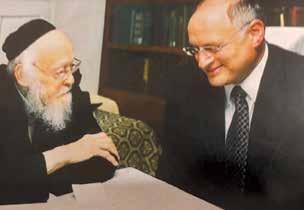

control of the skies. You had the destruction of so much military infrastructure and elimination of key leaders. Whether we completely destroyed the nuclear facility or not, the fact is, they’re set back. Iran invested tens of billions in militias in Iraq and Syria, Hezbollah in Lebanon, Hamas, the Houthis. This was their vaunted ‘Ring of Fire,’ and Israel turned it into a hula hoop.
“People underestimate what this little country –this speck on the map – has accomplished. Iran is seventy times its size, with ten times the population and enormous oil revenues. Yet Israel dismantled a regional terror infrastructure. The Arab world – they say it quietly – but they tell us: ‘Decimate them. Don’t stop.’ They can’t say it publicly, but that’s the message. And we have to take it seriously.”
Hoenlein warned against focusing only on technicalities or the limited tactical victories.
“The regime in Iran may not fall tomorrow. But the nature of the threat has changed. That opens the door for new coalitions – not just with Saudi Arabia, but other Muslim and Arab countries, too. Germany’s chancellor said Israel is doing the dirty work for Europe. That’s wrong. Israel’s doing the clean work. Cleaning up the mess Europe made by enabling Iran, by refusing to hold them accountable for violations of the JCPOA, for their ballistic missiles, for their support of terror. They don’t need ballistic missiles for Israel. Those are aimed at America and Europe. Israel’s just the minor devil. America’s the great one. That’s how the Supreme Leader sees it. And we ignore that at our peril.
“Despite everything happening in the Middle East, what’s happening here in America frightens me more,” Hoenlein said, his voice marked not by despair, but by the urgency of someone who has seen the warning signs before. “I used to reject comparisons to the Shoah. I’d say it diminishes that unique horror. But now? I’m not so sure. What we’re seeing in universities, in the streets – it’s like the 1930s.”
He pointed to the candidacy of individuals with anti-Israel platforms, and the normalization of anti-Semitic rhetoric masquerading as political critique.
“People think the system will protect us. But I’ve seen how serious this is. They recently reviewed one curriculum used in 8,000 public schools and found that it was blatantly hostile to Israel.”
And yet, even facing this, he insists on a Jewish framework for resilience and responsibility.
“In Judaism, we look back in order to look forward. We learn from the past not to live in it, but to build something better. Chazal said it long before Churchill: that to see the future, you have to look to the past. For us, history is about the future.”
He has spent decades warning about the rise of anti-Semitism in America, too often to audiences who shrugged it off.
“I don’t want more memorials for dead Jews. I’m tired of the crocodile tears. We cry after the fact but ignore the signs. Anti-Semitism is a cancer. It metastasizes. And if you wait too long, you can’t fight it.”
He condemned the political hypocrisy he’s witnessed firsthand, mentioning a mayoral candidate who expressed sorrow over the murder of a Jewish woman
in Boulder while simultaneously promoting the very ideologies that, in his view, had enabled the violence.
“Only if we’re willing to stand up – only if we vote, organize, and speak out – can we protect our communities. It’s a disgrace when Jews don’t vote. Every yeshiva graduate should get a voter registration form. Every shul should talk about civic engagement. If every Jew in New York voted the right way, we’d change the outcome of every election.”
When asked what advice he’d give to someone inspired by his career, Hoenlein didn’t romanticize the work.
“Think about it again,” he said jokingly.
“But seriously, there’s nothing more rewarding. Nobody can take away what you do for Klal Yisrael. Not a stock market crash. Not real estate losses. What you build for the Jewish people –that’s eternal.”
He urged young people to get educated, try different paths and discover their strengths. Some would be lawyers, advocates. Some would work quietly behind the scenes. All roles mattered.
“ i ’ve had presidents of the u nited s tates and L eaders from a ra B C ountries share things with me in C onfiden C e, and they say, ‘ e veryone knows you don’t L eak.’”
“The people who worked for me – secretaries, assistants – they deserve as much credit as I do. They enabled the work. And above all: unity. I worked in umbrella organizations for a reason. Hashem wanted one thing before every miracle: Jewish unity. That’s the precondition. It doesn’t mean uniformity. Unity isn’t homogeneity. It means we understand what we share and build from there. Open your mind. Learn. Read. Get involved. And then ask yourself where you can do the most good.”
In the end, for Hoenlein, the future of Jewish life – its security, its flourishing, its moral voice –depends not on grand gestures or political theatrics, but on the quiet, determined work of those who show up, stay informed, and are bound by the eternal mission of uniting for the good of Klal Yisroel.

By David Brummer
Yosef Stern’s journey to Orthodox Judaism reads like a modern spiritual odyssey, one that took him from militant atheism through various philosophical explorations, a brief flirtation with Catholicism complete with a significant moment of Divine intervention, and ultimately to the study halls of Aish in Jerusalem.
Stern’s story begins at his private high school, where he embodied the archetypal secular progressive. As the head of all progressive clubs and a self-described “SJW” (social justice warrior), he held what he now characterizes as “a very secular, atheist, anti-religious worldview” (despite the fact that the manner in which proponents hold so fast onto these views is by its very nature quite religious). This wasn’t merely intellectual skepticism; it was active opposition to religious thinking in all its forms.
But beneath the confident exterior of a teenage activist lay deeper questions about meaning and purpose. Stern describes reaching “an existential crisis” as post-high school, he observed the people around him “pursuing money and career” while witnessing how “money caused a lot of destruction and
tore apart families.” His identification of these superficial pursuits left him feeling that life was fundamentally meaningless.
“I was the class clown, and I reached an impasse,” Stern recalls. “I realized it wasn’t sustainable, and I then asked the big questions, starting with the realization that there’s more to life than what I know.” This recognition that his atheistic worldview couldn’t provide the depth of meaning he was seeking marked the beginning of a philosophical journey that would span several years.
Recognizing that he had been “taught what to think rather than how to think,” Stern embarked on a deliberate investigation to “seek out how to make sense of the world.”
Through the mentorship of a trusted advisor, Stern discovered perennialism, a philosophical school suggesting that all religions represent different cultural expressions of the same universal truth. This framework provided him with his first positive engagement with spirituality.
His philosophical explorations eventually led him to an unexpected place: the Latin Mass at a Catholic church in Connecticut. Accompanied by his
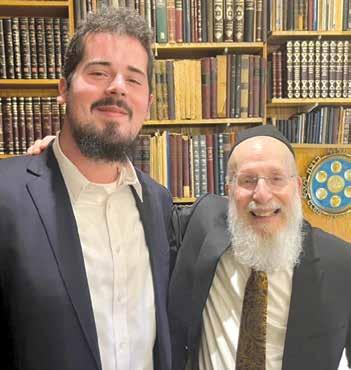
friend, David, Stern found himself drawn into a community of sophisticated believers, many affiliated with Yale’s Divinity School. These weren’t the anti-intellectual fundamentalists he might have expected but rather “smart, sophisticated, warm, loving” individuals who opened their hearts and their homes, and offered “empirical and scientific proofs of there being a creator.”
The Catholic phase of Stern’s journey came to an abrupt and dramatic end during what seemed like a moment of integration into the community. At a post-Mass coffee hour, as congregants shared their personal faith stories, Stern prepared to contribute his own narrative. After swallowing hard and plucking up significant courage he began with the unforgettable line, “Actually, I’m Jewish,” and, as if Divine intervention was the order of the day, at that exact moment, “all the lights and power went out in the church.”
While others might dismiss such timing as coincidence, Stern interpreted it as G-d sending him a “clear message.”
The incident prompted a complete reevaluation of his spiritual path and ultimately led him to investigate his own Jewish heritage for the first time.
Stern’s initial exploration of Judaism began on YouTube, where he discovered “Seekers of Unity,” content created by Rabbi Zeevi Slavin, a Chabad chassid who explored various spiritual traditions from a Jewish perspective.
“It blew me away,” Stern recalls. “I totally fell in love, and I inhaled all his YouTube content.”
His path to Aish was facilitated by a network of relationships he developed in Florida. Through his best high school friend Alec (now Eliyahu), who worked in New York’s Diamond District, Stern was introduced to Orthodox Jews for the first time. This eventually connected him to the Miami Beach Kollel, which he describes as “Tower 41, one of the holiest buildings in the Diaspora.”
At the Kollel, Stern formed a crucial relationship with his first study partner (chavrusa), Simcha, whom he calls “a super-holy, special guy” and “my biggest inspiration, a truly amazing person.” The depth of Simcha’s commitment was demonstrated on the day before Stern’s departure for Aish, when Simcha “bought a refundable ticket so he could come and learn with me at the gate and subsequently get a refund for the flight he didn’t take.”

More importantly, Simcha provided Stern with a living example of what integrated Jewish life could look like. Observing Simcha’s approach to “serving G-d and looking after his family” created a striking contrast to Stern’s previous social circles and offered a refreshing alternative to his pessimistic view of society.
Despite his growing attraction to Jewish life, Stern maintained intellectual rigor in his spiritual seeking.
“Intellectually, and rationally I was hesitant,” he explains. “How do I know Torah is true? There’s a lot to take on and keep, before I fully dive in.”
Simcha connected him with Gust, a convert from Mormonism who had become an Orthodox Jew and now “debates atheists, Muslims and Christians, about the truth of Torah.” Through this individual and other influences, including Rabbi Lawrence Keleman and Rabbi Ken Spiro, Stern was exposed to intellectual arguments for Torah’s authenticity.
Crucially, Stern didn’t simply accept these arguments but engaged with them critically: “I took the time to look through everything they said and went into count-
er arguments.” This thorough intellectual process led him to conclude that “as a Jew I need to learn and keep Torah.”
Stern’s arrival at Aish was marked by what he interpreted as divine providence, finding a ticket for “about a third of the usual price” after receiving a lengthy blessing from Rabbi Moshe
He
perience is unequivocal: “I didn’t know what to think before coming here, but it’s totally exceeded anything I could have imagined.”
Perhaps most remarkably, Stern’s transformation has had profound effects on his family relationships. His four-year-old sister is now enrolled in a
began with the unforgettable line,
“Actually, I’m Jewish,” and, as if Divine intervention was the order of the day, at that exact moment, “all the lights and power went out in the church.”
Wolfson, zt”l, mere days before his passing, which he saw as a sign “Hashem was telling me I have to go.”
More than a year later and having initially expressed wonderment that the place he now calls home “didn’t seem real,” Stern’s assessment of his Aish ex-

Jewish preschool, “understanding, and building a relationship with Hashem,” facilitated by their mother’s support. Even more surprising, his relationship with his father has improved dramatically: “My dad thought he’d lose me and I’d reject him, and I’ve had the best re -
lationship with him I’ve ever had in my life. We speak several times a week, and I’ve really understood what it means to honor your mother and father. One of my most cherished photos is of my dad wrapping tefillin in his office.”
Looking ahead, Yosef plans to stay in Israel and build “a holy Jewish family.” He’s working on a book compiling his learnings and hopes to help others in similar situations.
When asked what he would tell his past self, Yosef reflects thoughtfully: “I wish I had never eaten treif or done those aveiros , but I think it took me going through all those experiences to make the most of all the opportunities I currently have. Part of me wishes I was FFB [frum from birth], but at the same time, because I went through those experiences and had that journey...”
His voice trails off, but his meaning is clear. Every step of his winding path led him to where he was meant to be, in Jerusalem, immersed in Torah, discovering the depth and meaning he had sought all along.
“My time studying Torah has been the best experience of my life,” Yosef concluded.







With the weather turning cooler and some days filled with sheets of rain, we hope that the sun will smile kindly upon us as we go on chol hamoed outings as a family this Sukkos. If we’re lucky enough to get balmy weather, we can take advantage of the wonderful experiences available outdoors. And if gimshei bracha shower upon us, there are interesting trips to go on indoors as well – so take your pick! Spending time with the family is the goal, wherever the day may take you.
TJH has compiled a list of ideas, activities, and places to go for you to enjoy.
Make sure to pack enough food, a portable sukkah, and music for the road and have fun!
Queens County Farm Museum
73-50 Little Neck Parkway, Floral Park, NY 11004 718-347-3276
White Post Farms
250 Old County Road, Melville, NY 11747 631-351-9373
Long Island Aquarium and Exhibition Center
431 East Main Street, Riverhead, NY 11901 631-208-9200
New York Aquarium
Surf Avenue & West 8th Street, Brooklyn, NY 11224 718-265-FISH
Prospect Park Zoo 450 Flatbush Avenue, Brooklyn, NY 11225 718-399-7339
Queens Zoo
53-51 111th Street, Flushing, NY 11368 718-271-1500
Central Park Zoo
64th Street & 5th Avenue, New York, NY 10065 212-861-6030
Green Meadows Farm Brooklyn
At the Aviator Sports Center 3159 Flatbush Avenue, Brooklyn, NY 11234 718-470-0278
Bronx Zoo 2300 Southern Blvd, Bronx, NY 10460 718-220-5103
Long Island Game Farm 489 Chapman Boulevard, Manorville, NY 11949 631-873-6644
Schmitt’s Family Farm 6 Bagatelle Road, Dix Hills, New York 11746 631-549-3276
Union Square Greenmarket Union Square West, New York, NY 10003 212-788-7476
Lawrence Farm Orchards 39 Colandrea Rd, Newburgh, NY 12550 845-562-4268
Rose Hill Farm 19 Rose Hill Farm, Red Hook, NY 12571 845-758-4215
Greig Farm 227 Pitcher Lane, Red Hook, NY 12571 845-758-8007
Central Park

Boating, biking, the Great Lawn, model-boat sailing, carriage rides, carousel Between 5th & 8th Avenues and 59th & 106th Streets, New York, NY 212-360-3444

Bryant Park 6th Avenue, between W 40-42 Street, New York, NY 10018 212-768-4242
New York Highline Gansevoort St. to West 30 St. between Washington St. and 11 Ave., New York, NY 212-500-6035
Brooklyn Bridge Park 1 Main Street, Brooklyn, NY 718-222-9939
Summit One Vanderbilt
45 E 42nd St, New York, NY 10017
Little Island Floating Park Pier 55 in Hudson River Park West 13 Street, New York, NY 10014

Fort Tyron Park Riverside Drive to Broadway, W 192 Street to Dyckman Street, New York, NY
New York Circle Line
Pier 83, West 42nd Street, New York, NY 10036 Pier 16, South Street Seaport, New York, NY 10038 212-563-3200
Statue of Liberty/Ellis Island Ferries from Battery Park, NY 1 Battery Place, New York, NY 10004 212-363-3200

Old Westbury Gardens
71 Old Westbury Road, Old Westbury, NY 11568 516-333-0048
Sagamore Hill 20 Sagamore Hill Road, Oyster Bay, NY 11771 516-922-4788
Sands Point Preserve 127 Middle Neck Road, Sands Point, New York 11050 516-571-7901
Great Neck Steppingstone Park
38 Stepping Stone Lane, Great Neck, NY 11021 516-487-9228
South Street Seaport
89 South St., New York, NY 10038 212-732-7678
Brooklyn Botanic Gardens
900 Washington Avenue, Brooklyn, NY 11225 718-623-7200
Brooklyn Heights Promenade Downtown Brooklyn—Remsen Street to Orange Street along the East River
The New York Botanical Garden 2900 Southern Boulevard, Bronx, NY 10458 718-817-8700
Wave Hill Public Gardens
675 W 252 St, Bronx, NY 10471 718-549-3200
Roosevelt Island Tramway
300 E Main St, New York, NY 10044 212-756-7476
Historic Richmond Town 441 Clarke Avenue, Staten Island, NY 10306 718-351-1611
Bear Mountain State Park Route 9W North, Bear Mountain, NY 10911 845-786-2701

Harriman State Park Seven Lakes Dr. / Bear Mountain Circle, Ramapo, NY 10974 845-947-2444
The Amish Village
199 Hartman Bridge Road, Ronks, PA 17572 717-687-8511
Mystic Seaport
75 Greenmanville Avenue, Mystic, CT 06355 888-973-2767

Adventureland
2245 Broad Hollow Road (RT 110), Farmingdale, NY 11735 631-694-6868
Adventurer’s
1824 Shore Pkwy, Brooklyn, NY 11214 718-975-2748
Luna Park Coney Island 1000 Surf Avenue, Brooklyn, NY 11224 718-373-5862
Bayville Adventure Park
8 Bayville Ave, Bayville, NY 11709 516-624-7433
Sahara Sam’s Oasis and Water Park & Diggerland
535 N Route 73, West Berlin, NJ 08091 856-767-7580
Nickelodeon Universe Theme Park 1 American Dream Wy, East Rutherford, NJ 833-263-7326
Six Flags Great Adventure
1 Six Flags Blvd., Jackson Township, NJ 08527 732-928-2000

Hershey Park 100 Hersheypark Dr, Hershey, PA 17033 717-534-3900
ZooAmerica 201 Park Ave, Hershey, PA 17033 717-534-3900
Island Water Park 801 Boardwalk, Atlantic City, NJ 08401 YeshivaMidwinter.com
Legoland Discovery Center Westchester 39 Fitzgerald Street, Yonkers, NY 10701 844-740-9223
Fun Station USA
3555 Victory Blvd, Staten Island, NY 10314 718-370-0077
The Funplex 3320-24 NJ-38, Mount Laurel, NJ 08054 856-273-9666
Laser Bounce 80-28 Cooper Avenue, Glendale, NY 11385 347-599-1919



Laser Bounce 2710 Hempstead Turnpike, Levittown, NY 11756 516-342-1330
RPM Raceway Go-Karting 40 Daniel St, Farmingdale, NY 11735 631-752-7223
RPM Raceway Go-Karting 99 Caven Point Rd, Jersey City, NJ 07305 201-333-7223
One World Observatory
One World Trade Center, 117 West Street, New York, NY 10007 844-OWO-1776
Chelsea Piers Hudson River—Piers 59-62—New York, NY 212-336-6800
Edge at Hudson Yards 30 Hudson Yards, New York, NY 10001 332-204-8500
Woodmere Lanes 948 Broadway, Woodmere, NY 11598 516-374-9870
Funfest Bowling 6161 Strickland Avenue, Brooklyn, NY 11234 718-763-6800











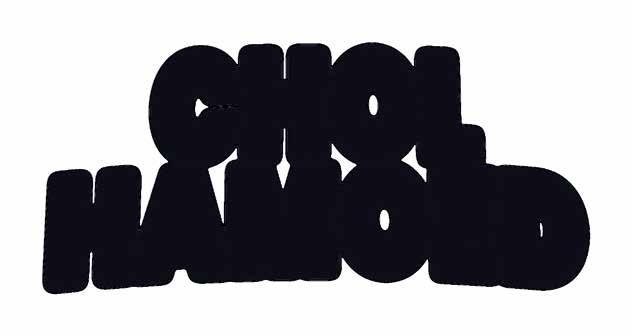





Maple Lanes RVC
100 Maple Ave, Rockville Centre, NY 11570 516-678-3010
Chuck E. Cheese
162 Fulton Avenue, Hempstead, NY 11550 516-483-3166
Kids N Shape
162-26 Cross Bay Boulevard, Howard Beach, NY 11414 866-567-1989
MetroRock Brooklyn
321 Starr Street, Brooklyn, NY 11237 929-500-7625
Area53 Adventure Park
616 Scholes St, Brooklyn, NY 11237 347-305-7448
Thrillz High Flying Adventure Park 5 Prindle Ln, Danbury, CT 06811 203-942-2585
Thrillz High Flying Adventure Park 555 South Henderson Road, King of Prussia, PA 19406 484-235-5555
Flight Adventure Park 1850 Lakeland Avenue, Ronkonkoma, NY 11779 631-619-6000
Trapeze School NY (Circus Academy) 30 Tompkins Ave, Brooklyn, NY 11206 212-242-8769

Trapeze School NY (Circus Academy) 353 West St, New York, NY 10014 212-242-8769
Empire Adventure Park 1500 Old Country Rd, Westbury, NY 11590 516-992-6778
Urban Air
550 Gateway Dr #2, New York, New York 11239 347-732-5438
Urban Air
4422 2nd Ave, Brooklyn, NY 11232 347-732-5438
Urban Air
69 Wesley St, South Hackensack, NJ 07606 201-212-6454
Long Island Adventure Park 75 Colonial Springs Rd, Gate #3, Wheatley Heights, NY 11798 631-983-3844

Skyzone Trampoline Park
33 Lecount Place, New Rochelle, NY 10801 914-740-8272
Skyzone Trampoline Park 111 Rodeo Drive, Deer Park, NY 11717 631-392-2600
Skyzone Trampoline Park 241 Market Street, Yonkers, NY 10710 914-510-9119
Skyzone Trampoline Park

34 Spring Valley Market Place, Spring Valley, NY 10977 845-205-0081
Rockin’ Jump Trampoline
77 Willowbrook Blvd, Wayne, NJ 07470 973-302-3340
Launch Trampoline Park 163-50 Cross Bay Blvd, Howard Beach, NY 11414 718-593-4204
Ferox Ninja Park
72 Noble St, Brooklyn, NY 11222 347-482-1580
DEFY
77 Willowbrook Blvd., Wayne, NJ 07470 973-302-3340
iFLY
10-20 Borden Ave, Long Island City, NY 11101 212-977-4359

iFLY
849 Ridge Hill Blvd, Yonkers, NY 10710
914-449-4359
Topgolf 1013 US-1, Edison, NJ 08817
732-374-4097
Glow Golf
Roosevelt Field Mall, Garden City, NY 11530 516-747-3682
Smith Point Archery
215 E Main Street, Patchogue, NY 11772
631-289-3399
Rise NY
160 West 45th St, New York, NY 10036 718-701-4998
City Climb
30 Hudson Yards, New York, NY 10001 332-204-8500
Dave & Busters
1504 Old Country Road, Westbury, NY 11590 516-542-85011504
Dave & Busters

Northwell Ice Arena
200 Merrick Ave, East Meadow, NY 11554 516-441-0070
Lefrak Center Ice Skating 171 East Drive, Brooklyn, NY 11225 718-462-0010
Big Snow 1 American Dream Way, East Rutherford, NJ 07073 833-263-7326
United Skates of America
1276 Hicksville Rd, Seaford, NY 11783 516-795-5474
WildPlay Jones Beach Ropes Course
2600 Ocean Parkway, Wantagh, NY 11793
800-668-7771
Puppetworks 338 Sixth Avenue, Park Slope, NY 11215 718-965-3391
Build a Bear
4661 Palisades Center Dr, West Nyack, NY 10994 845-353-1555
Lucky Snake Arcade
801 Boardwalk, Atlantic City, NJ 08401 YeshivaMidwinter.com
Beat the Bomb
255 Water St, Brooklyn, NY 11201 917-983-1115
Palisades Center
1000 Palisades Center Dr., West Nyack, NY 10994 845-348-1000
American Dream Mall
1 American Dream Wy, East Rutherford, NJ 07073
Iceland Long Island 3345 Hillside Avenue, New Hyde Park, NY 11040 516-746-1100
City Ice Pavilion
47-32 32 Place, Long Island City, NY 11101 718-706-6667
Long Beach Ice Arena
150 W Bay Dr, Long Beach, NY 11561 516-705-7385

Roosevelt Field Mall 630 Old Country Road, Garden City, NY 11530 516-248-0027
Build a Bear 9015 Queens Blvd, Elmhurst, NY 11373 718-289-7135
Artrageous Studio 5 N Village Ave, Rockville Centre, NY 11570 516-255-5255
Sloomoo Institute: Slime Museum 475 Broadway, New York, NY 10013 Sloomooinstitute.com
Color Factory NYC 251 Spring Street, New York, NY 10013
Once Upon a Dish 659 Franklin Ave, Garden City, NY 11530 516-742-6030
Brooklyn Clay Industries 63 Flushing Avenue, Brooklyn, NY 11205 301-395-0143
Color Me Mine
123 Baxter St, New York, NY 10013 212-374-1710
Color Me Mine
177 Amsterdam Avenue, New York, NY 10023 212-877-0007


La Mano Pottery
110 West 26 Street, New York, NY 10001
212-627-9450
Casa de Spin 81 Grand Avenue, Massapequa, NY 11758 516-654-7746
Taro’s Origami Studio 95 7th Avenue, 2nd Floor, Brooklyn, NY 11215 718-360-5435
Bury the Hatchet 25 Noble Street, Brooklyn, NY 11222 917-243-9696
2BA Pilot Flight Lessons 9100 Republic Airport, Farmingdale, NY 11735 516-662-8887
Classic Harbor Line Sailing

Chelsea Piers, Pier 62, New York, NY North Cove Marina, Battery Park, New York, NY 212-627-1825
The Beast Speedboating W. 42nd Street, New York, NY 10036 212-563-200

Harlem Rocket Sightseeing Boat 125th Street West Harlem Piers, Harlem, NY 10027 917-819-6929
Jamaica Bay Riding Academy 7000 Shore Pkwy, Brooklyn, NY 11234 718-531-8949
Bethpage Equestrian Center 499 Winding Road, Old Bethpage, NY 11804 516-845-1000
New York Equestrian Center 633 Eagle Avenue, West Hempstead, NY 11552 516-486-9673
Intrepid Sea, Air and Space Museum Pier 86, 12th Avenue and 46th Street 212-245-0072
9/11 Memorial and Museum 200 Liberty Street, New York, NY 10006 212-266-5211
Jewish Museum 1109 Fifth Avenue, New York, NY 10128 212-423-3200
Museum of Jewish Heritage 36 Battery Pl, New York, NY 10280 646-437-4202
Living Torah Museum 1603 41 Street, Brooklyn, NY 11218 718-851-3215
Long Island Children’s Museum 11 Davis Avenue, Garden City, NY 11530 516-224-5800
Spyscape
928 8th Avenue, New York, NY 10019 212-549-1941
Museum of Illusions
77 Eighth Avenue, New York, NY 10014 212-645-3230
National Museum of Mathematics 11 East 26 Street, New York, NY 10010 212-542-0566
Museum of Ice Cream
558 Broadway, New York, NY 10012 866-665-1018
Banksy Museum
277 Canal Street, New York, NY 10013



Brooklyn Children’s Museum
145 Brooklyn Avenue, Brooklyn, NY 11213
718-735-4400
Jewish Children’s Museum
792 Eastern Parkway, Brooklyn, NY 11213
718-467-0600
Children’s Museum of Manhattan
212 W 83rd St, New York, NY 10024
212-721-1234
NYC Fire Museum
278 Spring Street, New York, NY 10013
212-691-1303
Cradle of Aviation
Charles Lindbergh Blvd, Garden City, NY 11530 516-572-4111
American Museum of Natural History
Central Park West at 79th Street, New York, NY 10024
212-769-5100
Metropolitan Museum of Art 1000 5th Avenue, New York, NY 10028 800-662-3397
Frick Collection
1 E 70 St., New York, NY 10021
212-288-0700
Lower East Side Tenement Museum
103 Orchard Street, New York, NY 10002
877-975-3786
The Skyscraper Museum
39 Battery Pl, New York, NY 10280 212-945-6324
Citi Field Non-Game Day Tours 41 Seaver Wy, Queens, NY 11368 718-803-4097
Yankee Stadium Tours
1 E 161 Street, Bronx, NY 10451 646-977-8687
Madame Tussaud’s New York
234 W 42 Street, New York, NY 10036 212-512-9600
Vanderbilt Museum & Planetarium
180 Little Neck Road, Centerport, NY 11721
631-854-5579

Liberty Science Center
Liberty State Park, 222 Jersey City Boulevard, Jersey City, NJ 07305 201-200-1000
Crayola Experience
30 Centre Square, Easton, PA 18042 1-866-875-5263
The Franklin Institute 222 North 20th Street, Philadelphia, PA 19103 215-448-1200
Please Touch Museum 4231 Avenue of the Republic, Philadelphia, PA 19131 215-581-3181
Imagine That! Children’s Museum 4 Vreeland Road, Florham Park, N.J. 07932 973-966-8000
TJH assumes no responsibility for the kashrus, atmosphere, safety, or accuracy of any event or attraction listed here. It is suggested to call before heading out. Have a great time!


By MElinda

Makes 1 cup
When I think of a kiddush after shul (synagogue)— where refreshments are served following prayer services on Shabbos and holidays—or of appetizers served with challah at a Shabbos meal, there’s always a dish featuring eggplant. Whether it’s baba ghanoush (smoky eggplant dip), achla (Spanish eggplant dip), melitzanosalata (Greek eggplant dip), or simply roasted eggplant with herbs and oil, eggplant is a staple. It may not always have a specific name, but it brings those Mediterranean flavors I love! This eggplant dish is best served fresh as an appetizer with a sprinkle of fresh herbs but can also be served cold like a salad.
IngredI ents
• 2 pounds (910 g) eggplant (2 to 3 medium eggplants)
• 1 tablespoon kosher salt
• 2 cloves garlic
• ¾ cup (180 ml) extra-virgin olive oil, plus more for garnish
• ½ cup (30 g) fresh parsley, plus more for garnish
• ½ cup (30 g) fresh cilantro, plus more for garnish
• ½ cup (30 g) fresh dill, plus more for garnish
• 1 tablespoon fresh lemon juice
• 1 teaspoon kosher salt
• ¼ teaspoon black pepper
PreParat Ion
1. Preheat the oven to 400°F and line three baking sheets with paper towels.
2. Slice the eggplant into thin rounds, about 1/8-inch (3 mm) thick, then cut into half-moons. Lay them on the prepared baking sheets and sprinkle with the salt. Set aside for the salt to draw out their bitter liquid, about 30 minutes.
3. In a food processor with the knife blade attached, add the garlic, olive oil, parsley, cilantro, dill, lemon juice, salt, and pepper. Process until smooth, scraping down the sides of the processor as needed, about 1 minute.
4. Pat the eggplant dry with paper towels and transfer to a large bowl. Pour the herb puree into the bowl and stir until the eggplant is evenly coated.
5. Line two baking sheets with parchment paper. Spread the eggplant in an even layer. Bake until it is browning around the edges, about 30 minutes. Let cool slightly.
6. If serving warm and fresh, transfer to a serving bowl, drizzle with olive oil, and sprinkle with fresh herbs. To serve at room temperature or chilled, let cool completely, then transfer to a serving dish or an airtight container, drizzle with olive oil, and refrigerate until ready to serve. Serve topped with fresh herbs.
Note: The eggplant can be stored in the refrigerator in an airtight container for 4 to 5 days and the freezer for up to 3 months.

Serves 8 to 10
In my family, we call this Kitchen Sink Soup, because it includes just about everything but the kitchen sink! This hearty oxtail soup, filled to the brim with beef, marrow, vegetables, herbs, barley, split peas, and so much flavor, reminds me of my Savtah Adina, who made this recipe for us whenever she wanted to use up all the vegetables in her refrigerator. The biggest change I made to her recipe was switching from a pressure cooker to a slow cooker. Just mix all the ingredients together in the slow cooker, set it for 10 hours, and walk away until it’s done. If you are unable to get your hands on beef oxtail at your local butcher, short ribs can be used instead.
IngredI ents
• 2 pounds beef oxtail
• 6 marrow bones
• 1 package (16 ounces or 455g) frozen mixed vegetables
• 2 medium carrots, chopped
• 2 medium stalks celery, chopped
• 1 medium parsnip, chopped
• 1 medium turnip, chopped
• 1 medium yellow onion, chopped
• 1 cup chopped fresh parsley
• 1 cup chopped fresh dill
• ½ cup pearl barley
• ½ cup split peas
• 2 tablespoons Onion Soup Mix (see below)
• 2 teaspoons salt
• ½ teaspoon black pepper
• 7 cups (1.7 L) beef stock
PreParat Ion
1. In an 8- to 10-quart (7.5 to 9.5 L) slow cooker, add the oxtail, marrow bones, frozen vegetables, carrots, celery, parsnip, turnip, onion, parsley, dill, barley, split peas, onion soup mix, salt, and pepper. Pour in the beef stock, making sure everything is completely covered. This will pretty much fill up your entire slow cooker to the top. Cover the slow cooker, set it to low, and let it cook for 10 hours.
2. Remove the lid to help the soup cool down. If serving right away, ladle into soup bowls. If not, wait until the soup is completely cool before transferring to a container for storage, about 1 hour.

Makes 1 cup
When I first learned to cook in college, almost every recipe seemed to call for Osem onion soup mix. It was sprinkled on chicken, mixed into broccoli kugel, slathered on potatoes with melted margarine— you get the idea. Then, sometime in my twenties, people started saying onion soup mix was too high in sodium and not healthy, so many of us stopped using it. But onion soup mix deserves all the love – it makes everything taste better! I won’t stop you from using the storebought version, but this homemade mix is what I use throughout this cookbook, and it even adds a delicious touch to my chicken soup.
IngredI ents
• 1 cup (55 g) dried onion flakes
• 2 tablespoons onion powder
• 2 teaspoons kosher salt
• 2 teaspoons parsley flakes
• 2 teaspoons garlic powder
• 1 teaspoon sweet paprika
• ½ teaspoon black pepper
PreParat Ion
In an 8-ounce (240 ml) glass jar with a lid, add the onion flakes, onion powder, salt, parsley flakes, garlic powder, paprika, and pepper. Seal with the lid and shake to combine.
Note: The soup can be stored in the refrigerator in an airtight container for 3 to 4 days and in the freezer for up to 6 months.
Note: The soup mix can be stored in an airtight container at room temperature for up to 6 months.

Serves 6 to 8
This sweet, soufflé-like kugel, with hints of vanilla and cinnamon, feels almost like a dessert but shines as an incredible, sweet side dish. Naturally gluten-free thanks to its crustless base, it can be made with or without dairy to suit any meal. And yes, you could absolutely top it with marshmallows and serve it alongside your Thanksgiving feast—it’s as versatile as it is delicious!
IngredI ents
• ½ cup (60 g) all-purpose flour
• ¼ teaspoon kosher salt
• 24 ounces (680 g) canned or defrosted frozen butternut squash puree
• 3 large eggs
• 1 cup (240 ml) milk or non-dairy milk
• ½ cup (100 g) granulated sugar
• 1 teaspoon vanilla extract
• 1 teaspoon ground cinnamon
PreParat Ion
1. Preheat the oven to 375°F and grease a 9-inch (23 cm) square or round baking dish.
2. In a large bowl, add the flour and salt and whisk to combine.
3. In another large bowl, add the squash, eggs, milk, sugar, and vanilla and whisk until smooth. Add the egg mixture to the flour and whisk until the flour is fully incorporated and a smooth batter is formed.
4. Add the mixture to the prepared baking dish, using a rubber spatula to scrape it from the bowl and smooth it out into an even layer. Sprinkle the cinnamon evenly over the top.
5. Bake until the top is slightly browned and the center is set but still slightly jiggly, similar to the texture of a cheesecake, 45 to 50 minutes. Let cool slightly, about 10 minutes.
6. Serve family style in the dish.
Note: The kugel can be stored in the refrigerator in an airtight container for 3 to 4 days and in the freezer for up to 3 months.




Serves 8 to 10
This probably isn’t the kind of borscht you normally think of, which is usually made with beets in the broth and a dollop of sour cream on top. My Savtah Adina, whose mother’s family came from Poland, always made this sweet-and sour cabbage soup, and it’s one of my favorites to this day. Every year during the fall, I fly to Seattle during the Jewish holiday of Sukkot, and we sit in the sukkah layered up in our puffy warm coats filling up on cabbage borscht before even serving the main course. It’s tradition! And hey, if you don’t feel like shredding your own cabbage, a bag of pre-shredded cabbage works, too.
IngredIents
• 3 pounds (1.4 kg) short ribs or flanken, cut into 2-inch (5 cm) cubes
• 3 teaspoons kosher salt, divided
• ½ teaspoon black pepper
• 2 tablespoons neutral oil
• 1 large yellow onion, diced
• 1 bottle (46 ounces, or 1.3 L) tomato juice
• 1 can (28 ounces, or 800 g) crushed tomatoes
• ½ cup (100 g) granulated sugar or pure maple syrup
• 2 tablespoons fresh lemon juice
• 1 large green cabbage, shredded
PreParatIon
1. Pat the meat dry with paper towels and season it with 2 teaspoons of the salt and the pepper.
2. In a large, heavy-bottomed pot with a lid, heat the oil over medium-high heat until it shimmers, about 2 minutes. Working in batches, add the meat, making sure not to overcrowd the pot, and sear on all sides, about 5 minutes per batch. Using tongs or a slotted spoon, transfer the seared meat to a plate.
3. Reduce the heat to medium, add the onions, and cook, stirring occasionally, until translucent and beginning to brown around the edges, about 5 minutes. Add the tomato juice, crushed to-
matoes, sugar, lemon juice, the remaining 1 teaspoon salt, and 1 cup (240 ml) of water. Stir until the browned bits are loosened from the bottom of the pot. Bring to a boil over medium-high heat.
4. Return the meat to the pot. Add the cabbage and stir to mix it all in. Reduce the heat to low, cover the pot, and simmer until the meat is fork-tender, about 2 hours.
5. Ladle into soup bowls, making sure each bowl has 2 or 3 pieces of meat, and serve.

Note: The borscht can be stored in the refrigerator in an airtight container for 3 to 4 days and in the freezer for up to 6 months.
Text and images excerpted with permission from Eat Jewish by Melinda Strauss, published by Rock Point, (c)2025.


By Bassy Schwartz, LMFT

This time of year, the theme of “newness” is everywhere—new year, new me. Renewal, rejuvenation, and reset are powerful, but I’ve found that some of the most transformative changes don’t come from what we start—they come from what we end.
Letting go of things that aren’t serving us—old habits, draining relationships, patterns that no longer fit—can be even more powerful than trying to add something new. So much of what holds us back works quietly in the background, sucking our energy without us even realizing it. Saying yes when we really want to say no, giving more than we have to give, sticking around with people or circumstances that take more than they give…these things weigh us down, even if we don’t calculate it consciously.
A lot of this is conditioning—our brains are trained by what we’ve experienced. Many of us grew up in households, schools, or communities shaped by people who were themselves struggling, traumatized, or doing their best in hard circumstances. We carry those molds into adulthood, often without realizing it, and it can shape our choices, our relationships, even how we see ourselves.
Some of my biggest personal “aha” moments came the second I decided I could no longer dilute myself for the sake of someone or something else. I’ve started to view many parts of myself and my life as optional, noticing that I had gotten used to standards and assumptions that didn’t need to exist. Seeing why those circumstances weren’t serving me anymore, and then finding alternatives that actually aligned with my inner needs and values, has been the ultimate liberation. This is good therapy at work, and it’s my greatest privilege in life to partake in this work and share it with my clients.
With every year that passes, I get clearer on who I am, what my values are, and what truly feels right. I may say “no” more than ever, but I also feel more fulfilled and aligned with my true self than ever. I am grateful to G-d for the therapeutic process and for every opportunity to grow and discover more of myself.
So as we step into this new year, instead of just asking what new habit we want to start, we need to be asking: What do I need to stop? What deserves a “no” so that I can live a year full of real “yeses” and abundance?
Here are ten things to let go of this
year, to curate a year of “yes!”:
1. Dismissing Your Inner Voice
We all have an internal compass, but many of us have been taught to ignore it. Maybe you were told you’re “too sensitive” or that your instincts were “wrong.” Over time, this trains you to doubt yourself. But ignoring that voice leaves you disconnected and vulnerable to making choices that don’t fit who you are. Learning to pause, listen, and honor your gut feelings is not indulgent—it’s wisdom.
2. Saying Yes Because You “Feel Bad”
Compassion is a gift, but when guilt dictates your choices, you pay the price. Saying yes from guilt often leads to resentment, burnout, and inauthentic relationships. A “no” offered with honesty and respect is far kinder than a “yes” that depletes you. It leaves room for you to say “yes” to what truly matters to you.
3. Offering What You Don’t Have to Give
We live in a culture that glorifies self-sacrifice—giving until we’re empty. But time, money, emotional energy, even physical help—these are finite resources. When you give what you don’t actually have, it doesn’t make you generous; it makes you depleted. True giving
comes from intention and resource, not deficit. Boundaries protect not just you but also the quality of what you are able to give.
4. Assuming That a Long-Lasting or Biological Relationship Is Automatically the Right Relationship
We value family and history, but longevity and blood don’t automatically equal a healthy relationship. Some of the most painful patterns I’ve seen come across my desk come from relationships people felt obligated to maintain even when those dynamics were harmful. It takes courage to admit that not every relationship is meant to be central in your life. Sometimes love means closeness, and sometimes love means distance (even if it’s only for the sake of self-love).
5. Diluting Your Accomplishments
How many times have you downplayed your successes so you wouldn’t seem “arrogant”? Or so someone else wouldn’t feel small? While humility is important, self-erasure serves no one. Your achievements are not meant to be hidden; they are evidence of your hard work and G-d-given abilities. Owning your light gives others permission to shine, too. And boy, do I want to live in

a world where there’s enough space for each of us to shine.
6. Pouring More Energy Into Your Outer World Than Your Inner World
It’s easy to curate the version of yourself you present to the public: the polished parent, the successful professional, the perfect hostess. But what about your private, inner world—your relationship with yourself, your closest loved ones, with G-d? Investing in your inner life pays dividends that no social approval can match. A beautiful exterior means little without inner peace.
7. Viewing Life as a Checklist
Marriage, career, children, house, schools—it’s tempting to measure life by milestones. But when life becomes a checklist, you risk losing sight of meaning and depth. Alignment with your inner truth is what brings fulfillment, not simply ticking the next box. Sometimes, alignment means slowing down or even redefining what success looks like.
8. Confusing Vulnerability With Over-Compensation
Real vulnerability is sacred—it’s not a performance or a way to earn approval. Oversharing in order to prove your
“realness” is not the same as authentic openness. Vulnerability should be reserved for those who have earned your trust. It is a privilege for others to have a lens into your heart, not a transaction to make them like you more.
9. Glossing Over Your Own Feelings Because “Someone Has It Worse”
We all know someone who is strug-
matter. Honoring them is the first step toward growth.
10. Going With the Crowd Out of Fear
I’ll die on this hill: none of us actually know what we’re doing—and that’s okay. We’re social beings, and it can feel isolating to stand apart. But the reality is, everyone is experimenting and figuring things out at their own pace. Just
Letting go of things that aren’t serving us— old habits, draining relationships, patterns that no longer fit—can be even more powerful than trying to add something new.
gling more than we are. But comparing pain invalidates your reality. If you dismiss your sadness, anger, or fear because it doesn’t seem “big enough,” you rob yourself of the option to heal. Your feelings matter simply because you

This year, let’s focus not just on what we want to start, but on what we’re ready to release. Every intentional “no” we give clears space for a more authentic, vibrant “yes.” Saying no to what drains us makes room for what truly matters—our peace, our growth, our joy. Let’s step into this year with courage, clarity, and a commitment to ourselves, and watch how our lives transform when we honor our needs and values first.
because a choice is popular doesn’t mean it’s right for you. G-d is the only One who sees the full picture. Trusting what fills your cup, meets your needs, and aligns with your values is both terrifying and freeing.
Bassy, a licensed Marriage and Family Therapist, trained in Emotionally Focused Therapy, brings a compassionate and unique approach to her practice focusing on couples and individuals dealing with conflict and disconnection due to childhood emotional neglect and complex family dynamics. Bassy empowers clients to harness their inner strength and authentic selves to achieve meaningful relationships beyond what they could have ever imagined. Reach her directly at bassy@corerelationships. com or WhatsApp (347) 309-5362.



By Mordechai Schmutter
From time to time, I run a yom tov article that is really not written for you , apparently – it’s just a way of recording my family’s apparent minhagim. Minhagim are treasured traditions, handed down from generation to generation as a way of keeping our mesorah alive, but the problem is that for the most part, handing things down in this way is like playing a game of telephone, where, over the years, some customs get added, muddled, or taken out.
That said, it’s always a good idea to write down your family’s customs somewhere so your grandkids know, going forward, whether your kids ever actually paid attention when you talked.
- Although I spell it Sukkos, I have a
minhag to pronounce it Sukiss. I also say Shvooiss and Shabbiss
- I have a minhag to keep our sukkah in the garage,but our decorations in the attic.
- I have a minhag, after we finish putting up the sukkah every year, to go inside the house, go upstairs, and look out the window.
- We have a minhag to hang lots of decorations that are supposed to make our sukkah look nice but instead make it look like an ad for saran wrap. Pesach is the holiday of foil; Sukkos is the holiday of saran wrap.
- I have a minhag to put up the sukkah on a Sunday. And to panic every year about how few Sundays are left. This is despite the fact that I mostly

work from home every day of the week. But I do want my kids available so they can help me by bringing out a few of the poles and asking me if they’re getting rewarded.
- When I’m putting up the schach mat, I have a minhag to get splinters.

- My kids have a minhag to hand me the schach poles one at a time, perpendicular to the direction I need them in.
- We have a minhag to hang a picture of a sukkah in our sukkah. And in that sukkah, there is also a picture of a sukkah. I wonder if we’re just part of someone’s picture.
- My father has a minhag, when looking at esrogim, to ask if they have anything else in the back.
- I have a minhag to spend 13 minutes frowning knowledgeably at esrogim before settling on the second one I looked at.
- I have a minhag to buy my hadassim in a bag so that I can’t see them until I get home, but I don’t buy my esrog and lulav in a bag.
- I have a minhag to put my hadassim and aravos in the fridge, like they did in the midbar.
- My aravos have a minhag to start turning brown the moment I pay for them.
- We have a minhag to zip our sukkah door closed when everyone leaves it, even though animals can go right under the tarp anyway and people know how to use zippers. Even burglars. I don’t know what burglar is going to be stumped by a zipper, but I guess one who wants to steal folding chairs.
- My mother-in-law has a minhag, handed down from her ancestors, that the first night of Sukkos, she comes out to the sukkah in a coat. It doesn’t matter how hot it is, or how hot it was when
she was outside five minutes before yom tov.
- I have a minhag to make weak excuses as to why I can’t sleep in the sukkah.
- I have a minhag to serve soup on Sukkos, so we can see if the rain ruins it. We have this soup even if it’s 90 degrees out and my mother-in-law is wearing a coat.
- We have a minhag to pop in to look at other people’s sukkahs, even though I don’t know what we’re looking for. Are we seeing if they’re kosher? Are we looking at their decorations? I don’t come to their houses to look at their decorations.
- My kids have a minhag to say that d’var Torah about how the samech of “sukkah” has four walls and the kaf has three and the hey has two-and-a-half, even though no one in history has ever built a two-and-a-half-wall sukkah that looks like a hey. How does that little half-wall stay up? Why do you need a doorway if you’re already missing a wall? What are you, Avraham Avinu? And yeah, it could be that the letters are just a mnemonic device. So what’s the mnemonic device to remind you not to incorporate the vav into this d’var Torah?
- We have a minhag to turn on our neighbor’s motion-sensitive backyard light at least once over the course of yom tov.
- The non-Jewish neighbors behind me have a minhag to do construction 3 feet from our sukkah while we’re trying to eat. Drilling, hammering, sawing, the works. Especially when we try to sing. If there is nothing for them to build, they have a minhag to mow their lawn.
- My wife has a minhag to urge me to sing over the construction. Like the neighbors are going to say, “Ooh, that’s some nice singing. Let’s stop drilling and listen.” I think this might be why

they’re doing construction.
- I have a minhag to tell my kids every time they pick up the arbah minim to watch the pitum. Even my teenagers.
- My kids have a minhag, while they’re watching the pitum, to bump the tip of the lulav into random walls and fellow mispallelim.
- I have a minhag, if my esrog is not perfectly straight, to hold it at an angle so that it looks perfectly straight to me. I’m the one who paid for it.
- I have a minhag to lose the kesher that goes around my lulav holder on the first day of Sukkos.
- Everyone in my shul has a minhag, during Hoshanos, to totally forget how to walk.
- I have a minhag to always end Hoshanos on the exact opposite side of the shul from where I need to be.
- I have a minhag to forget to say the Ushpizin of Yaakov Avinu.
- We have a minhag to go out to eat on Chol Hamoed to a restaurant with a sukkah in middle of the street, so that we can literally feel the cars passing by.
- I have a minhag to forget to make the bracha of Leishev Ba’sukkah several times over the course of yom tov, even though I made it a point to go out to
the sukkah, bringing everything I need with me, over the course of several trips, and now I am in a sukkah surrounded by signs about Sukkos, and I still forget to say Leishev Basukkah.
- I have a minhag, on Chol Hamoed, to eat yogurt and hard-boiled eggs at
way I can say, “Yeah, well, I also wore my tefillin on the wrong hand.”
- I have a minhag not to knock any leaves off my Hoshanos, but not for lack of trying.
- My wife has a minhag to attempt to grow aravos every year, usually in a
My father has a minhag, when looking at esrogim, to ask if they have anything else in the back.
the zoo. Because we don’t see enough wildlife in our Sukkah. (NOTE: This minhag extends to Chol Hamoed Pesach as well.)
- We have a minhag, at some point over Chol Hamoed, to say, “It always rains on Chol Hamoed.”
- Our minhag is not to wear tefillin on Chol Hamoed, though I kind of wish I would, because I’m a lefty, and people stare at me and say, “Hey, you’re holding your lulav in the wrong hand!” And that

place that we will hopefully remember not to mow them come spring.
- My shul has a minhag on Simchas Torah to sing the very same songs that our forefathers sang the very first time they finished the Torah.
- I have a minhag to pick up Simchas Torah flags for my kids at the supermarket for free, and I don’t know why. No kid uses them. Are they going to hold yet another stick that they can use to poke adults while walking in a circle?
- When I was growing, up, a lot of shuls seemed to have a minhag to play pranks on the chazzan during Mussaf on Simchas Torah. How on earth was that okay? The poor guy had yahrtzeit.
- I have a minhag to sit down the day after yom tov with my kids’ school papers and realize that I forgot to record how many seconds each kid learned each day, especially since, for several of those days in a row, I couldn’t write.
- I have a minhag to be at a total loss as to what to do with my esrogim after Sukkos. We just have a box of tiny brown rocks that smell good that I don’t want to show my kids because they’re just going to break off the pitums.
- I’m thinking of starting a minhag to buy flowers for my wife before Sukkos. That way, she’ll do whatever chemical process she usually does to keep them alive for a week, and I can sneak my aravos in there every night.
Mordechai Schmutter is a freelance writer and a humor columnist for Hamodia and other magazines. He has also published eight books and does stand-up comedy. He can be contacted at mschmutter@gmail.com.


